Catamaran vs Monohull in Rough Seas: Which is Better?
Catamarans and monohulls have different designs that affect how they handle rough sea conditions. In fact, they have an advantage over each other when sailing in heavy seas. Let's try to compare each type of vessel based on their performance, design, and stability, to help you decide which can give you a safer and more comfortable journey on the open water.
Regarding speed, efficiency, and stability, a catamaran may be the better option for you. Because they have twin hulls, they are more comfortable to sail in rough seas. A monohull can become more advantageous in rough seas when sailing upwind since it can point higher into the wind and can handle strong winds easily.
Catamarans with two rudders also allow for better control and maneuverability in rough seas compared to monohulls, which only have one rudder. Let's look at more of the comparison between these two types of boats when sailing through big waves in the sea.
- When it comes to stability and comfort, catamarans can provide more stability. They are also less likely to cause seasickness and offer more living space and privacy.
- In terms of speed, catamarans are also faster than monohulls because they have a smaller displacement. Their structure also makes them less likely to capsize or sink.
- A monohull is advantageous when it comes to sailing upwind, and handling stronger winds. Their deep keel also provides them with increased stability and reduces drag, which can be an advantage in rough seas.


Catamarans Vs. Monohulls in Rough Seas
If you're planning to buy a boat, and you're deciding whether to go for a catamaran or a monohull, one of the many things you may need to consider is how they perform in rough seas. Rough seas can be challenging for any vessel, but some boats are better equipped to handle them than others. Below is a table summarizing how well these boats perform in rough seas:
A catamaran is a boat with two hulls connected by a deck. Because they have two hulls , catamarans are known for their speed, stability, and spaciousness. They are often used for cruising and chartering, as well as racing. They also have a wider beam than monohulls, which means they offer more living space and stability. They are less likely to heel or tilt to one side, are more buoyant, and have a shallow draft.
On the other hand, monohulls are the most common type of boat with only one hull. They are known for their simplicity, versatility, and affordability. Monohulls are often used for day sailing, racing, and cruising.
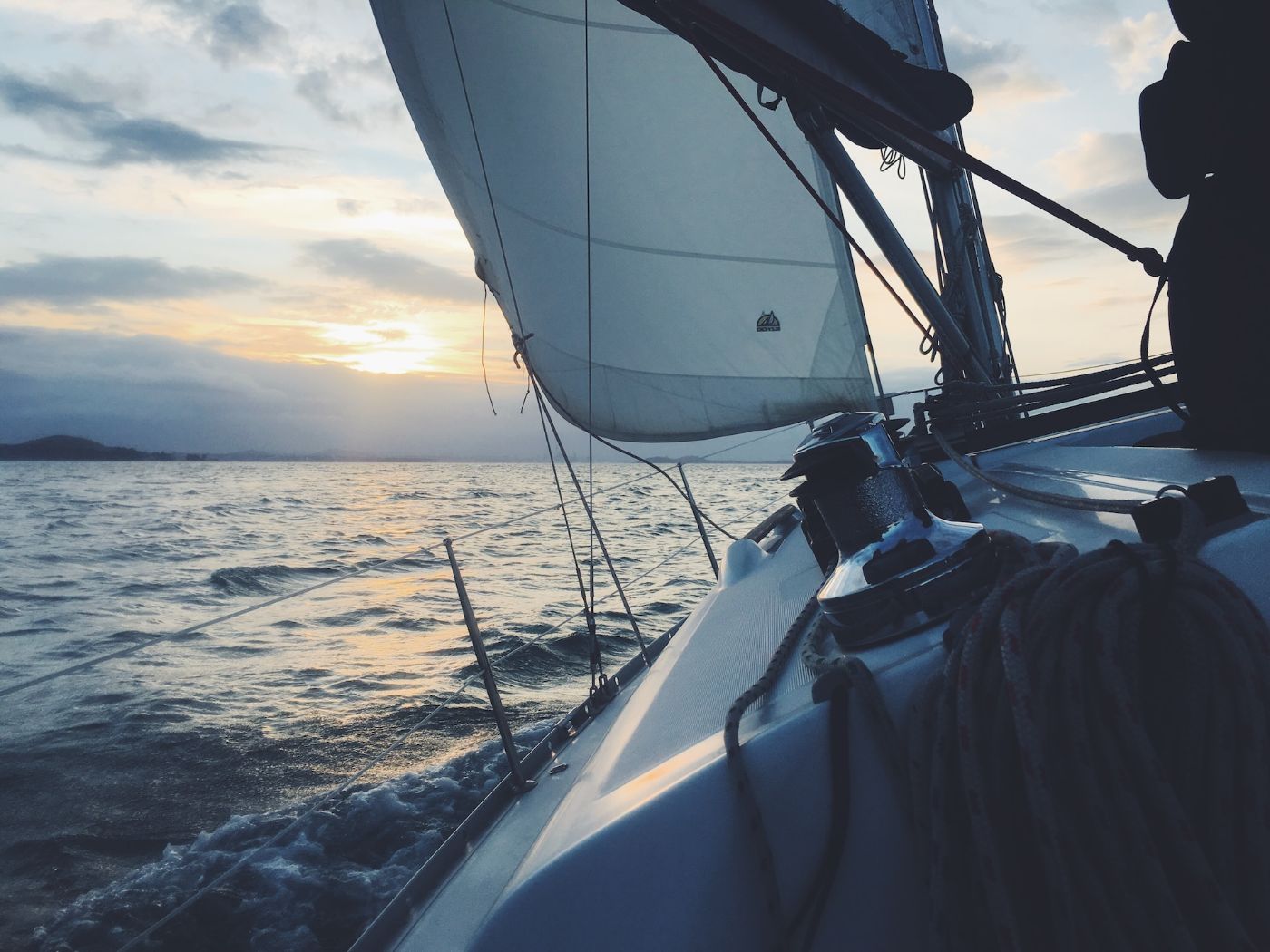
When it comes to rough seas, catamarans are generally more stable than monohulls in terms of roll stability. Monohulls, on the other hand, are better at handling heavy seas and high winds, but they can be more prone to rolling and pitching, and can significantly heel more than a catamaran.
If you are aiming for speed, efficiency, and stability, then a catamaran may be the better option for you. They are generally faster and more efficient due to their twin hulls, and their stability can make for a more comfortable ride in rough seas.
On the other hand, if you prioritize upwind sailing performance, sailing feels and responsiveness, and the traditional look and feel of a sailboat, then a monohull may be the better option for you. Monohulls sail closer to the wind and have a unique feel to them that some sailors prefer.
Detailed Comparison Between Catamaran And Monohull
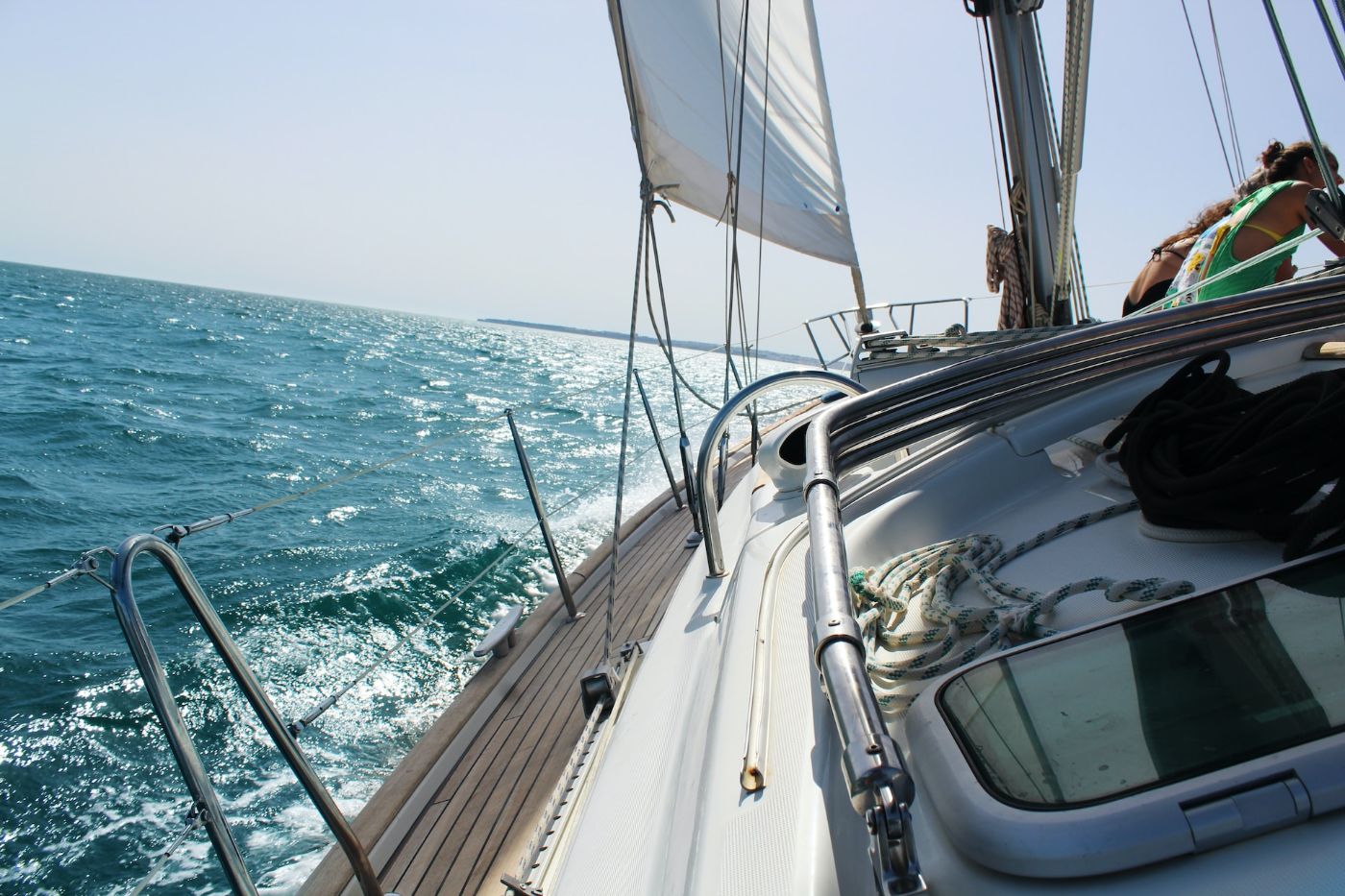
Catamarans provide better stability and comfort
Catamarans are more stable, less likely to cause seasickness and offer more living space and privacy. Below is a table summarizing why catamaran is more advantageous in this category:
In terms of motion in rough seas
Catamarans are more stable in rough seas because they have two hulls instead of one. This means that they are less likely to roll or heel, which can make for a more comfortable ride. Monohulls, on the other hand, tend to pitch and roll more in rough seas.
In terms of handling seasickness
If you are prone to seasickness, a catamaran may be a better choice for you. The stability of a catamaran means that it is less likely to cause seasickness than a monohull. Additionally, the living space on a catamaran is often spread out between the two hulls, which can help to reduce the feeling of confinement that can contribute to seasickness.
In terms of living space and privacy
Catamarans also tend to offer more living space and privacy than monohulls. Because the living space is spread out between the two hulls, each hull can function as a separate living space. This can be especially beneficial if you are traveling with a group of people and want to have some privacy.
Both boat types have specific advantages in performance and speed
A catamaran is generally faster and more stable than a monohull, but a monohull can be easier to handle in certain conditions.
In terms of navigating upwind
When sailing upwind, a monohull has the advantage over a catamaran due to its ability to point higher into the wind. This means that a monohull can sail closer to the wind than a catamaran, which will need to tack more often. However, a catamaran can make up for this disadvantage with its speed. A catamaran can sail faster than a monohull , which can help it to cover more distance in less time.
In terms of handling strong winds
In strong winds, a catamaran is generally more stable than a monohull due to its wider beam. This means that a catamaran is less likely to heel over, making it more comfortable for passengers. However, a monohull can be easier to handle in strong winds due to its ability to reef the sails. By reducing the sail area, a monohull can reduce the amount of wind it catches, making it easier to control.
Catamarans and monohulls have different designs and function
Catamarans offer more deck and cabin space, shallow draft, and increased buoyancy, while monohulls have a deeper draft, reduced drag, and increased stability.
In terms of the deck and cabin space
One of the advantages of catamarans over monohulls is their wider beam, which provides more deck space. This means more room to move around and increased stability, which is important in rough seas.
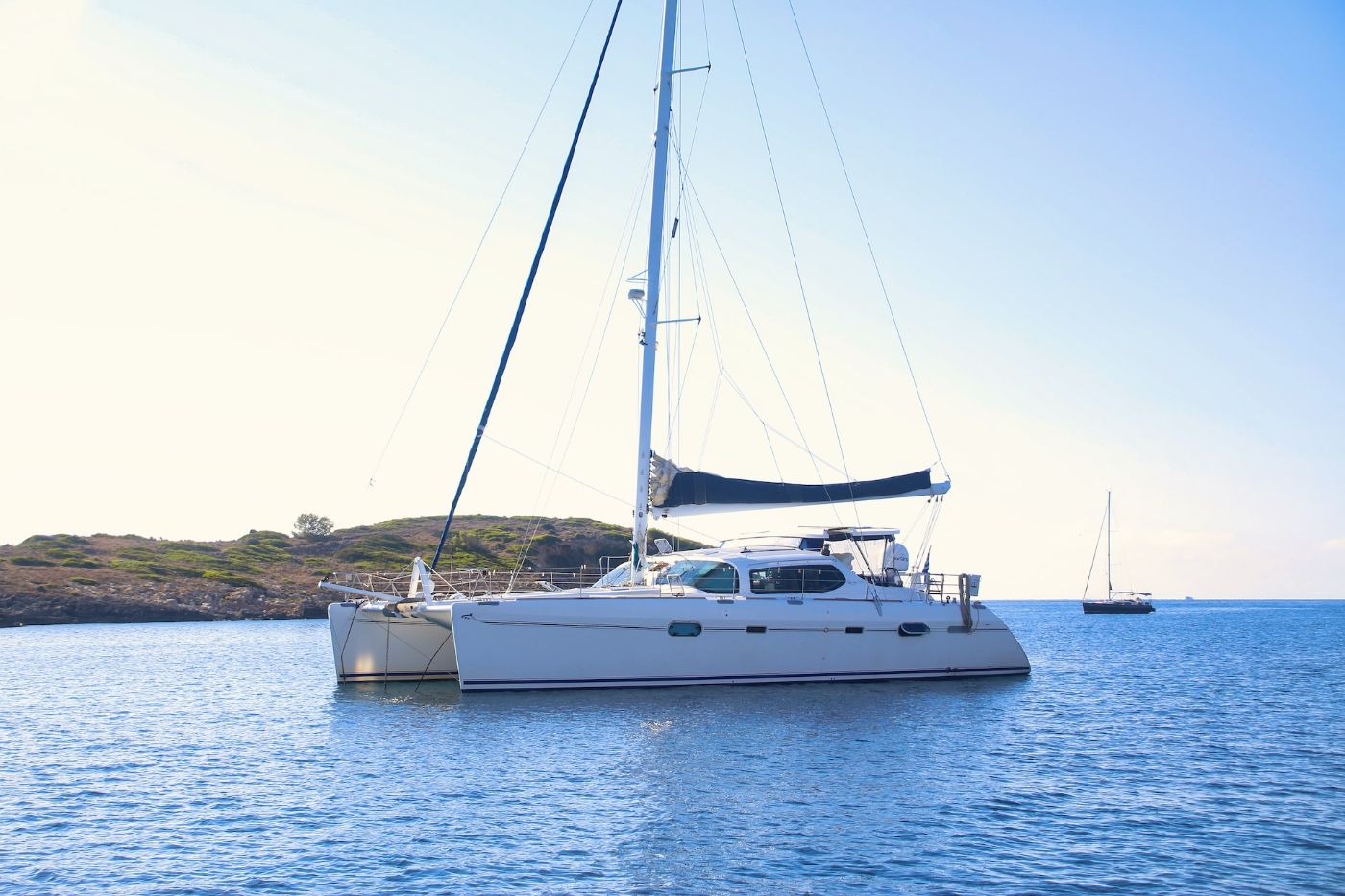
Additionally, catamarans usually have two hulls, which means more cabin space and privacy for the crew and passengers. On the other hand, monohulls have a single hull, which means less deck and cabin space. However, monohulls usually have a deeper draft, which allows them to sail closer to the wind and tack more efficiently.
In terms of draft and buoyancy
Catamarans have a shallow draft, which means they can sail in shallow waters and anchor closer to shore. This makes them ideal for exploring shallow coves and bays. Also, catamarans have two hulls, which provide increased buoyancy and stability in rough seas.
Monohulls, on the other hand, have a deeper draft, which makes them less suitable for shallow waters. However, their deep keel provides increased stability and reduces drag , which can be an advantage in rough seas.
Both boat types have unique safety considerations
Safety is a top priority when sailing in rough seas. Catamarans are generally more stable and easier to control, while monohulls have a greater risk of capsizing but are also more maneuverable in certain situations.
In terms of the risk of capsizing
One of the biggest safety concerns when sailing in rough seas is the risk of capsizing. Catamarans have two hulls, which make them more stable than monohulls. This means that they are less likely to capsize in rough seas. Catamarans are also technically unsinkable , meaning that they will not sink even if one hull is damaged or flooded.
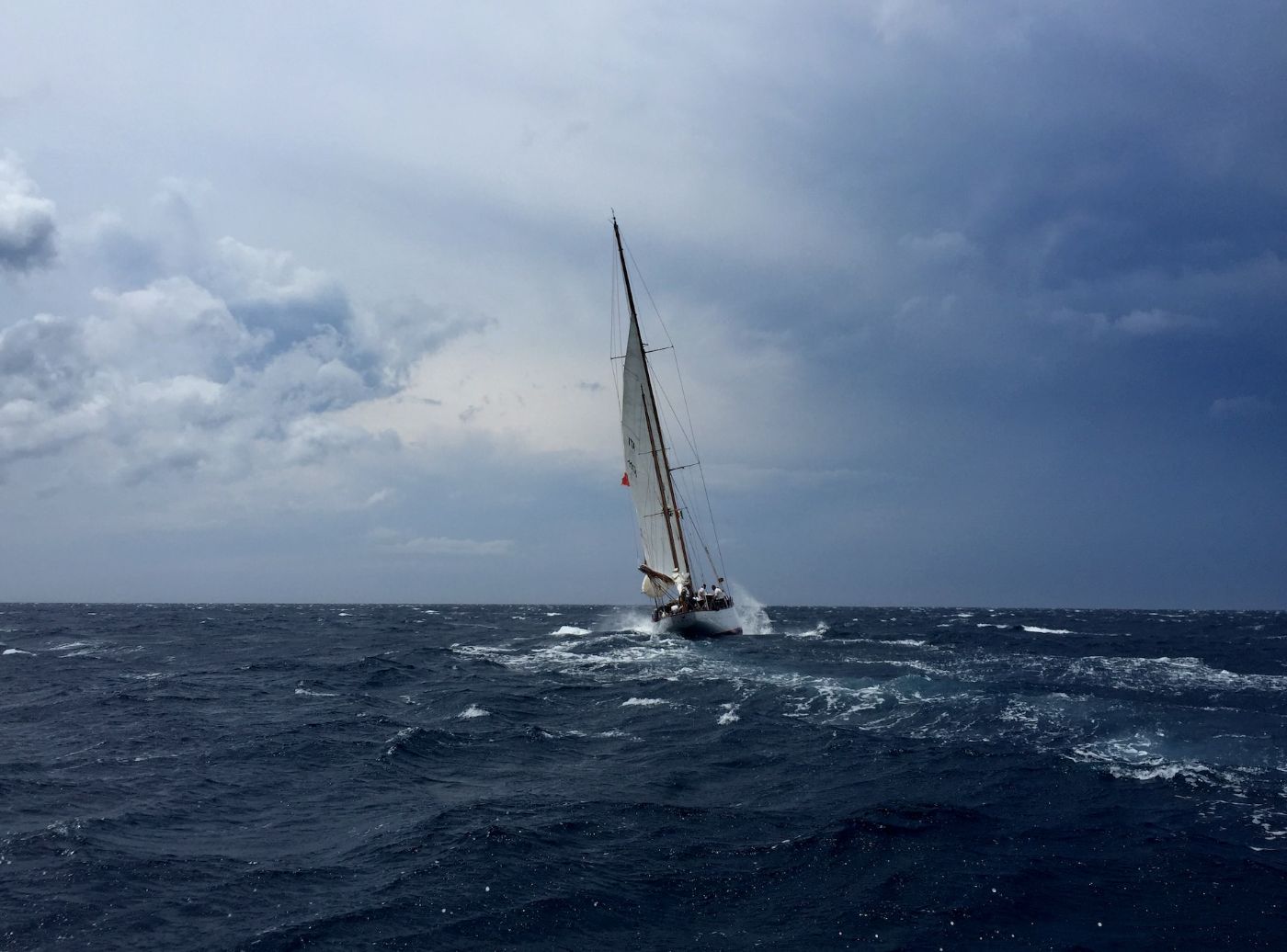
On the other hand, monohulls have a keel and ballast, which provide stability but also increase the risk of capsizing. If a monohull capsizes, it can be difficult to right the boat and prevent it from sinking.
In terms of navigational control
Catamarans have two rudders, which provide additional control and maneuverability in rough seas. This means that you can steer the boat more easily and avoid obstacles like rocks and other boats. Meanwhile, a monohull only has one rudder.
However, despite the number of rudders involved, the ability to control and maneuver the boat, whether a catamaran or a monohull, still depends on the design and construction of the boat, as well as the skill of the captain and crew in handling the boat.
Other practical considerations when choosing between catamaran and monohull
In terms of docking and anchorage.
Docking and anchorage can be easier with a catamaran due to the wider beam, which provides more stability. However, catamarans can be more difficult to maneuver in tight spaces due to their size. On the other hand, monohulls are generally easier to maneuver in tight spaces, but they may be less stable in rough seas.
For docking costs, catamarans tend to have higher docking rate costs due to their size and wider beam. Read this article to know more about the costs of docking a catamaran in different locations.
In terms of storage and equipment
Catamarans typically have more storage space than monohulls due to their wider beam and larger deck area. This means they can carry more gear and supplies, making them a good choice for longer voyages or liveaboard situations. They can accommodate larger equipment such as dinghies, kayaks, and paddleboards - making them a great choice for water sports enthusiasts who want to bring their gear along.
Monohulls, on the other hand, have less storage space due to their narrower beam and smaller deck area. This means they are better suited for shorter trips or day sailing, where less gear and supplies are needed. Monohulls may also be better suited for certain types of equipment, such as fishing gear or diving equipment, due to the layout of the boat.
In terms of crew accommodations
Catamarans tend to have more spacious accommodations than monohulls, which can be an advantage for longer trips or when traveling with a larger crew. However, monohulls may offer more privacy for individual crew members due to the separate cabins and tighter quarters.
Catamarans generally have more living space than monohulls so they can offer more room for sleeping, lounging, and cooking, which can be especially beneficial for larger crews or families. They also often have large, open salons and cockpits that allow for easy socializing and entertaining. This can be a great feature for crews who enjoy spending time together.
Monohulls, on the other hand, have less living space than catamarans due to their narrower beam. This means they may be better suited for smaller crews or shorter trips. They often have cabins located closer together, which can make it easier to communicate and work together as a crew, which is a plus for racing or cruising in crowded areas.
Choosing boat type based on personal preferences
In terms of aesthetics and personal taste.
One of the first things that come to mind when choosing between a catamaran and a monohull is aesthetics. Both types of boats have their unique look, and it is up to personal preference which one you find more appealing. Some people prefer the sleek and modern look of a catamaran, while others prefer the classic look of a monohull.
Another thing to consider is personal taste. If you are someone who prefers a more spacious and open boat, then a catamaran might be the right choice for you. On the other hand, if you prefer a more traditional sailing experience, then a monohull might be the better option.
In terms of suitability for families and couples
Basically, catamarans are known for their stability and spaciousness, making them a great choice for families with children or couples who want to have more space and privacy.
Monohulls, on the other hand, might not be as spacious as catamarans, but they offer a more traditional sailing experience. If you are a couple or a small family who wants to experience the thrill of sailing and doesn't mind being in close quarters, then a monohull might be the right choice for you.
Leave a comment
You may also like, cost of catamaran vs. monohull: which is more expensive.
The market for monohull sailboats is a lot bigger than that of catamarans, which is one of the reasons why they are so much cheaper.
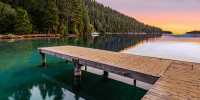
How Much Does It Cost to Dock a Catamaran? (7 Locations)
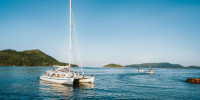
The Perfect Size Catamaran to Sail Around the World

17 Sailboat Types Explained: How To Recognize Them
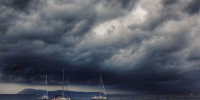
What Type of Hull Handles Rough Water the Best?
Own your first boat within a year on any budget.
A sailboat doesn't have to be expensive if you know what you're doing. If you want to learn how to make your sailing dream reality within a year, leave your email and I'll send you free updates . I don't like spam - I will only send helpful content.
Ready to Own Your First Boat?
Just tell us the best email address to send your tips to:

Catamaran and Monohull Compared: Which is Better, Faster, Safier, and More Stable in Rought Sea?
Catamarans and monohulls are two vessels that have distinct features from each other. Catamarans have two hulls connected by a bridge structure whereas, as the name suggests monohulls have a single hull.
Both types of vessels have different features in terms of both aesthetics and function, let’s get into the details to find out more.
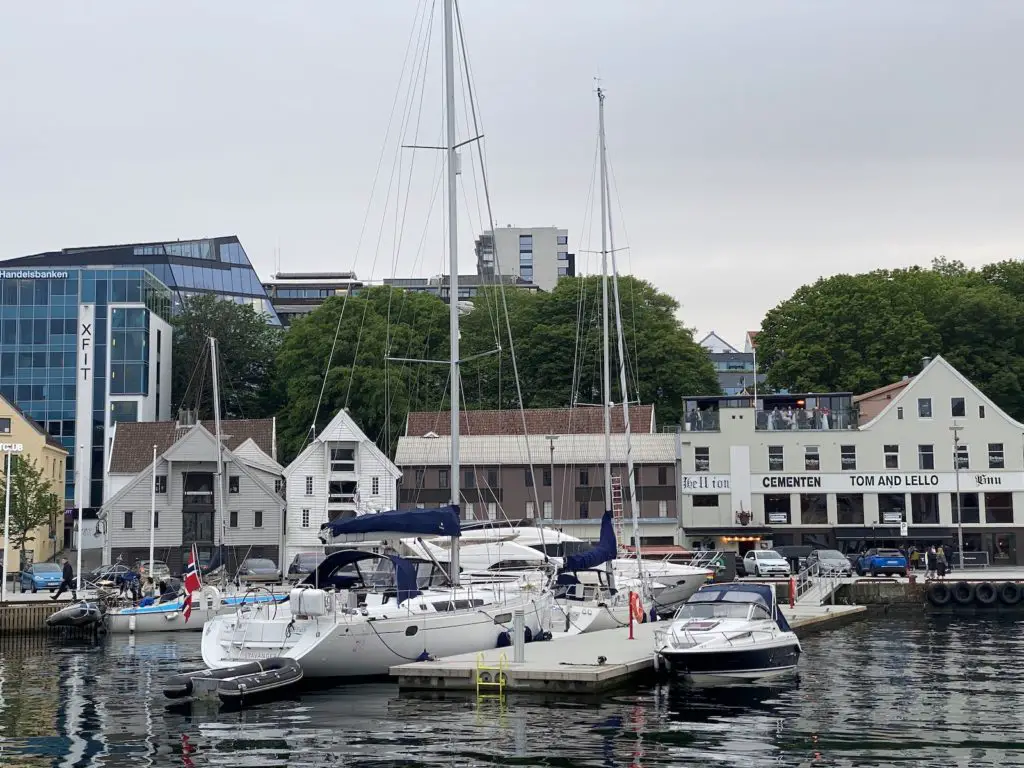
Do Catamarans Have More Space?
Since catamarans have two hulls, they are normally wider than monohulls. This gives the designers and owners the flexibility to maximize the space requirements in terms of space and function.
Vessels can be designed for either commercial or recreational uses. The additional space can serve as an advantage in both fields. In terms of recreational vessels such as yachts, the accommodation can be split up between the two hulls and can be well designed in such a manner that separate spaces can be allotted for the owner, guest, and crews with separate passages such that the path between the primary guests and the crew don’t collide.
In terms of interiors, the huge space addition can give the owners much more flexibility in choosing furniture without size restrictions and more space for additional appliances such as washers, dryers and so on which can make life on board much easier.
The deck can also house more people without the feeling of being enclosed in a closed space and for this reason, catamarans are normally used as party boats with wider deck space and more space to move around.
In terms of storage, catamarans have better storage options than monohulls as both the hulls can be utilized for different functions which not only increases the overall capacity of storage in terms of fuel , fresh water , cargo, and so on but also gives the designer an option to segregate the storage areas for different uses.
Catamarans are also now a growing trend in the fishing industry as the wide decks provide more area for the fisherman to move around without any obstructions making fishing much easier also, catamarans tend to roll less which stabilizes the vessel better than monohulls, giving more stable conditions for fishing without the risk of going aboard.
Due to the wider proportions, the spaces can also be designed in such a way so as to house tenders, jet-skis, and so on, on either of the deck spaces normally aft of the vessel mostly functioned by a small crane which can launch the vessel into the water.
Recreational activities such as swimming and diving can be performed with ease on both types of boats. On catamarans, the wide aft spaces also provide effective spacing for housing equipment and accessories such as dive tanks, telescopic staircases and so on which can serve as must-haves for similar activities.
The same can also be performed on monohulls with limitations to the width of the vessel. The wide superstructures on catamarans can also be used to house solar panels for green and renewable energy solutions which surely is going to be a great advantage in the near future.
Monohulls have the advantage of having wider compartments below the deck when compared to catamarans, as the overall width of the hull is larger than a single hull on a catamaran. This gives room for larger living spaces below the deck, which can have the option to walk around on either side of the bed.
Why Are Catamarans More Expensive Than Monohulls?
Catamarans are normally priced more than monohulls. This is because they have more overall area which requires more raw materials in the production stage than monohulls.
In terms of machinery, they have two or more engines on each hull depending on the width of each semi-hull and its supporting machinery which can increase the overall cost of the final product.
In terms of engines, maintenance is less frequent when compared to monohulls as they don’t need to operate on their maximum limits to push the vessel.
Maintenance costs can also be higher for catamarans as they have more machinery and more deck space, but on the contrary, the ease of maintenance will be much better in catamarans than monohulls as they have better accessible spaces.
The preventive maintenance for corrosion and marine growth on catamaran hulls is also higher as they normally have more area to treat than monohulls.
Are Catamarans Faster Than Monohulls?
Catamarans tend to outperform monohulls due to their slender hulls which help in reducing the drag forces. On performance power catamarans the space between the two hulls is called a “Tunnel” which is designed in a similar manner to an aerofoil so that it acts like a wing, which increases the aerodynamic lift forces thereby increasing overall efficiency and top-end speeds of the vessel.
The balance between the hydrodynamic and aerodynamic forces is the key aspect that determines the performance and stability of high-speed catamarans.
Fuel economy is normally better on catamarans due to the higher lift forces and lower water friction compared to monohulls which thereby reduces the overall load on the engines, reducing fuel consumption.
Is A Catamaran More Stable Than A Monohull?
Catamarans are generally more stable than monohulls in terms of roll stability. Let’s take an example of balancing a stick in the middle compared to balancing it by supporting the two ends, obviously, the second case has an advantage. In a similar manner, we can observe that catamarans have better roll stability when compared to monohulls.
This gives them an upper hand in terms of comfort and executing different operations onboard the vessel with ease, also reducing the risk of people falling on board the vessel. Catamarans are mostly used as ferries or passenger vessels as people tend to get less seasick on these kinds of vessels.
The deeper the deadrise the better the sea-keeping characteristics, most monohulls are designed with a deep v deadrise and tend to outperform catamarans which normally have displacement or semi-displacement hulls, in rough waters.
The typical catamarans are better in shallower water than rough water due to this reason and that’s why we see most of the coastal or inland cruisers as catamarans and most ocean-going vessels as deep v monohulls.
The draft can be defined as the distance of the waterline to the keel of the vessel. Catamarans normally tend to have a lower draft compared to monohulls which gives them an advantage of plying over shallower waters without the risk of grounding.
The lower the draft of the less the vessel, the less it is in contact with water, and therefore the overall water friction resistance is reduced leading to the need for lower power to push the vessel and better fuel efficiency.
What Is Easier To Sail A Catamaran Or Monohull?
For the thrill of sailing most sailors prefer monohulls over catamarans. They are sensitive to different forces like wind and waves acting on the vessel and there is an immediate response on the vessel. They ride through rough and choppy waves; this is the experience the sailors look forward to, giving them an adrenaline rush.
Sailing catamarans do not respond similarly to monohulls as the overall motions are reduced and also monohulls maneuver much easier than catamarans at high speeds.
Docking in marinas usually is easier with monohulls than catamarans as they require lesser space to mauver into the docking space.
Which Is Safer Catamaran Or The Monohull?
Catamarans normally tend to be on the safer side than monohulls in terms of backups and safety. If any machinery fails there is always a backup, say for example if rudder machinery fails on the port hull we can always get back ashore with the help of the starboard rudder, similarly if an engine fails there is always the second engine which can be used as a backup.
In terms of reserve buoyancy, if the port side hull gets damaged, the vessel will still remain afloat. These advantages can help people on board keeping them safe and saving a life.
The only downside to the above aspects is the maintenance costs which come up with the same as we discussed earlier.
Which One Should I Get?
The type of vessel should depend totally on your end goals in terms of functionality, performance, region of operation, and so on.
But always keep in mind never to get blinded by the length when you compare a monohull to a catamaran. A monohull in comparison might be longer but the overall space which is measured in cubic space will be higher in the shorter-length catamaran.
Going through the pros and cons the final decision should be made depending on your personal requirements.

About the author
I worked as an officer in the deck department on various types of vessels, including oil and chemical tankers, LPG carriers, and even reefer and TSHD in the early years. Currently employed as Marine Surveyor carrying cargo, draft, bunker, and warranty survey.
Leave a Reply Cancel reply
Your email address will not be published. Required fields are marked *
Save my name, email, and website in this browser for the next time I comment.
Latest posts

Fiberglass vs. Steel: Which Is More Reliable?
Shipping professionals should get the most from their investment, so which is more reliable: steel vs. fiberglass? Here’s how to determine the better option.

What Does a Longshoreman Do?
Longshoremen play a critical role in the global supply chain, bringing billions worth of cargo into the country. So what does a longshoreman do exactly?
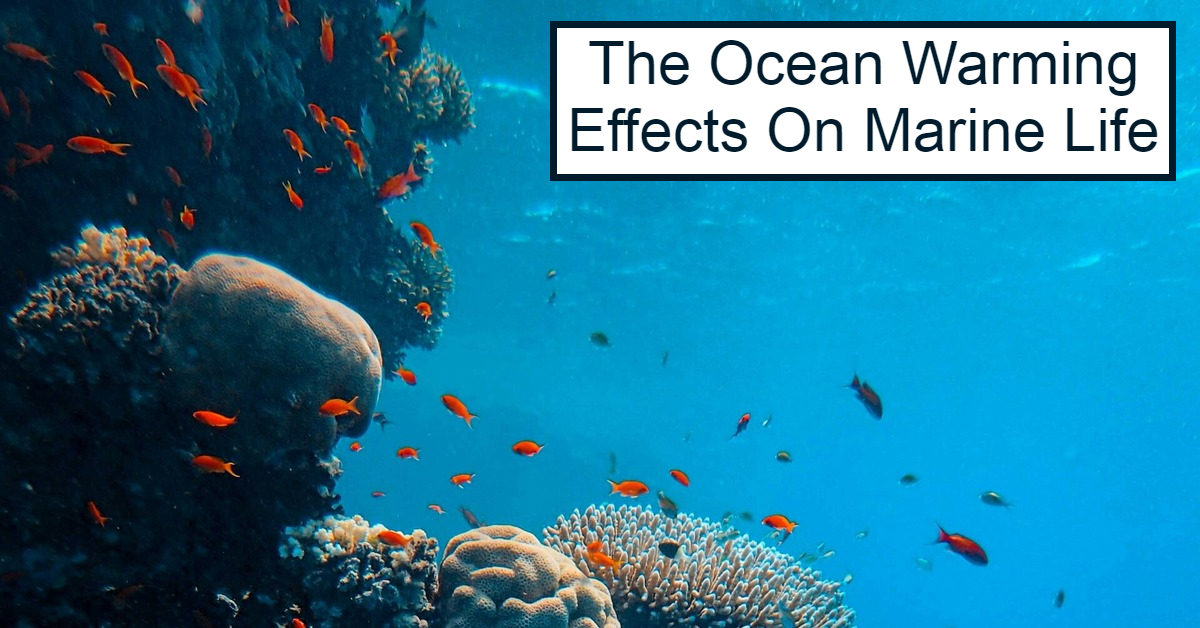
The Ocean Warming Effects on Marine Life
The last few decades have seen ocean temperatures rise as climate change begins to affect maritime industries worldwide. Here are the ocean warming effects on marine life seen so far.

- Search Used Yachts For Sale
- Search Boats By Brand
- Search Boats By Type
- Search By Location
- Search By Price
- What's My Boat Worth?
- Search Boats Just Listed
- Small Yachts
- Custom Sport Fishing Boats
- Finance A Boat
- Amer Yachts
- Cabo Yachts
- French Yachts
- Gulfstream Yachts
- Hatteras Yachts
- Solaris Yachts
- Sunpower Yachts
- Sunreef Yachts
- Vela Boatworks
- Virtus Yachts
- Why List With United?
- Why Own A Boat Or Yacht?
- Custom Website For Your Yacht
- United Sold Boats
- Buy A Yacht With Crypto
- Find a Yacht Broker Near Me
- Search For Broker By Name
- Meet The United Support Team
- Our History
- Fort Lauderdale Boat Show
- Stuart Boat Show
- Miami Boat Show
- Palm Beach Boat Show
- Other Boat Shows
- Yachting News
- Yacht Closing Services
- River Forest Yachting Centers

Search All Yachts
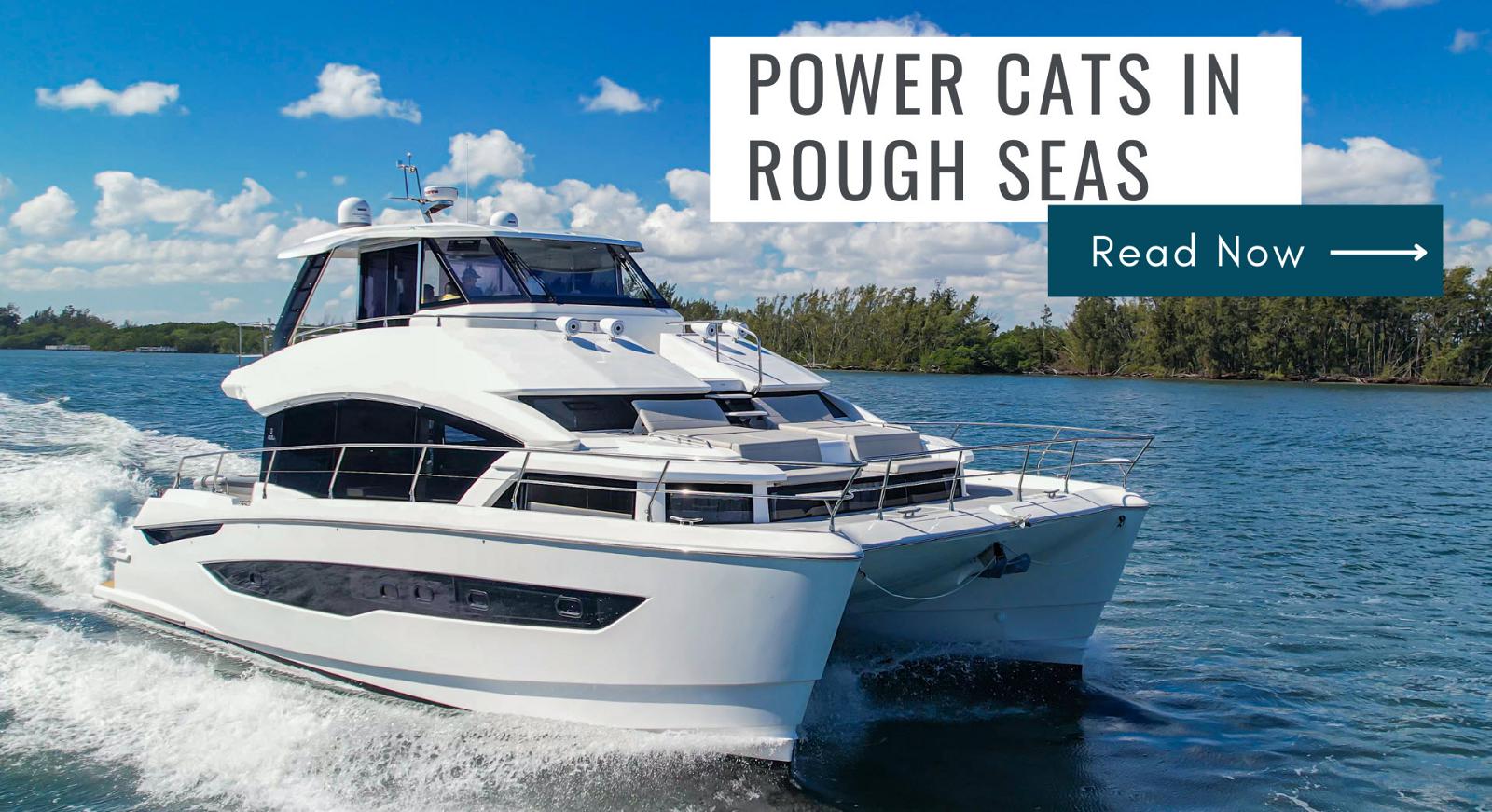
Are Power Catamarans Good In Rough Water?
By Robert Bowman | Posted On May 02, 2023 Updated On May 03, 2023
Anyone that's ever been caught on the water when a summer storm rolls up and the wind starts to blow has experienced a choppy ride back to the dock. Some boat builders perform better than others. Some types of boats perform better than others. While a little chop in a 40-foot center-console might not mean too much to the captain and guests on board, those in a luxury yacht might feel differently. Expensive furniture, cutlery, glassware, luggage, and whatever isn't secured down can often be tossed around the interior, leaving a mess for the captain or crew to clean up.
If you're searching for the right boat to keep things stable while on the ocean, the old adage of two is better than one definitely applies. Multihull boats are widely known to be a more stable platform while cruising, along with several other benefits. And the growth of ownership and popularity has substantially increased as well, with catamaran sales expected to rise to more than $2.2 billion by 2030 ! Many sailboat owners are beginning to ditch the effort it takes to enjoy boating and opting instead for power catamarans .
But are power catamarans really good in rough water? Certified professional yacht broker and power catamaran expert Brian Franc says "Yes!". "Based on my experiences and those of my clients, power catamarans perform very well in rough water," says Brian. "Multihull boats tend to be far more stable than monohulls due to the displacement across a much wider beam. This allows less water to be in contact with the twin hulls, offering more buoyancy." The result is that the power catamaran goes over the waves instead of through them, increasing stability and safety in rougher waters.
(Below: While this Freeman Boat has a multihull design, it uses outboards instead of traditional power cat inboard diesel engines. The performance of the hull is still the same though, as seen here while going through rough seas at Haulover Inlet.)
OTHER BENEFITS OF THE POWER CATAMARAN DESIGN
Aside from the advantage of being a very stable boat, the power catamaran design also has several other benefits for the owner in terms of performance. Of course, if you get any boat into 10-foot waves, there are going to be major problems, but we are assuming no one is going to be out boating in those conditions. For the purpose of answering the question of how power cats perform in rough seas, we are assuming waves of 6-feet or less.
Here are several other advantages that power catamarans have over traditional monohull boats.
- Power Cats Have Less Draft - Want to cruise the islands? Better be careful in traditional monohull yachts that have more of a draft. Because catamarans rely on buoyancy from their dual hulls, they require less water to float and sit higher on the water.
- Faster Than Sailboats, Sailing Cats, & Some Monohull Yachts - If you're moving into a power catamaran from a sailboat or a sailing catamaran, the twin engines will be a welcomed feature. Being able to get up to a 20 knots cruise means outrunning storms!
- Catamarans Are Easier To Maneuver - Thanks to being lighter in weight and having dual engines, maneuvering in rough seas or in a crowded area (like at a marina) becomes a little easier for a power catamaran owner. Add in the latest joystick technology and you can cruise with confidence.
- Power Catamarans Are More Fuel Efficient - Burn less fuel and spend less money with a power catamaran. Thanks to less drag and resistance, along with no sudden spikes in fuel consumption, power cats are well-known to be more efficient.
- Massive Accommodations And Living Spaces - Let's face it, you can simply do more with more space and it's tough to match the interior volume of a boat with a 20-foot beam or more. Power Catamarans are known for incredible space in the bedrooms, as well as the salon and galley.
(Below: The interior of this Aquila Boats 54, listed with Brian Franc, offers a tremendous amount of volume thanks to its 25' 2" beam.)
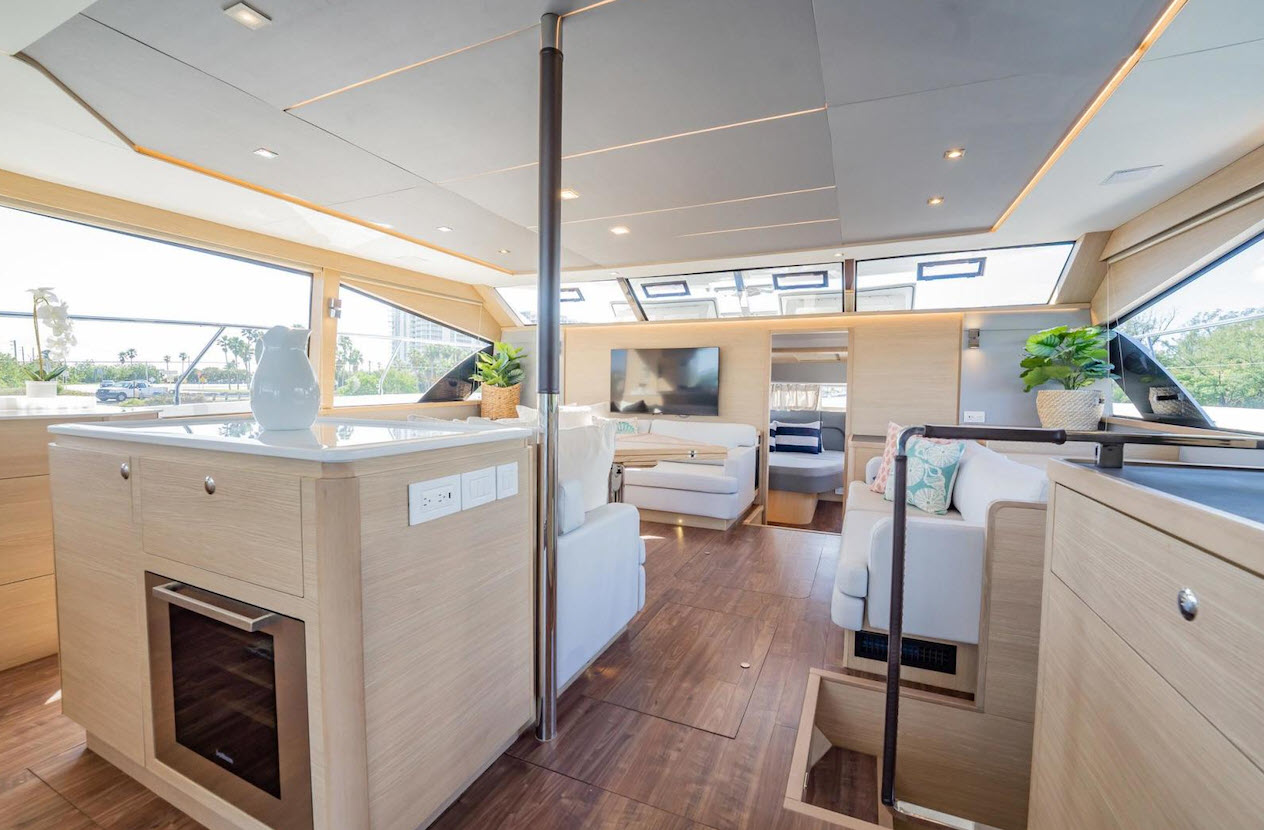
WHAT ARE THE DOWNSIDES TO OWNING A POWER CATAMARAN?
Easily the biggest downside to owning a power catamaran has nothing to do with its design, performance, or accommodations. It's where to put it. Most marinas have very limited space on where they can tie up a boat with a 25' beam as it takes up significantly more space than a monohull. Generally power catamarans are put at the end of the T-dock, which means there are less spaces available. Of course, if you are buying a power catamaran and putting it behind your house or into a charter program, this doesn't matter, but if you plan to rent a space at a marina, we suggest you work with your yacht broker to find storage.
(Below: Brian Franc's Aquila 54 - not in rough water, but looking good nonetheless.)
United Yacht Sales has the world's largest network of boat buyers and sellers in the industry, thanks to our team of over 250 yacht brokers in 104 different locations. Whether buying a luxury boat or selling one, we have the right expert on staff to assist you in navigating the brokerage market for your type of yacht. If you're looking at selling a boat, there is no quicker way to get activity than listing it with United. Our entire team is immediately notified every time a listing agreement is made with United Yacht Sales and many boats are sold before they ever even make it online. Our support team is among the best in the industry at marketing your yacht. 100% of our marketing budget goes towards advertising our clients' listings, a claim not many other firms can make. To get started listing your yacht, fill out our online form What's My Yacht Worth ?
Also Read: Who Makes The Best Power Catamaran?
Interesting Boating Links
Worldwide yacht sales.
- Million Dollar Yachts For Sale
- Used Boats For Sale in Washington State
- Carolina Yachts For Sale
- 20 Meter Yacht For Sale
- Steel Sailboat For Sale Canada
- Yachts For Sale in Virginia
- Boats For Sale Jersey
- 35 Million Yacht
- Yachts For Sale in Maryland
Luxury Boats & Yachts
- Yachts For Sale Near Me
- Prestige Boats For Sale
- 40 Foot Yacht
- Cabo Boats For Sale
- Trawlers For Sale
- Azimut Yachts For Sale
- Used Center Console
- 48 Ocean Yacht
- Sabre Yachts For Sale in Maine
- Boat Brokers
- Yachts For Sale by Price
- Catamaran For Sale Texas
Popular Builders & Models
- Used Catamaran
- Luxury Speed Boats For Sale
- Sea Ray 460
- Used Albemarle Boats For Sale
- 50 Viking For Sale
- Power Catamaran For Sale
- Cabo 35 Express
- Sea Ray L650 For Sale
- Hatteras 54 For Sale
- Yachts For Sale Charleston Sc
Trending Brands & Types
- Marquis Yachts
- Ranger Tugs For Sale
- Used Luhrs Yachts For Sale
- Nordhavn Boats
- Silverton Boats For Sale
- Whaler Boats
- Vanquish Boats
- Jarrett Bay Boats
- Leopard Catamaran For Sale
SEND UYS A MESSAGE
Recent posts.
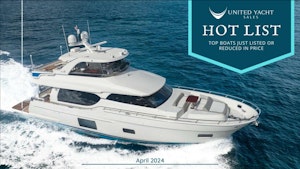
Apr 01, 2024
The Hot List - April 2024
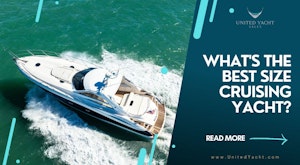
Mar 25, 2024
What Is The Best Size Cruising Yacht?

Mar 05, 2024
Cloud Yachts Joins United Yacht Sales
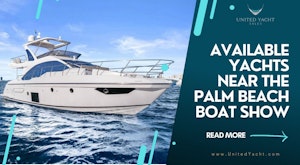
Yachts For Sale Near The 2024 Palm Beach Boat Show
Your source for the latest news on yachts, boats and more. Read through our articles to find out how to compare boats and find the right fit for you!
Power Catamarans: A Complete Guide
Dec 06, 2023
less than a min
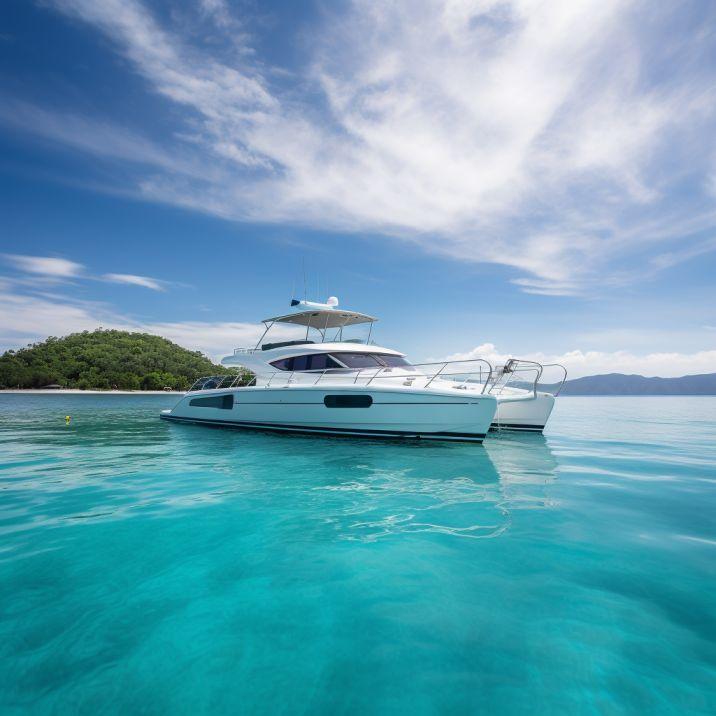
Power Catamarans, often termed as the epitome of modern maritime engineering, are gaining popularity for all the right reasons. Their distinct design, enhanced stability, and cruising efficiency set them apart from traditional monohull boats and even their sail-driven counterparts. This guide dives into the world of Power Catamarans, shedding light on their advantages and how they compare to other vessels like monohulls and trimarans.
Historical Prelude:
The concept of catamarans traces its roots back to ancient maritime cultures. However, the power catamaran is a relatively modern innovation that marries the traditional twin-hull design with powerful engines, offering a unique blend of speed, stability, and space.
Distinguishing Design:
Power Catamarans are characterized by their twin hulls, which significantly reduce the drag, thus enhancing speed and fuel efficiency. Unlike monohulls, they have a broader beam, which contributes to increased stability and more living space. The absence of a ballast for stability further lightens the vessel, contributing to its speed and fuel economy
Speed and Handling:
One of the significant advantages of power catamarans is their speed and handling. The twin hulls allow for a smoother glide over the water, making them particularly favorable for watersports enthusiasts. Their handling in rough waters is superior to monohulls, thanks to the inherent stability provided by the dual-hull design.
The stability of power catamarans is unparalleled, especially when compared to monohulls. The wide beam and twin hulls provide a stable platform, reducing the rocking and rolling common in monohulls. This stability is not only comforting in rough seas but also crucial when docking or anchoring.
Comfort and Space:
The spacious design of power catamarans offers homelike livability, with ample room for cabins, lounges, and even onboard amenities like grills and bars. The wide beam also allows for large deck spaces, ideal for sunbathing or enjoying the scenic ocean vistas.
Economy and Redundancy:
Power catamarans are economical, with fuel efficiency being one of their selling points. The redundancy built into their design, with separate engines for each hull, provides an added layer of safety, ensuring that the vessel can return to shore even if one engine fails.
Regular Upkeep and Care:
Power catamarans, given their unique design and structure, come with their own set of maintenance requirements. Like all boats, routine checks and upkeep are essential to ensure smooth sailing. The twin hull design means double the underwater gear – from propellers to rudders, which necessitates regular inspections for any signs of wear, tear, or fouling.
Antifouling:
Given that power catamarans have a larger surface area underwater due to their twin hulls, they may be more susceptible to marine growth. Regular antifouling treatments can help in keeping the hulls clean, ensuring optimal performance and fuel efficiency.
Engine Maintenance:
One distinct advantage of power catamarans is their dual-engine setup, but this also means double the engine maintenance. Regular oil changes, cooling system checks, and filter replacements are crucial. It's beneficial to synchronize maintenance schedules for both engines to ensure consistent performance.
The lifespan of a power catamaran largely depends on its build quality, materials used, and how well it's maintained. With proper care, a power catamaran can last for several decades. The engine's maintenance significantly impacts the catamaran's lifespan, with gasoline engines requiring maintenance at 1,200 to 1,800 hours and diesel engines at around 5,000 hours. The construction materials play a crucial role; for instance, fiberglass catamarans, when well-maintained, can last for many decades, while aluminum cats might change ownership after 10-15 years but can last a lifetime with proper care.
World-Renowned Builders:
The power catamaran sector boasts several reputable manufacturers such as Lagoon, Leopard Catamarans, Fountaine Pajot, and other notable names like Seawind Catamarans.
Lagoon, a revered name under the Beneteau Group umbrella, has carved its niche in crafting luxurious, spacious catamarans. A prime example is the Lagoon 630 Motor Yacht, embodying opulence with its nearly 250 sq. ft. aft deck and 900 sq. ft. interior, comfortably housing up to 12 guests. Known for its superyacht styling, it boasts superior fuel efficiency and a commendable average velocity-made-good of 9 knots.
Leopard Catamarans:
Emerging from the reputable Robertson and Caine shipyard in South Africa, Leopard Catamarans is synonymous with innovation and efficiency. The Leopard 53 Powercat is a testament to this legacy, showcasing excellent seakeeping abilities, offering 3 or 4 cabin configurations, and achieving a top speed of 25 knots.
Fountaine Pajot:
A trailblazer since 1976, Fountaine Pajot constantly redefines catamaran design. The Fountaine Pajot MY6 is a shining example, encapsulating the brand's visionary ethos. Stretching 15 meters, the MY6, equipped with dual engines of up to 2 x 353 Kw and 2 x 480 hp, promises dynamic sailing. Crafted meticulously by Pier Angelo Andreani, the interior mirrors a 20-meter monohull's spaciousness, reflecting modern aesthetics and comfort that stand as a benchmark in the Motor Yacht world.
These manufacturers continue to innovate, offering a blend of luxury, performance, and efficiency in their power catamaran models, making them a popular choice among maritime enthusiasts.
Comparing with Monohulls and Trimarans:
While monohulls are traditional and often cheaper, they lack the stability and space offered by power catamarans. On the other hand, trimarans, with three hulls, provide even more stability but at the cost of additional drag and less interior space.
TheBoatDB - Your Gateway to Maritime Exploration:
If you’re looking to delve deeper into the world of power catamarans and other vessels, TheBoatDB offers a comprehensive boat database. Explore various catamaran models, compare them with monohulls, trimarans, and other types of boats, and make an informed decision on your next maritime adventure.
In summary, power catamarans encapsulate a modern engineering marvel in the maritime domain. Their blend of speed, stability, comfort, and economy makes them an attractive option for a broad spectrum of boaters. Whether you are a long-distance cruiser, a water sport enthusiast, or someone who cherishes the tranquility of the sea, a power catamaran could be the vessel that transforms your maritime adventures into unforgettable experiences.
You might like these too

Sailboat or Motorboat – Learn the pros and cons lg ...
Aug 24, 2022

Types of Catamaran Boats: Sailing, Power, and Luxury Catamarans lg ...
Feb 10, 2023

Which is better a wooden boat or fiberglass boat lg ...

What are the main types of sail rigs for sailboats lg ...

Which is the Best Economical Catamaran lg ...
Oct 04, 2021

What is a Chine on a Boat lg ...
Oct 01, 2021

A Trusted Source For Boating Information Since 2019
The battle of the boats: catamaran vs. monohull in rough seas.
- Post Written By: Boater Jer
- Published: November 7, 2022
- Updated: November 7, 2022

Disclaimer: You might notice that we recommend products in some articles. We may earn a commission for referring you if you click the link and buy a product.
We only recommend products we’ve tried/tested/own (that’s why you won’t find thousands of affiliate links on my site). If you have experience with one of the products we’ve mentioned, please share your experiences in the comments at the end.
Advertisement

Catamaran vs. Monohull in Rough Seas? Catamarans and monohulls are boats that are pretty different from each other. Although the term catamaran applies to any vessel with multiple hulls, most catamarans are from two hulls connected by decks and outriggers to prevent capsizing in rough seas, while monohulls only have one hull.
Catamarans are typically faster and more efficient than monohulls, but the latter tend to be less expensive and easier to maintain. It’s imperative to understand the capabilities of different boats when planning your next trip on the open ocean.
This guide will help you figure out which boat would be better suited to handle rough seas and why, so you can make an informed decision when choosing your next vessel. You’ll learn what each type of boat excels at, how they handle varying conditions, and the key differences between catamarans and monohulls so you can pick the right one to match your needs. Let’s get started!…
What Are The Differences Between Catamaran vs. Monohull in Rough Seas?
Several key differences between catamarans and monohulls impact the way they handle rough seas . Here are some basics to help you choose the right boat for your next trip, whatever kind of water you’re venturing. For example, a catamaran has two hulls on either side connected by a keel beam. It gives it more stability than a monohull—which only has one hull—in choppy waters because it can ride over waves rather than get knocked around by them. In addition, as mentioned above, boats with multiple hulls tend to be less affected by changes in wave height or frequency than their single-hulled counterparts.
How Does The Amount of Hulls Affect Performance In Rough Seas?

Regarding performance in rough seas, catamarans and monohulls differ in a big way. For starters, catamarans become more stable when you’re going on stormy seas because they have more buoyancy than their monohull counterparts. However, most smaller boats are better suited for rough conditions than larger boats.

How Can You Test For Yourself Which Boat Is Better For You?
Of course, you can’t just jump on a catamaran and head out to rough seas to test its seaworthiness. But there are ways to try for yourself which boat is better for you. For example, if you’re considering buying a monohull or catamaran but aren’t sure which one will be best for your situation, look at your local weather patterns. If storms are common where you live, it might be wise to consider getting a boat that can handle rougher waters—which may mean opting for a catamaran over a monohull.
Which Kind Of Boat Do I Need?
Many wonder which kind of boat is best for them—one to sail across calm waters or conquer choppy seas. In truth, both can be used on several different water bodies and are effective for everyday use. But each boat has its benefits and drawbacks, and it may be wise to invest in a watercraft that aligns with your needs.
- Latest Articles
- Article Sources
Crab Island by Pontoon: A Fun Watery Boating Guide Destination in 2024
- Upgrade Your Boating Experience: Adding a Third Pontoon Made Easy!
- How Long Does It Take A Canoe To Go… (Canoe Calculator Here)
- In-Depth Review of the Pelican Sentinel 100X Fishing Kayak: Pros, Cons, and Performance
- How To Put A Kayak In The Water – The Ultimate Guide For New Kayakers
- Davis, M. R., and D. S. Holloway. “A comparison of the motions of trimarans, catamarans, and monohulls.” Australian Journal of Mechanical Engineering 4.2 (2007): 183-195.
- Targan, Barry. “Building Boats.” The North American Review, vol. 292, no. 3/4, 2007, pp. 71–73. JSTOR, http://www.jstor.org/stable/25478919 . Accessed 15 Jun. 2022.
replicarolex.is

Share this post with your friends
Subscribe to our newsletter.
Join us in our love for all things water. And Adventure.

Who Makes Each Brand of Catamaran and Where They’re Built
Advertisement Boating Guide Presents: Who Makes Each Brand of Catamaran and Where They’re Built. Catamarans are gaining popularity among seasoned sailors. Their speed and reliability made them the top choice for family cruises and long distances voyages. Let’s dig deeper into their fabrication, shall we? Among the acclaimed Catamaran brands is Lagoon, Privilege, Gemini, Bali,

Crab island isn’t an island at all, but an underwater sandbar that’s become the Mecca of boat relaxing and watery good times. Learn more at www.Boating.Guide.

How Fast Can Canoes Go? We Find Out (With World Records).
Advertisement Sliding over the glass-like stillness of a peaceful morning lake, a ride in the canoe is an incredible experience. The mist rising slowly off the water and wildlife waking to the coming day can be a nearly magical experience for the canoeist. However, it may not be only about peace and tranquility. If you
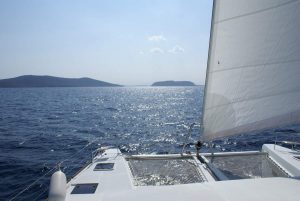
Staying Safe On A Catamaran: 24 Essential Tips
When you’re heading out on the water, having a good time is usually the first goal. I mean, let’s be realistic, most people who plan on going out on a boat are thinking first of the fun time, and second about safety. And if you’re intending to go out on a catamaran, depending on what type and size of the cat, there’s going to be some different circumstances that you’ll want to pay attention to for your own safety and the safety of those you have with you on board.

Everything You Need To Know About Boat Anchors (A Quick Read)
Most people enjoy being on boats. The smell of the water, the feel of the wind in your hair, and being around people you enjoy. It can make for a fun day. But at the end of the day, when you pull the boat back to shore, you will have to make sure that your boat stays in place. This is the job of the boat anchor.

Boat Propeller Anti-Fouling Paint, Grease, And Awesome Tips
Advertisement Boat Propeller Anti-Fouling Paint questions? You’re in the right place. Boat propellers often develop subaquatic organisms, hindering their performance and degrading their longevity. Antifoul paints and grease slow down the growth or detach these organisms. These products are available commercially, and their application is effortless. However, most people still ask for the best tips

Boat Information By Type
© 2023 Boating.Guide, A Hyperwave Media Group Ltd. Publication.
Privacy Overview

Service Locator
- Angler Endorsement
- Boat Towing Coverage
- Mechanical Breakdown
- Insurance Requirements in Mexico
- Agreed Hull Value
- Actual Cash Value
- Liability Only
- Insurance Payment Options
- Claims Information
- Towing Service Agreement
- Membership Plans
- Boat Show Tickets
- BoatUS Boats For Sale
- Membership Payment Options
- Consumer Affairs
- Boat Documentation Requirements
- Installation Instructions
- Shipping & Handling Information
- Contact Boat Lettering
- End User Agreement
- Frequently Asked Questions
- Vessel Documentation
- BoatUS Foundation
- Government Affairs
- Powercruisers
- Buying & Selling Advice
- Maintenance
- Tow Vehicles
- Make & Create
- Makeovers & Refitting
- Accessories
- Electronics
- Skills, Tips, Tools
- Spring Preparation
- Winterization
- Boaters’ Rights
- Environment & Clean Water
- Boat Safety
- Navigational Hazards
- Personal Safety
- Batteries & Onboard Power
- Motors, Engines, Propulsion
- Best Day on the Water
- Books & Movies
- Communication & Etiquette
- Contests & Sweepstakes
- Colleges & Tech Schools
- Food, Drink, Entertainment
- New To Boating
- Travel & Destinations
- Watersports
- Anchors & Anchoring
- Boat Handling
- ← Seamanship
Sail And Power Catamarans: Developing A 'Catitude'
Advertisement
Once you get the hang of it, multihulls are a blast to drive. Here's how to handle these versatile, comfortable boats — sail or power — for those considering chartering a cat.
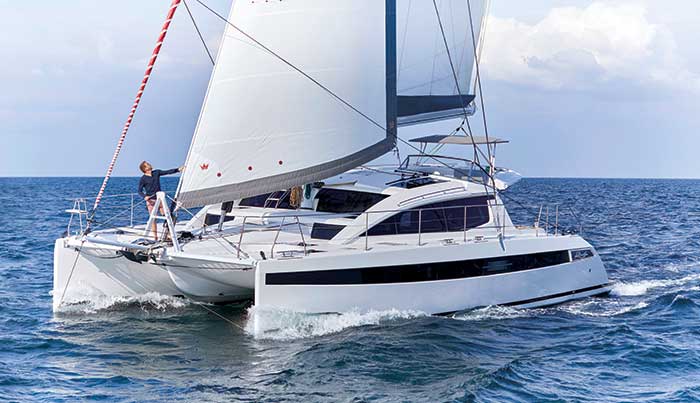
This 43-foot cat is trimmed well for upwind sailing. But once main and boom are eased out to accommodate wind direction, the jib may create a pinched slot as jib tracks are located on cabin tops. (Photo: Privilège Catamarans/Nico Krauss)
As a freelance marine journalist with a U.S. Coast Guard 100-Ton Master license, I get to captain dozens of boats of various designs and sizes. I'm also a cat convert from monohull boating with plenty of firsthand knowledge to share. If you're thinking of chartering or buying a cat, you'll benefit from their inherent advantages. Cats offer more room than the same-lengthmonohulls, they usually have better system access, and sailing cats may be faster in light wind because they're not dragging a heavy keel through the water.
Cats operate upright so you won't be on your ear in a blow. You can cook and sleep on a passage without "walking on the hull" like in a monohull that's heeling. You also spend more time above the waterline on a cat rather than the dreaded "down below" on a monohull.
Of course, for all the pluses, there are minuses: Finding a marina berth for a cat is difficult and expensive. Unlike monohulls that get into the groove and slice through waves when sailing upwind, cats can slap the water if the bridge deck clearance is low, or when the seas meet the underside of the bridge deck.
People who usually sail monohulls may be accustomed to being alerted to the wind rising too much by the increasing heel of the boat. If you get this amount of heeling in a cat, you may be beyond the point of no return; though this isn't as likely with many of today's heavier, wider models. Cats are not self-righting; you have to stay alert to worsening weather.
Also, unless it's a performance model with daggerboards, a cat only has mini-keels, so it won't point high and can be a bit like maneuvering a shoebox. They don't track well, tending to slip to leeward, and they tack slowly because they have to push two hulls rather than one through the eye of the wind. Finally, cats have fairly shallow rudders, so close-quarters maneuvering comes more from dual engine thrust, rather than the water flowing over the rudders — effective, but something to get used to.
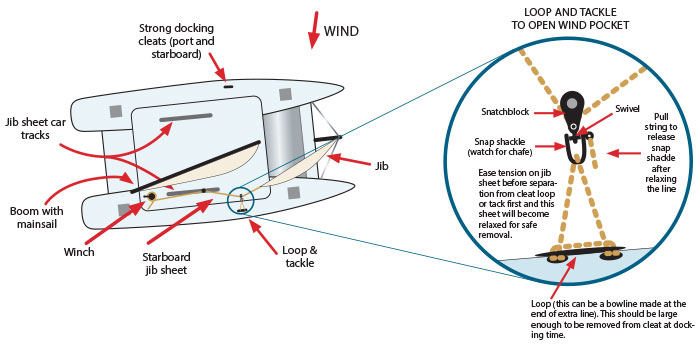
An easy adjustment to position the jib out farther and improve performance is shown in this illustration.
When it comes to the emerging power-catamaran trend, driving cats under power is a straight-up joy. Their two props are set wide apart resulting in much better control and precise maneuvering in close quarters. Cats don't coast like monohulls because they don't have a keel to keep them tracking, so gliding into a dock at a shallow angle doesn't work, and neither does using propwalk to tuck in the stern. You use the engines to spin a cat in its own length or walk it sideways, both of which are easier to master than the nuances of driving a monohull.
Regardless of whether you're docking, picking up a mooring, or anchoring, always keep the boat powered up and ready to drive until you're done because you can't just push a 45-foot cat around by hand. Here are some handling tips that apply to handling both sail and power catamarans.
Don't Ding The Dock
When there's no wind, bigger sailcats also have an engine, which is needed in each hull. They aren't powered to drive as fast, but the principles are the same. Keep in mind, boats and conditions are varied, so we can only give examples here.
- Forget about the wheel when docking side-to or forward. Lock it on the centerline with the wheel lock or by leaning your body against it and maneuver using the throttles (see illustrations below). Power forward with the starboard engine, and aft with the port, and the cat moves to port and vice versa. Turn this around in your head when in reverse. Fine tune adjustments by using one engine at a time. Pause the propeller in neutral when changing directions from forward to reverse and vice-versa to give transmissions time to engage.
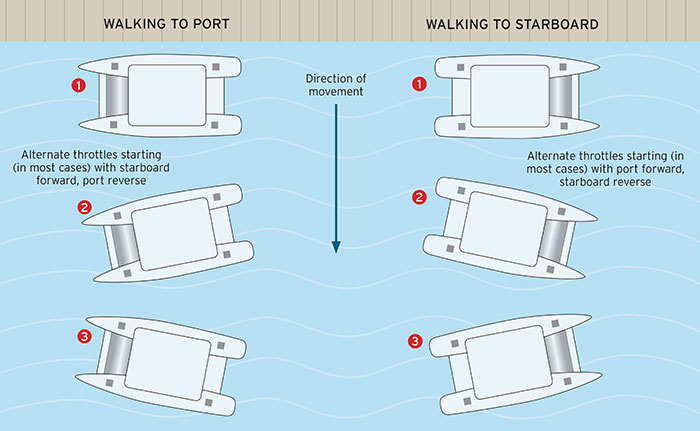
- Backing into a slip: Cats dock stern-to because the bows are high and it's easier to step on and off the dock via the swim platforms aft. When backing straight into a slip, come abeam, pivot 90 degrees with the engines until centered, and back in. If Med-mooring, drop anchor and pay out the rode slowly as you back with both engines. Set the anchor part way back, then keep backing and letting out rode until you're close enough to the dock to tie up the stern lines. Have fenders already tied aft to cushion the transoms. Tighten up on the anchor rode with the windlass.
Wind And Current
As with any boat, it's best to work against the current for better control.
- When departing a starboard tie-up with the current coming at the bow, put a fender and line on the starboard aft corner, power aft with the port engine, pivot, then drive out forward with both engines against the current. If the current is coming from behind, back out, putting a line and fender on the starboard bow. Power in reverse with the starboard engine, pivot, and then back out with both engines.
- Cats have high cabin tops, producing lots of windage. In tight quarters, you may need to turn more sharply when approaching a dock or line up to windward before backing in.
Picking Up A Mooring
Cats have high hulls and it's easy for the skipper to lose sight of a mooring ball before the boat is close enough for the crew to pick it up. Keep the mooring on the side where you can best see forward so you can keep an eye on the ball at all times. (Some cat helm stations are offset to one side or the other.)
- Hand signals or a headset for you and the crew make communications easier to send and receive rather than yelling.
- Have your crew pick up the mooring with a boat hook while you maneuver with the engines to keep station — easier on a cat than a monohulls, even in wind and current.
- Have lines ready by stringing one off a cleat on each hull. To do this, thread each line through the eye or loop, then back onto its cleat. Do this with both sides and adjust until the mooring sits on the centerline. This will minimize swinging and chafe, and noise in the forward cabins.
Anchoring is generally easier on a cat than a monohull. There's more room forward for crew to work, and you can keep the boat steady with the engines.
- A bridle should be preset with a line from each hull (under the trampoline) and hook or shackle in the middle. Once the anchor and chain is down, attach the bridle to the chain (usually done near the windlass) and set the hook putting the pressure on the bridle. Once set, let out enough chain to create a catenary.
- When raising anchor, take care to keep the chain in between the bows or you risk damaging the fiberglass by shaving the bottom of one or the other if you overrun the chain or lose track of where it is. Crew communication is critical.
Sail-Specific Cats
Here's how to coax the best out of a sailing catamaran:
- Big cats carry huge mainsails, so raising one typically requires an electric winch. It also may be challenging to keep full battens out of the lazyjacks that hold up the sail bag, so it can take a few people to raise a large sail. Also, there are usually multiple angles to the way halyards are run on cats with flybridges, resulting in friction. So "dropping" the mainsail can be more like "pulling" it down. Attach a messenger-type line to the mainsail head so it comes down easier.
- Reefing can be a guessing game because you don't feel a cat being overpowered like you do a monohull. Depending on the direction of sail and the sea state, you may be able to reef a little later with the wind a few knots higher — an individual call.
- Cat headsail tracks are typically on the cabin top making the sail curve back on itself, creating a wind break when it's sheeted in. A trick is to bring a spare line from the jib clue out to a cleat on the side deck to open up the slot to let air flow through. Check for chafe on the cabin and don't forget to release it before tacking.
- The majority of multihulls are built to sail on a beam or broad reach, and that's where they're the happiest. Dead downwind, cats shimmy a little making wing-on-wing sailing tricky, not all that different from monohulls. For more comfort, choose one broad reach or the other, then jibe when necessary.
- Cats with daggerboards can point higher and track better because, like monohulls, they have an appendage (or two) down low in the water for a better center of lateral resistance. Daggerboards are mostly used when sailing upwind, and it helps to keep the leeward board lower than the windward one. Sailing downwind with the boards lowered could create a tripping hazard, especially in rough seas where it's possible to stuff the bows into the wave ahead. When motorsailing, a trick to saving fuel and pointing higher is to run only the leeward engine for a little pointing assist.
Next time you have an opportunity to test drive a power or sailing cat, or to charter one on your next holiday, try it! The learning curve is so quick, it's really fun, and before you know it, you, too, may convert to being a cat person!
Catamaran Brands
You can further explore the array of catamarans, big and small, power and sail, by visiting any of these leading manufacturers.
- Aquila Power Catamarans
- Aspen Power Catamarans
- Fountaine-Pajot
- Horizon Power Catamarans
- Leopard Catamarans
- Nautitech 47 Power
- Balance Catamarans
- Fountaine Pajot
- Outremer Catamarans
- Seawind Catamarans
Related Articles
The truth about ceramic coatings for boats.
Our editor investigates the marketing claims of consumer-grade ceramic coatings.
Fine-Tune Your Side Scan Fishfinder
Take your side-scanning fishfinder off auto mode, and you’ll be spotting your prey from afar in no time
DIY Boat Foam Decking
Closed-cell foam flooring helps make boating more comfortable. Here’s how to install it on your vessel
Click to explore related articles
Zuzana Prochazka
Contributor, BoatUS Magazine
Zuzana Prochazka is a freelance journalist specializing in writing, editing, and photography in boating and travel publications. She writes for a dozen boating magazines and websites and a growing list of travel publications. She enjoys combining her passions, which include seeing the world, sailing the oceans, and sharing her experiences through the written word. She holds a U.S. Coast Guard 100 Master license.
BoatUS Magazine Is A Benefit Of BoatUS Membership
Membership Benefits Include:
Subscription to the print version of BoatUS Magazine
4% back on purchases from West Marine stores or online at WestMarine.com
Discounts on fuel, transient slips, repairs and more at over 1,200 businesses
Deals on cruises, charters, car rentals, hotel stays and more…
All for only $25/year!
We use cookies to enhance your visit to our website and to improve your experience. By continuing to use our website, you’re agreeing to our cookie policy.
- 2024 BOAT BUYERS GUIDE
- Email Newsletters
- Boat of the Year
- 2024 Freshwater Boat and Gear Buyers Guide
- 2024 Boat Buyers Guide
- 2024 Water Sports Boat Buyers Guide
- 2023 Pontoon Boat Buyers Guide
- Cruising Boats
- Pontoon Boats
- Fishing Boats
- Personal Watercraft
- Water Sports
- Boat Walkthroughs
- What To Look For
- Best Marine Electronics & Technology
- Watersports Favorites Spring 2022
- Boating Lab
- Boating Safety

Catamaran Versus Deep-V Monohull
- By Chris Caswell
- Updated: February 26, 2018
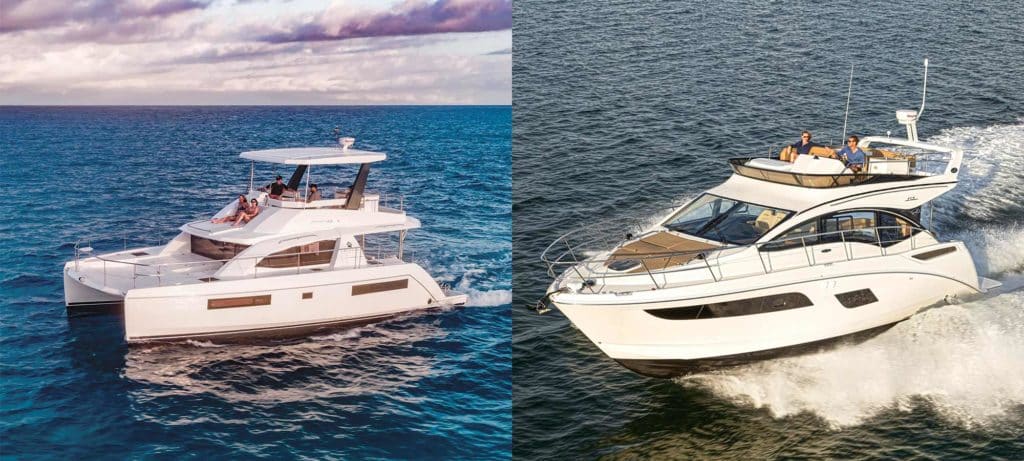
Ever since the Polynesians started crossing oceans on catamarans when much of the “civilized” world was still afraid of the sea, the idea of the twin hull has ebbed and flowed in popularity. For centuries in the Western world, the monohull ruled the seas. At least until 1876, when Nathanael Herreshoff designed a sailing catamaran that was so fast, cats were actually banned from racing for years. Yes, cats are cool. But how do they really stack up against the classic, tried-and-true deep-V monohull?
Let’s look at the strengths and weaknesses of catamaran and monohull boats. We picked two boats of similar length: the Sea Ray Fly 400 (43 feet 6 inches) and the Leopard 43 Power Cat (42 feet 8 inches). The Sea Ray displaces more (30,900 pounds versus 25,794 pounds), but the major difference is beam: The Leopard, carrying 22 feet 1 inch of beam, is nearly 9 feet wider than the Sea Ray (13 feet 6 inches). And that is where many differences between the two start.
Before we go on, we need to provide a disclaimer. We know we’re comparing apples to oranges to some degree, so don’t go sending us angry letters about an unfair comparison. Frankly, it’s sometimes good to compare the taste of oranges and apples. And here’s the thing: We like them both! Both boats ended up with good scores in some areas, lesser in others. We do believe that the concepts that surfaced as a result of comparing these two boats will help cruiser buyers make a more informed decision if the question of cat versus mono arises in their quest for a new boat. That said, let the comparison begin.
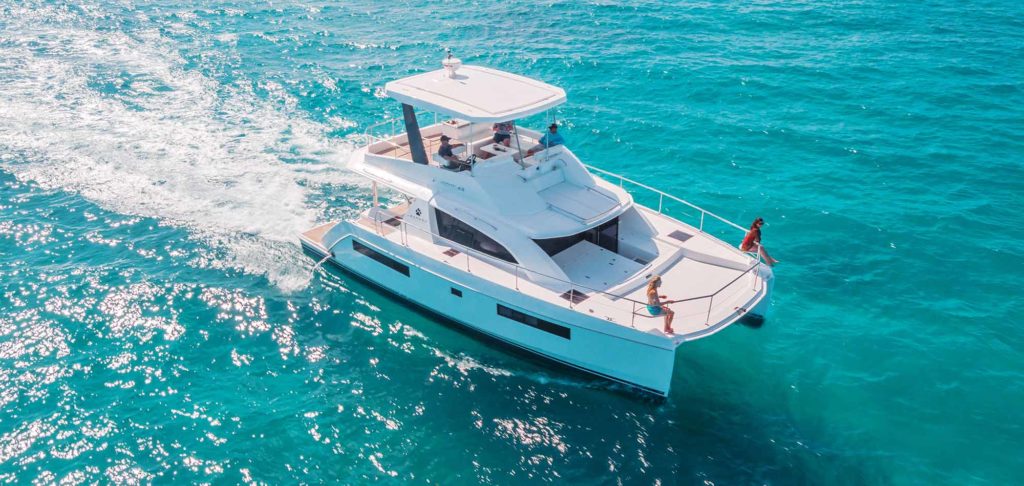
Fast Action: Speed Vs. Efficiency
With 960 hp from twin Cummins diesels, the Sea Ray easily wins in top speed at nearly 34.5 mph compared to the Leopard (27.6 mph), but at a serious cost in fuel. At 20 mph, the Leopard is using just 20 gph, for an even 1 mpg. At the same speed, the Sea Ray is using 32.6 gph, netting 0.5 mpg.
“A strength of the catamaran is that it has such low drag,” says Gino Morelli, the catamaran designer, whose credits range from America’s Cup contenders and Olympic-class cats through power cats for charter use up to a record-setting round-the-world 125-foot cat. “It’s just basic hydrodynamics: Two slim hulls have very low resistance. They push much less water than one wider hull and therefore require smaller engines for increased efficiency.”
The Sea Ray is faster; the Leopard is more efficient. It’s nice to have speed when you want to outrun an approaching squall or get to an anchorage first. On the other hand, you’ll probably spend most of your cruising time at the lower speed more comfortable to your guests.
Our take: Both are winners. It’s your choice.
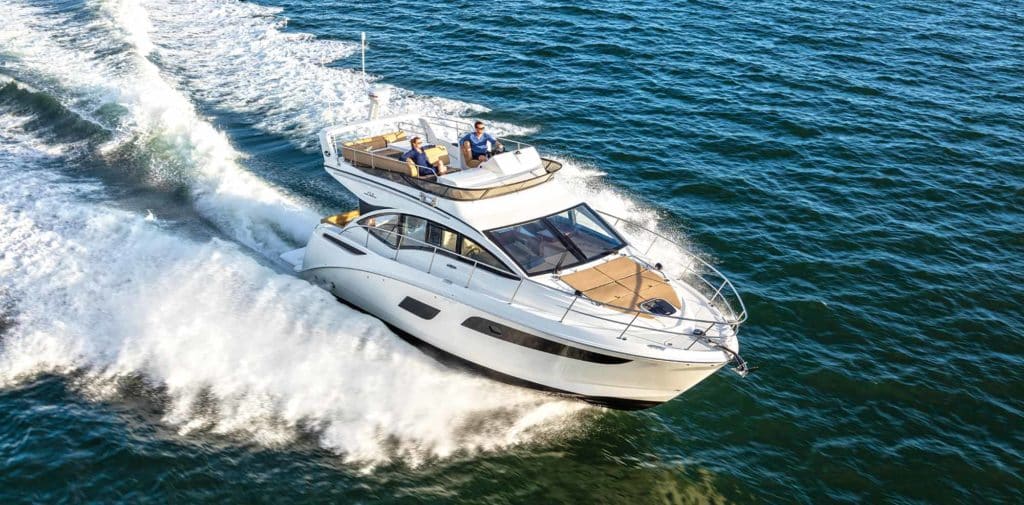
Pain and Gain: Ride Vs. Handling
“Two sharp hulls pound less in a seaway too,” says Morelli. Monohulls, especially cruising monohulls like the Sea Ray, tend to experience bow rise when accelerating, while catamarans remain flat throughout their speed range. It’s generally agreed that catamarans provide a softer ride in a seaway because their knifelike hulls slice the waves rather than crush them, and the motion of a catamaran in waves is more like a cantering horse, which some people like and others don’t. At low speeds in a beam sea, some power cats can have a sharp roll as swells pass under each hull separately, but monohulls also roll considerably, which is why gyrostabilizers and stabilizer fins have become popular aboard monohulls. But the roll moment is different for each, and you may or may not prefer one motion to the other.
In hard turns, catamarans remain flat or even lean outboard somewhat, which can intimidate inexperienced skippers more used to the inboard bank of a monohull. Handling is another factor to consider, and catamarans have both good and bad features. With the engines widely spaced in the two hulls, a catamaran is more maneuverable at slow speed and spins easily by using its engines. A monohull, with the two engines close together, requires more power and technique to spin.
The downside of handling a cat, of course, is the much wider beam: Turning a platform that is more than half as wide as it is long can take planning, especially in narrow channels. Some, but not all, catamarans also have some weird quirks, such as “sneezing” between the hulls when running in some conditons, which sends spray over the bow, and also pounding at times at idle speeds due to air pockets.
Draft is something to keep in mind too, especially if you want to explore shallow waters. The Leopard draws 3 feet 1 inch compared to the Sea Ray at 3 feet 7 inches. The Leopard also has skegs to protect its props, rudders and running gear if you decide to nose up to a beach.
That 22-foot beam has another downside: It doesn’t fit in many marina slips, which means the Leopard is likely to moor on end ties (with more wave motion) or on side ties along a seawall, while the Sea Ray will fit into most any marina slip. Catamaran slips are often more expensive too.
Our take: The catamaran wins for its soft ride in a seaway. The V-hull wins for fitting into a greater number of protected, less-expensive marina slips.
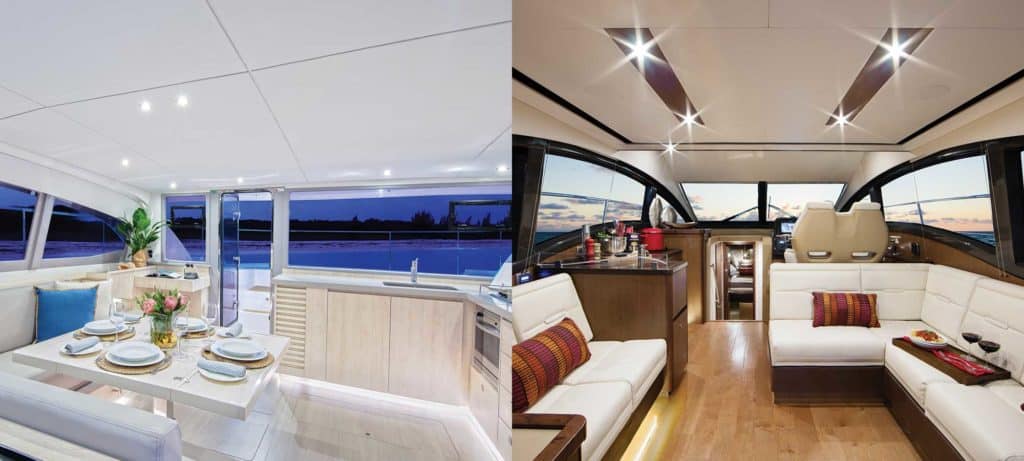
Interior Accommodations – Salon
There’s no getting away from the fact that a 22-foot-wide boat will have more space than one with a 13-foot beam, or so it should seem. But that isn’t quite true. Let’s start with the salon.
Having a 20-something-foot-wide living room is something you don’t find aboard monohulls until you pass the 100-foot length, and this is exactly why catamarans are proving popular with liveaboard owners. In the case of the Leopard, there is a large dinette, a single-seat lower helm station, and a spacious L-shaped galley with counter space measured in acres. Galley gear includes a three-burner gas cooktop with gas oven, and a two-drawer fridge.
The Sea Ray has a doublewide helm station, a pair of facing couches, and a galley aimed more at dining ashore, with limited counter space, a two-burner electric cooktop, microwave and fridge.
While the Leopard salon excels in sheer space (there is room to dance in the salon), it also has one popular feature: a front door. Both boats have sliding doors aft into the cockpit, of course, but the Leopard has an offset door that opens to the foredeck for anchoring or sunning.
Our take: The salon winner is the Leopard catamaran.
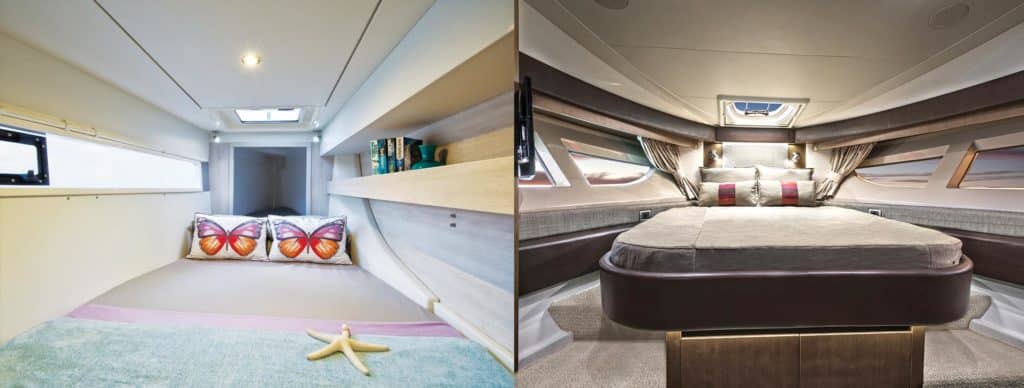
I said “so it should seem” about a wider beam on the Leopard equating to more space, which was true for the salon, but not so much for the staterooms. The Sea Ray has a conventional monohull layout for this length, with the master stateroom forward and a midship cabin under the salon with two berths that can slide together to become a double. The Sea Ray master cabin has a walk-around island queen-size berth, while the midship cabin has limited headroom, but a couch and a separate head are optional.
The Leopard, on the other hand, offers either a four-cabin or a three-cabin owner’s layout. The four-cabin is popular with chartering, placing two cabins in each hull, with a head and stall shower between, while the owner’s version fills the starboard hull with the berth aft and the bow becomes a large head with stall shower.
The shortcomings of the catamaran are the narrow hulls, which limit the width of the cabins. The berths literally fill each cabin, hullside to hullside, making these into less graceful crawl-in berths, and each cabin has limited floor space and stowage.
Our take: We’ll call this even, depending on whether you want more smaller cabins or fewer but more-spacious cabins.

Once again, sheer beam is the determining factor in flybridges. The Leopard has a wraparound dinette, doublewide helm seat, and outdoor galley with barbecue grill and fridge. The Leopard bridge still has ample space for deck chairs or kayaks. A walk-through next to the helm leads to a sun pad on the forward bridge for lounging.
The Sea Ray 400 Fly has a single helm chair and a double companion seat, as well as a dinette and mini galley, but no extra space.
Our take: The Catamaran’s extra width offers a more spacious flying bridge.
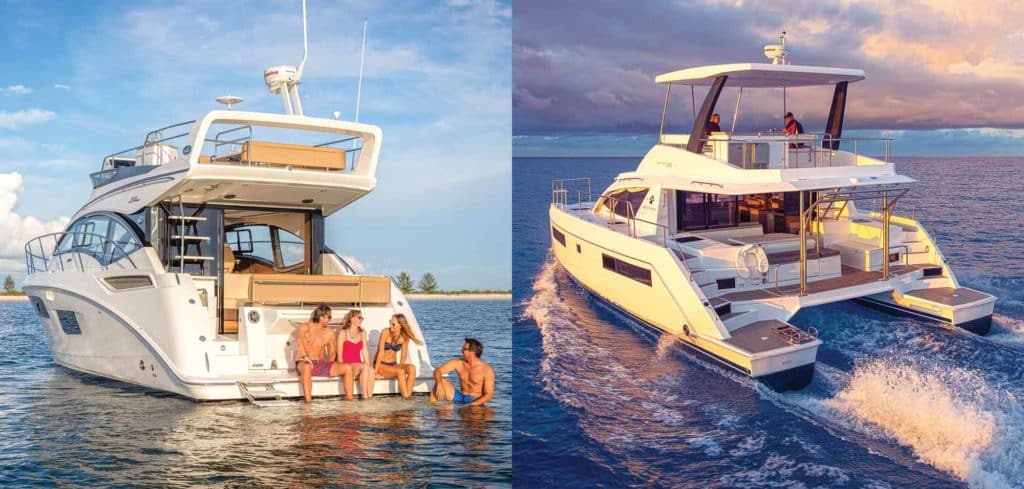
Transom Platform
The Leopard Power Cat has smaller transom platforms, but there are two of them. Leopard created a clever electric davit that can launch or retrieve a tender and provide secure stowage while underway, making tender operations easy. The Sea Ray offers a standard transom platform or an optional hydraulic platform, either of which serves as a terrific “beach” for your crew while at anchor. It can carry up to a 500-pound tender such as a Sea-Doo Spark PWC.
Our take: The monohull’s single wide swim platform is superior for tender handling, swimming and socializing
Fit and Finish
This last item is empirical, and the fact is the two boats are finished to different standards. The Leopard ($459,000 MSRP), like many catamarans, is designed for minimal maintenance for tough charter service, with expanses of fiberglass and Formica-like materials. The Sea Ray ($809,542 MSRP), on the other hand, uses fabrics and finishes that create a more opulent, yachtlike interior.
Engine access on the Sea Ray 400 Fly is good via a gas-lifted cockpit deck, while the Leopard engines are under the berths in the two aft cabins, which rise on gas lifts, but there is some upheaval of two cabins to check the oil. Again, a personal choice: one engine room or two.
Our take: Finish is not strictly a cat or mono attribute. Any boat can be finished to any level, depending upon the builder’s target market.
Catamaran or monohull? Both are right for certain owners and, just like apples and oranges, both taste good for different reasons. Boating ‘s position for decades has been and continues to be: There is no perfect boat, but there is probably a boat that is perfect for you.
- More: Boats , Cruising Boats , Leopard Catamarans , sea ray , versus

Catching a Swordfish on a PWC
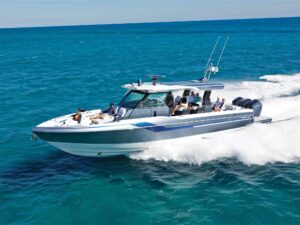
Boat Test: 2024 Formula 457 CCS
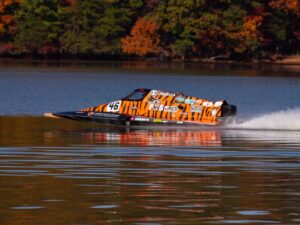
A New Electric-Powered-Boat Speed Record
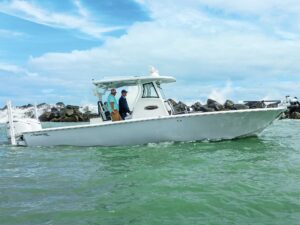
Boat Test: 2024 Tidewater 3100 Carolina Bay
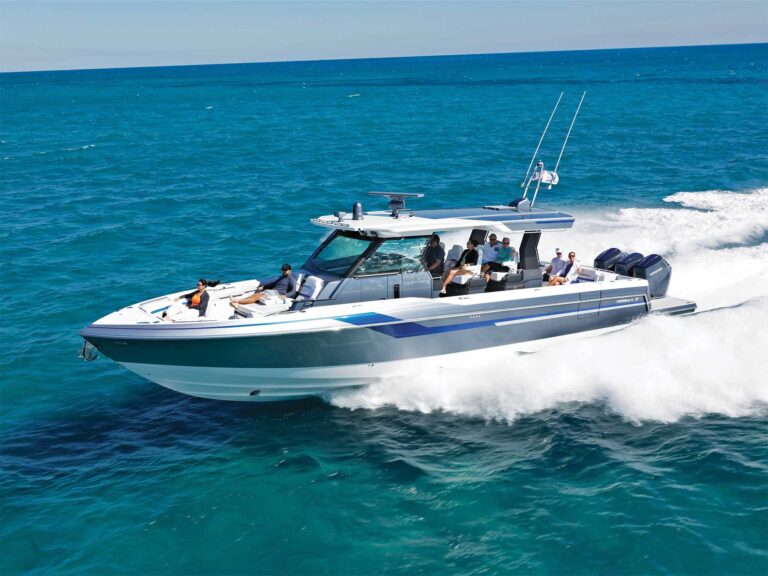
What to Do if Your Boat’s Engine Dies
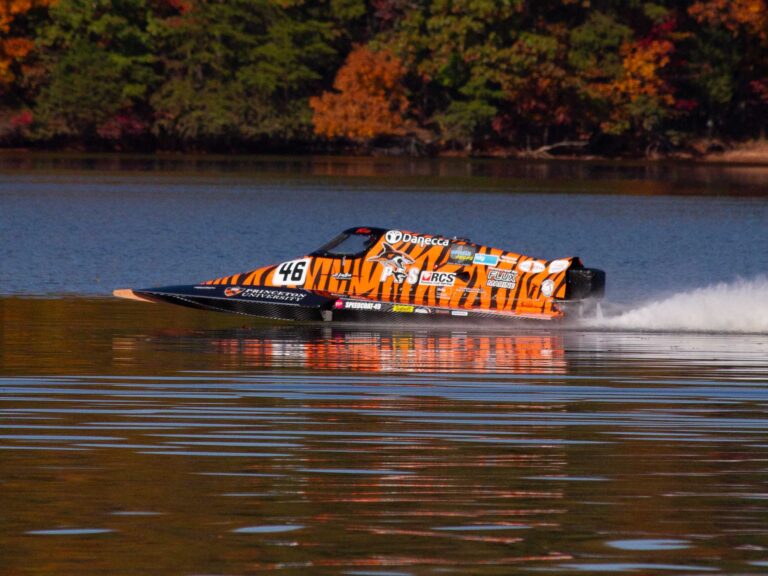
Six Tools for Spring Make-Ready

- Digital Edition
- Customer Service
- Privacy Policy
- Cruising World
- Sailing World
- Salt Water Sportsman
- Sport Fishing
- Wakeboarding
Many products featured on this site were editorially chosen. Boating may receive financial compensation for products purchased through this site.
Copyright © 2024 Boating Firecrown . All rights reserved. Reproduction in whole or in part without permission is prohibited.
Catamaran vs. monohull: Navigating the waters in style and comfort
- Catamaran vs. Monohull: Navigating the waters in style and comfort
Embarking on a journey across the open waters has long captured the human spirit of adventure. The realm of sailing offers a plethora of options, each delivering its own unique experience. Among these, catamaran sailing stands out as a modern and luxurious way to navigate the seas. In this article, we delve into the world of catamaran sailboats, compare them to monohull counterparts, and help you discover the ideal choice for your maritime dreams.
Unveiling catamaran sailboats
Catamarans, known for their twin hulls and spacious decks, have redefined the sailing experience. These impressive vessels offer stability, ample space, and a comfortable layout, making them a favorite among sailing enthusiasts. Whether you're a seasoned sailor or a beginner, a catamaran promises a remarkable adventure on the water.
The thrill of sailing a catamaran
Sailing a catamaran brings a new level of excitement. The feeling of gliding through the water with minimal heeling is exhilarating. The wide deck areas provide plenty of space for relaxation, sunbathing, and socializing. Catamarans are also well-equipped with modern amenities, ensuring a comfortable journey.
Read our top notch articles on topics such as sailing, sailing tips and destinations in our Magazine .
Monohull sailboats: A classic choice
Monohull sailboats, with their single hull design, embody tradition and elegance. These boats are known for their responsiveness to wind and waves, offering an authentic sailing experience. While they may have less space compared to catamarans, their sleek design and maneuverability make them a beloved choice for purist sailors.
Choosing between catamaran and monohull
Deciding between a catamaran and a monohull often boils down to personal preferences. Catamarans excel in stability and space, making them suitable for larger groups and extended trips. Monohulls, on the other hand, offer a classic sailing feel and perform well in various weather conditions. Consider your priorities and the type of adventure you seek.
Sailing catamaran: A luxurious experience
Catamarans offer more than just a sailing experience; they provide a luxurious way to explore the waters. With spacious cabins, well-appointed kitchens, and modern bathrooms, catamarans feel like floating vacation homes. The comfort and opulence they offer have elevated the world of maritime leisure.
Navigating choppy waters: Monohull vs. catamaran
In rough seas, the design of a catamaran shines through. Its twin hulls provide excellent stability, reducing the rocking motion common on monohulls. If comfort during challenging weather is a priority, catamarans have a clear advantage.
Sailboat catamaran: Best of both worlds
For those who desire a mix of tradition and modernity, sailboat catamarans offer the best of both worlds. These vessels combine the classic aesthetics of monohulls with some of the space advantages of catamarans. Sailboat catamarans cater to sailors who value both performance and comfort.
Setting sail: Monohull yacht adventures
Monohull yachts, especially those designed for racing, offer a thrilling experience on the water. The feeling of harnessing the wind's power to glide through the waves is unparalleled. Monohull yachts are favored by competitive sailors and those who relish the art of traditional sailing.
Exploring the multihull sailboat
Beyond catamarans, the realm of multihull sailboats includes trimarans, which have three hulls. Trimarans offer a unique combination of stability and speed, making them suitable for both leisurely cruises and exhilarating races. They are perfect for those seeking a balance between comfort and performance.
Catamaran sailing yachts: Unmatched elegance
Sailing yachts built on the catamaran platform exude elegance and sophistication. These vessels are designed to provide a lavish experience, with spacious cabins, gourmet kitchens, and lavish lounging areas. Catamaran sailing yachts redefine luxury living on the open sea.
Catamaran landing near Anse Severe on La Digue Island, Seychelles
Monohull vs. multihull: Making the right choice
Choosing between a monohull and a multihull depends on your preferences and intended use. Multihulls, including catamarans and trimarans, offer stability and space. Monohulls provide a classic sailing feel and are favored by those who appreciate tradition. Consider your priorities and aspirations to make an informed decision.
Catamaran sailing safety and tips
Safety is paramount when sailing, regardless of the vessel type. Catamarans' stability reduces the risk of capsizing, but it's essential to follow safety guidelines and weather forecasts. Proper training, regular maintenance, and responsible navigation contribute to a safe and enjoyable sailing experience.
Catamaran sailing offers a blend of luxury, comfort, and adventure on the open waters. Monohulls continue to captivate with their classic charm and sailing prowess. Both options cater to different tastes and aspirations, ensuring that the world of sailing remains diverse and inviting.
So what are you waiting for? Take a look at our range of charter boats and head to some of our favourite sailing destinations .
FAQs about catamaran vs. monohull

Catamarans In Rough Seas? Facts and Figures From Sailors!

As an Amazon Associate, we earn from qualifying purchases. We may also earn commissions if you purchase products from other retailers after clicking on a link from our site.
I had my first “real” sailing experience 11 years ago on a monohull in the Bahamas, before that I worked at a Ferrari workshop. Coming from a “dry-land-racing” world made me wonder why some would argue that cats are unsafe in rough seas. They should be more stable since they have a wider base, just as in the racing world, right? A few years later I still hear this old statement that catamarans arent safe for rough weather, so today ill try to add some info on the topic.
Catamarans are safe in rough seas because their double-hull design and wide stance make them highly stable. They’re also easy to maneuver, have shallow drafts, and high speeds that help them outrun storms. Still, you need a skilled crew capable of controlling the vessel to ensure your safety.
In this article, we’ll explore several reasons why catamarans are safe in rough seas. We will also take a deeper look at what makes catamarans capable of handling rough sea conditions. Keep it here to discover valuable tips on how to sail your catamaran safely despite the weather.
Table of Contents
Catamarans Are Practically Unsinkable
A capsized monohull might right itself up, but guess what? A well-designed cruising catamaran is very hard to capsize and almost impossible to sink. This doesn’t mean that it’s okay to go looking for storms to conquer, though. So, what makes a catamaran so difficult to sink, even in the unlikely event that it flips over? Let’s find out.
If you want to dive a little deeper into Catamaran capsize statistics I suggest my other article: Why catamarans capsize!
Catamarans Are Highly Stable
In rough seas, a catamaran will show its superior performance through its twin hulls. Rough seas are defined as waves that rise to heights between 2 to 6 feet (0.6 -1.8 meters).
The hulls turn a catamaran into a floating platform that’s pretty sturdy. In addition, their wide stance and solid construction make the vessel extremely stable, allowing it to withstand the water’s constant pounding motion. The larger the boat, the more stable it gets.
The result is a smooth ride with minimal to no rocking from wave action. As a result, you are less likely to suffer from motion sickness on board a catamaran. A stable platform means reefing and sail changes become much easier and safer, particularly during rough weather. You suffer less fatigue and are thus more alert. Furthermore, there is minimal risk of anyone suffering severe injuries or falling overboard.
Cats Are Easy To Maneuver
Catamarans manufacturers employ various design and structural techniques to enhance maneuverability. Firstly, the bridgedeck positioning is above the water to create a high bridgedeck clearance , which contributes to a ride that is free from loud noises called bridgedeck slamming. Something that old school cats had problems with and would prematurely fatigue the crew.
Read this article to understand what makes a great blue water catamaran (a cat that’s design for rough seas)!
Secondly, catamarans are lightweight vessels, making it easier to steer and control them. Therefore, if you get caught up in rough weather, you are more likely to be able to handle the waves correctly and safely.
In addition to the double hulls, cats also have dual engines , making it easier to maneuver the vessel in and out of tight spots. This feature is particularly useful when you need to escape an oncoming storm and find shelter in a crowded marina. What’s more, if one engine fails as you try to outrun a storm, you can always rely on the second engine to get you to safety.
As mentioned earlier, an alert crew is essential for vessel safety in all weather conditions. And since catamarans are easy to maneuver, crew fatigue becomes a lesser issue, allowing you to sail from rough seas to safety.
It’s also easy to learn how to sail a catamaran , even as a new sailor. As a result, you will be more comfortable with your boat, promoting more straightforward navigation in rough waters.
How long does it take to learn to sail a catamaran? Check this out!
And if you want to get started right away I suggest signing up for two free lessons with NauticEd
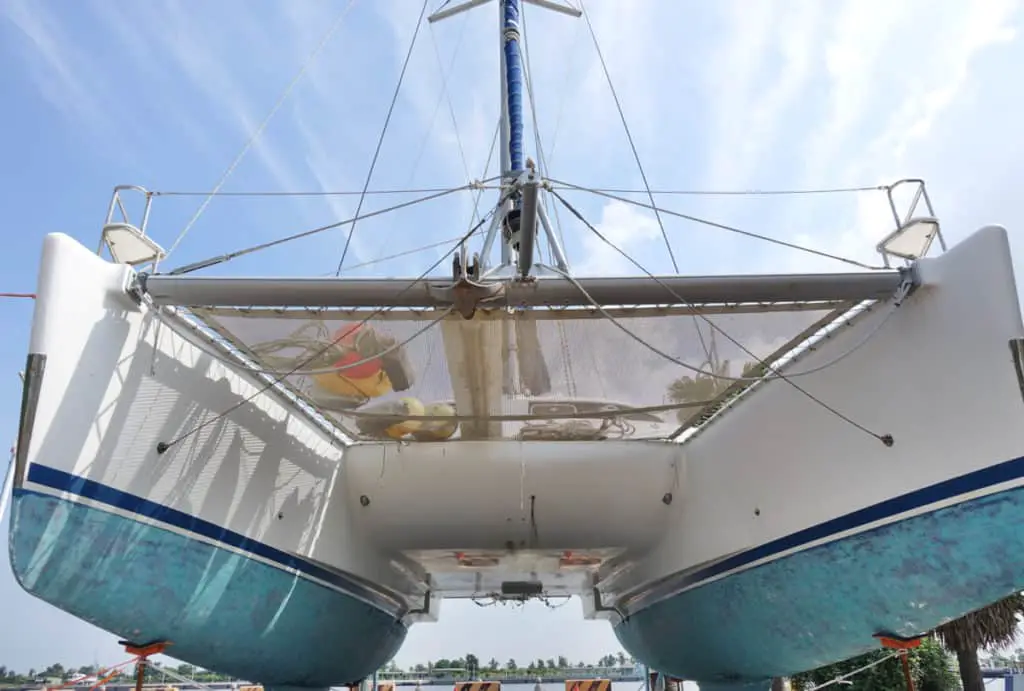
Catamarans Have Less Draft
Because catamarans rely on the buoyancy from their twin narrow hulls (instead of one wide hull on a monohull), they can handle a shallow draft without hampering either their stability or maneuverability. Cats also spread their weight equally between the twin hulls, which allows them to sit much higher on the water.
A shallow draft means a catamaran has more shelter options when bad weather is imminent . You can also anchor your boat much closer to the shore where it’s relatively safe.
You can actually park your cat on the beach, something that is referred to as “ beaching “.
They Are Incredibly Spacious
You might be wondering how ample space has anything to do with safety in rough seas. Let me explain. Catamaran layouts are well-thought-out, with spacious rooms being a major consideration. As a result, most areas, including the cockpit, main saloon, accommodation quarters, and galley, are exceptionally cozy. This enhances sailing comfort and also allows for 360-degree saloon views, which greatly improves visibility for the helmsman.
Another benefit is that there’s ample storage space, and all the sailing gear and equipment have a home. So, your gear is well-organized and stowed away carefully without crowding every available space. In rough seas, it helps the crew and anyone else on board avoid potential injuries from flying gear.
A large storage capacity also means larger fuel supplies. This is important, especially during rough weather as the engines work harder to motor through the strong currents hence they require more fuel.
Catamarans Do Not Heel
As mentioned earlier, ocean waves don’t affect catamarans as much as monohulls because, unlike monohulls, these boats don’t heel or roll (or at least not as much). This is why it’s easy to take a stroll either on the catamaran deck while under sail. The lack of heeling also makes it easier to handle the boat.
Still, due to the wide bridge deck fastened between two hulls, heavier seas could generate slapping or pounding sounds while underway (see bridgedeck clearance).
Check this article out to understand bridgedeck clearance!
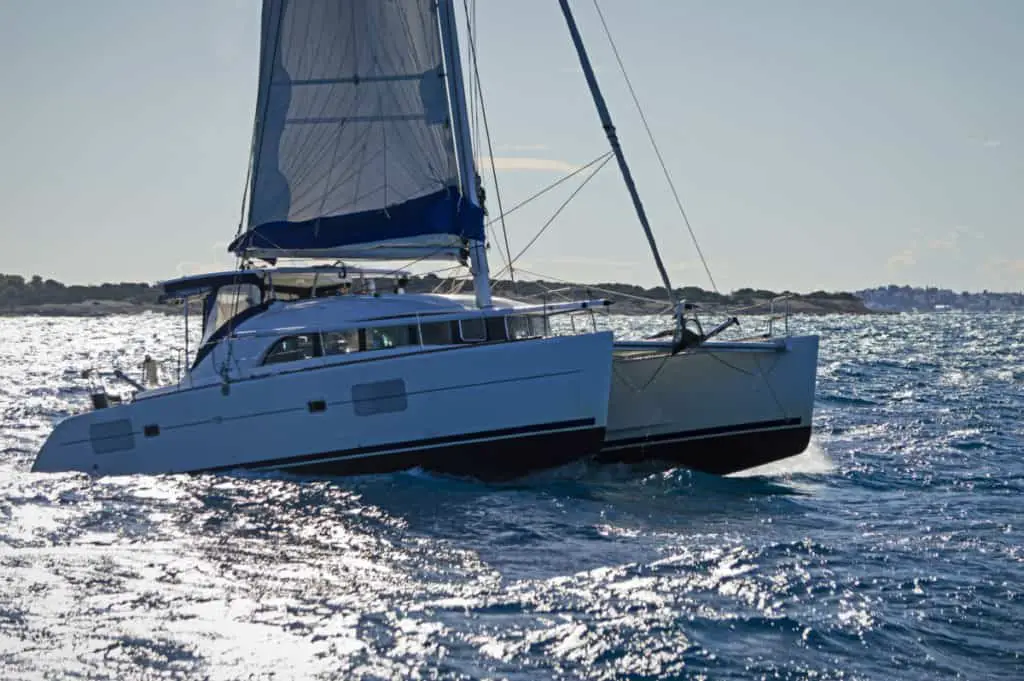
Catamarans Have High Speeds
The best way to keep your vessel safe is to avoid bad weather . But this is not always possible as you could still get caught up in a storm – despite the availability of weather reports. Fortunately, because catamarans are light, they deliver impressive speeds that you can count on at such times.
Fast speeds mean you can escape rough seas by outrunning storms and bad weather.
Cruising cats attain an average speed of 9 knots (10.5mph) while sport cruising cats can reach upwards of 30 knots ( 35mph). Also, performance cruising catamarans boast narrow waterline beams , generous sail plans, and centerboards that make them sail way faster than average cats.
Which Is Safer in a Storm; Catamaran or Monohull?
If comparing similar-sized vessels, a catamaran is much safer in rough seas and storms than a monohull.
This is due to several reasons:
- Catamarans have a larger platform: Because of its large and wide base, a catamaran is more stable and can withstand pounding waves much better than a monohull.
- Catamarans are faster. You are more likely to outrun rough weather in a cat than a monohull since its design enables it to sail much faster. Besides, the higher speed allows you to cover extensive distances in minimal time. This enables you to navigate through heavy sea conditions waters much more quickly or evade them altogether.
- Catamarans are easier to maneuver . Double engines make it easier to maneuver a catamaran in and out of tight spots, such as when getting into a marina or steering across small inland waterways. Monohulls, on the other hand, have only one engine, which could lead to trouble in case of engine failure during a storm.
- Catamarans have less draft. As mentioned earlier, a catamaran will sit much higher on the water than a monohull hence it can sail with ease on shallow waters. During a storm, it has more shelter opportunities and can pull anchor closer to the beach and away from the rough seas.
- Catamarans are not likely to sink. While a capsized monohull would right itself owing to its lead keel, a catamaran wouldn’t. Nonetheless, because of the positive buoyancy, a capsized cat would not sink, which isn’t the case for a monohull. The crew in a capsized catamaran can therefore wait for help onboard the floating vessel.
Are Catamarans Safe for Ocean Crossing?
Catamarans are sea-worthy vessels capable of making long sea passages. Larger catamarans are exceptionally safe for ocean crossing since they have lots of buoyancy and great roll inertia. They can sail through fairly uncomfortable conditions and handle strong winds without taking much of a beating.
Furthermore, the boats are not likely to capsize even when breaking waves hit them as these merely cause them to surf sideways.
Lastly, a cat’s ample storage capacity also means that it can carry enough fuel, water, and food for the passage . Hence, you need not worry about running out of your supplies in the middle of the ocean.
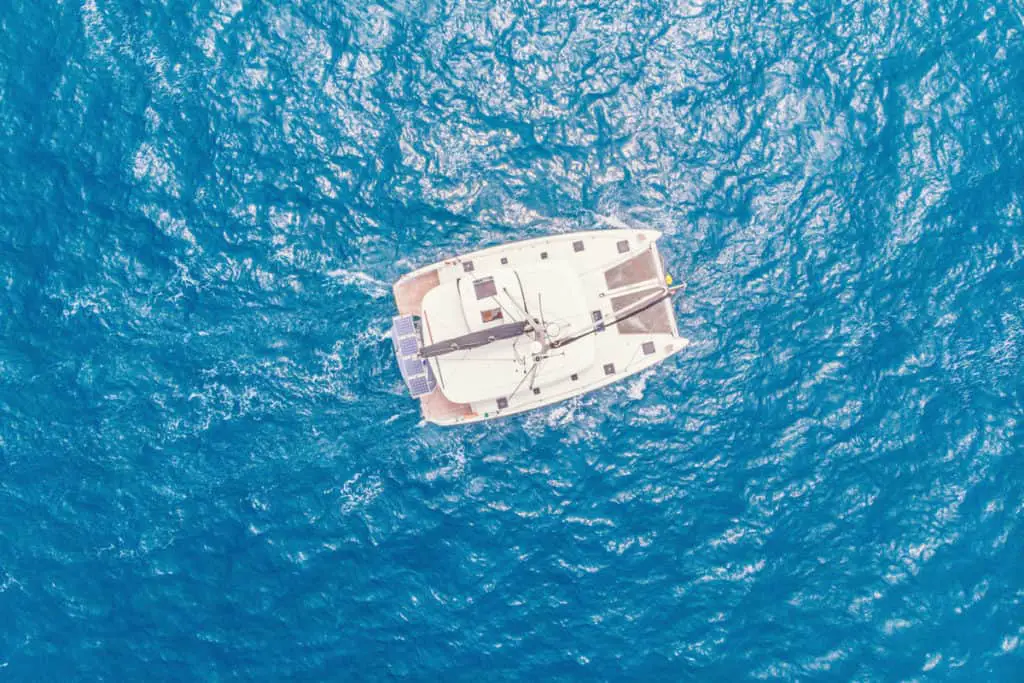
Do All Catamarans Perform the Same Way in Rough Seas?
Depending on catamaran design, performance will vary, a small boat (below 40ft) will be slower and react more to waves, a larger catamaran (+45ft) will move faster and be less impacted by heavy seas and strong winds.
In general, a vessel’s seaworthiness boils down to the construction quality, seamanship level, and boat design.
Nonetheless, high-performance cruising cats can sail windward faster than the best keelboats. Featuring efficient daggerboards, deep rudders, plus less displacement and windage, they deliver a good performance windward in all kinds of weather.
And since these catamarans are light in weight and contain ample sail plans, you need to pay special attention to your sail choice to maintain safety in all weather conditions.
But not all catamarans behave like high-performance cruising catamarans. Therefore, you need to have a deep understanding of how your boat operates before you set off into the open sea. This is only accomplished through spending time on the water.
Tips on How To Sail Safely in Rough Seas
There are fundamental safety measures as well as storm tactics. These are essential when sailing in any weather, but more so if you get caught up in rough seas.
- Undergo training. Get sufficient training on basic sailing and what to do in the event of an incident at sea. Basic safety drills are also important, and all crew should know the specific location of all life-saving equipment.
- Find out details about the expected weather. Make sure you are able to get updates while under sail, either through satellite or mobile network.
- Have the right protective equipment. Always have protective gear on board, including life jackets and vests, close at hand. Set up the boat with the appropriate safety lines and attach yourself to the same. Crew members should carry a knife, strobe, and whistle as well.
- Avoid putting your catamaran on the direct path of breaking waves (beam reach). Instead, opt for a course that places both the wind and high waves either ahead or behind the beam. Minimize the chances of a wave crashing across the deck by tacking in relatively smooth water.
- Park your catamaran. If the storm gets too intense, consider parking ( heaving-to ) your cat. This will give the boat some break from the windward pounding.
The specific storm strategies you need to use will crucially depend on the condition of the sea.
I would recommend you read the book Multihull seamanship ( amazon link ), the graphics are lame but the book is very informational, it walks you through procedures such as heave-to and what to do in case of emergency.
For additional tips on how to maintain the safety of your catamaran in rough seas, watch the video below:
Frequently Asked Questions
Should i run my catamaran straight downwind or angle it away from the waves.
It’s better to run downwind but at a slight angle since this will help increase the effective catamaran length by offering its diagonal distance to the following seas. The slight angle allows the bows to bury less, keeps the hull stable, reduces the risk of pitchpoling, and also makes it much easier to follow the sea.
How Much Sail Should I Use in Rough Seas?
When facing rough conditions it’s best to go with a minimal sail area (such as a storm jib). Minimal sail helps to calm the vessel, which makes autopiloting relatively easier. This means that you might not need to handle the helm, leaving the autopilot to do its work.
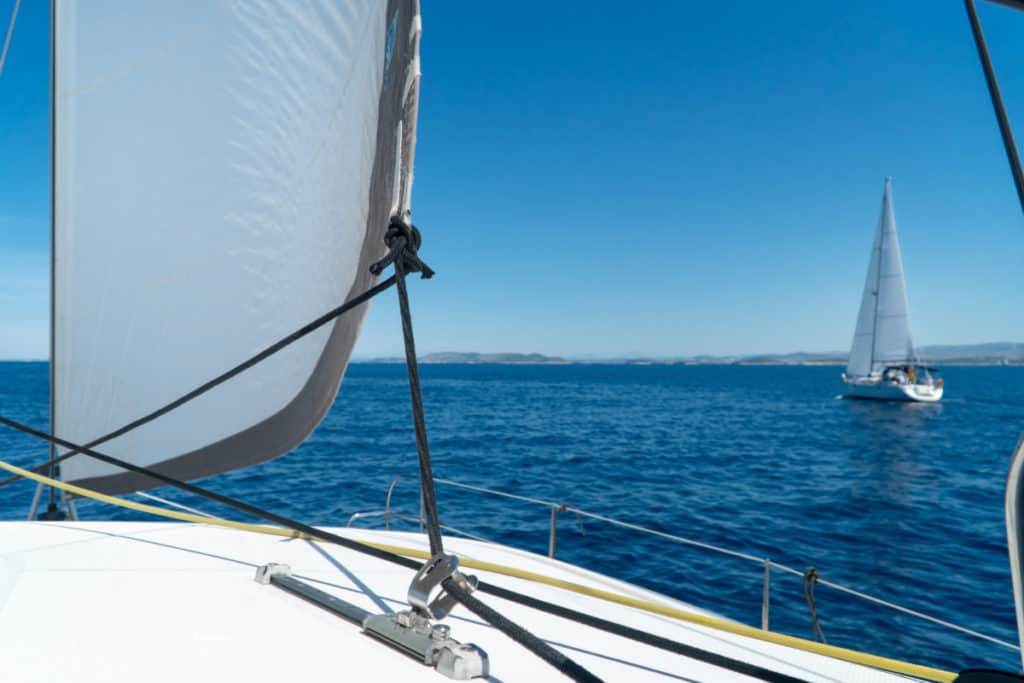
Does a Catamaran’s Length Affect Its Ability To Survive Rough Seas?
Yes, it does. A catamaran with a long waterline handles high winds and towering waves better than a small cat. The easier motion facilitates crew maneuvers, while the high boat weight increases resistance to tossing and rolling caused by the wind and waves. In addition, the higher speed helps in running from the storm.
What´s the perfect size cat for ocean sailing?
What Can Cause a Catamaran to Capsize?
A huge wave to the catamaran’s beam or surfing down a wave and burying the bows in the next wave, making it frontflip or pitchpole. To better understand catamaran capsize I suggest you read my scientific approach to understanding capsizing here .
Final Thoughts
Sailing in rough seas is a true test of seamanship. I used to be afraid of the seas, now it has become my friend. Maybe it will be the same for you! Take care!
Owner of CatamaranFreedom.com. A minimalist that has lived in a caravan in Sweden, 35ft Monohull in the Bahamas, and right now in his self-built Van. He just started the next adventure, to circumnavigate the world on a Catamaran!
Leave a Reply Cancel reply
Your email address will not be published. Required fields are marked *
Save my name and email in this browser for the next time I comment.
Recent Posts
Must-Have Boat Gear for Catamaran Sailors!
Sailing is probably the most gear-intensive activity I've ever done; there are so many decisions to be made about what gear to buy now, for tomorrow, and what to definitely never buy. The gear on...
6 Best Trailerable Trimarans For Bluewater and Coastal Sailing
Having a boat costs a lot of money, even when you are not using it, marina fees, etc. And once it is in the water most sailors never go very far from their "home marina" and sailing will be somewhat...

Catamaran Or Monohull? 27 Important Facts (Explained)
Catamarans and monohull boats are two very different kinds of vessels. Each craft offers distinct advantages and disadvantages that you’ll want to consider before choosing between the two.
In this post, we’ll go over some of the important things to consider when choosing between catamarans and monohull boats:
Table of Contents

Cost & Availability
Both catamarans and monohull boats come in small recreational sailing versions, larger motorboat versions, and larger sailing models. In all cases, the catamarans will cost more and will be harder to find.
The reason catamarans are harder to find because there are not as many of them, and they’re mostly made overseas.
Also, there aren’t as many catamaran manufacturers, so sailors have fewer options when buying them.
On top of this, catamarans have only recently become popular in the United States and other areas of the developed world. This means the used market for boats doesn’t have as many catamarans on it. You might find that you have fewer options when making a used catamaran purchase, which could bring costs up to a premium.
Two Times The Fun with Catamarans

Another reason that catamarans are more expensive than monohulls is the fact that catamaran buyers have to purchase two hulls, two engines, and two of all of the components that help make an engine work.
Traditional sailboats and large powerboats with one engine don’t have this cost issue.
On top of this, a catamaran is much wider than a monohull, and thus you have more space to build and equip.
On the other hand, once you’ve purchased the boat, you do get to enjoy the benefits of having two of everything. We’ll talk about the advantages of this further down in this post.
Maintenance Cost Makes A Difference
The maintenance on a catamaran is also more expensive than the maintenance on a monohull boat. This goes back to the fact that there is twice as much of everything to maintain.
Catamaran owners will need to do preventative maintenance on two different engines, and they’ll have two hulls and a large deck area to clean and maintain as well. If they’re getting the bottom of the boat treated, they’ll have to do this twice (once for each hull).
Even the interior components can usually be found twice.
Each cabin will usually have a head in it, so you’ll have at least two toilets and sinks to maintain, which obviously has its plusses and minuses.
One positive aspect of this is that catamaran owners do have the option of deferring some of their maintenance. For example, if one head is no longer functioning properly, you always have the second one that you can use.
It also adds a bit of safety as well.
This is because while the catamaran does have two engines to maintain, the owner does have power even if one of the engines happens to go down.
Some catamaran owners also like to point out that maintenance may not have to be done as frequently. This is because the engines don’t have to work quite as hard, and other items like additional bathrooms and sinks might only be used half as much.
How Much Space Do You Need?

A catamaran has more space than a monohull. This is because the boat is wider, and it has a much larger deck area. It also has twice as many hulls, so you have more overall space between the two of them.
The additional space is great for people looking to throw parties on their boats.
Most boat owners would agree that the catamaran is usually the party boat of choice at the docks.
Even if you aren’t into throwing parties, the extra space can still be nice for relaxing on the deck or getting a suntan. The wide-open space also makes it easy to use the boat as a fishing platform.
Additionally, you have more space for stuff like surfboards, rafts, and other items that can easily clutter up the deck of a monohull. Even fishing can be easier from a catamaran as the deck provides plenty of space between different anglers.
Catamaran owners also have additional space for carrying fresh water and adding generators and solar panels.
Interior space is generally more plentiful on a catamaran, and luxury catamarans have an easier time fitting large items like washers and dryers inside of them. You can have these on larger monohulls as well, but it will be harder to make them fit than it is in a catamaran.
On the other hand, all of the additional space means the catamaran owner has more space to maintain and clean. Also, all of the additional items that can be brought onto the boat will make it heavier. A heavier boat will use more fuel, and it will travel more slowly.
Living Quarters Vary Between The Two
The living quarters on a catamaran are much different than they are on a monohull. Most people would agree that the berths in a monohull are much more spacious than in a catamaran.
A monohull offers people the opportunity to have a large bed with space on either side to walk around it. This is great for couples who want to get out of bed without waking up their partner.
Catamarans, on the other hand, have the advantage of being able to offer large above-deck salon areas. The galleys, the dining areas, and the living areas can all be above-deck, while the two hulls can provide heads and berths.
Some boat owners say that living in a monohull is akin to living in a basement apartment . Other boat owners prefer the monohull because it brings them closer to the water and gives them the feeling of being at sea.
Privacy Can Be Prioritized On Catamarans
A catamaran offers up many different living areas that people can take advantage of. For example, each hull will typically have its own bathroom and bedroom.
This gives each sleeping area complete privacy from the other.
The living quarters are usually up on the deck, so early risers can wake up and move to these quarters without waking up the others.
The same holds for night owls. A night owl can stay up late without bothering the people who want to retire to their beds earlier.
With two hulls, large catamaran owners can hire a crew and give them their own hull to live in so that there is separation between the cruisers and the crew. This is a wonderful advantage for honeymooners looking to have their own space.
The downside to all of this, of course, is that sometimes a family may not want the additional privacy. For example, a family with small children might not want their children in a different hull than they are.
Additionally, the extra privacy can make it hard for people on the boat to communicate. This could become a big problem in the event of an emergency.
For this reason, it is often recommended that each hull have a radio in it so that the occupants can quickly communicate with each other. Remember, even in inland areas, cell phone reception may not be very good inside the boat hulls.
Recreation In a Monohull vs. a Catamaran
Most sailors agree that sailing a monohull boat is much more exhilarating than sailing a catamaran. Traditional sailboats heel, and sailors get instant feedback while they’re sailing. For the most part, catamarans stay stable, and you don’t get the same feeling with the movement of the wind and the water.
When it comes to monohull powerboats, you have the advantage of being able to pull water skiers, kneeboarders, and tubers with ease, as long as the boat has the power and a planing hull. A power catamaran usually doesn’t have the speed or maneuverability to pull off these recreational opportunities because they are displacement hull designs.
Catamarans excel in more leisurely recreational activities. A catamaran makes a great party deck as well as a great cruising deck. Catamaran owners can comfortably walk around a catamaran without having to worry that the boat might knock them over the next time it decides to heel. This allows boaters to sit and talk with one another comfortably.
A catamaran can also be used as a beaching vessel. This makes it a great platform for people looking to go swimming or fishing around sand bars and other shallow water areas. It also makes it a great boat for sailors looking to sail a larger boat on a river or lake known for having shallow areas.
Swimming and Diving
Swimming and diving off of a catamaran are usually much easier than doing the same from a monohull. The wide stance of the two hulls offers boat designers the option to put in staircases at the back of both hulls.
In between these staircases, some boats will have an additional diving platform and/or a dedicated frame for pieces of equipment and dinghy storage. This makes catamarans great for swimmers, snorkelers, and divers.
On the other hand, modern monohull sailboats can also have good transom stairs for easy access to the dinghy and swimming. Both types of boats can easily travel far out to sea, giving boaters the option of diving in areas that can’t be accessed from beaches and developed areas.
Boat Draft In Shallow Waters
For the uninitiated, the boat’s draft refers to how deep the boat’s hull sits within the water.
A monohull typically sits deep within the water, while a catamaran sits much higher on the water. This is why we stated that a catamaran is good for shallow waters.
The advantage of having a boat that can go into shallow waters isn’t restricted to just recreational activities like swimming and fishing. A boat that can go into shallow water is safer to operate in areas where a boat with a deeper draft might become damaged.
Additionally, a catamaran has more stability on calm waters. This helps make a catamaran more comfortable to relax or sleep on while at anchor or the dock.
The deeper draft of a monohull boat has its advantages as well. A deeper draft provides more stability in rough waters and allows a boat to go further into the sea.
For this reason, many coastal cruisers will prefer catamarans, while many ocean voyagers will prefer monohull boats. In fact, some areas of the Caribbean and the Florida Keys can be off-limits to boats with deep drafts as it simply isn’t safe for the boat to navigate these waters.
This isn’t to say that you can’t navigate these waters in a monohull boat, but you will have to be cautious depending on how deep your monohull’s boat draft is. You wouldn’t have this issue in a catamaran.
Stability On The Sea

A catamaran offers a lot more stability in shallow waters, in calm waters, at the dock, and anchorage. This makes the boat great for cruising and for relaxing in port.
A monohull offers a lot more stability in rough waters.
This makes this boat great for heading out to sea and for navigating vast distances.
Safety Issues To Consider
Both catamarans and monohulls can be built to navigate the waters they were made for safely. This will be determined more by the boat’s category designation rather than the type of boat.
However, each boat deals with unsafe situations in different ways. For instance, a monohull boat is likely to right itself if it is capsized.
This means that even in rough seas, you’re unlikely to find yourself permanently capsized.
The downside to this is that should you become completely swamped from a capsize in a monohull boat, you are much more likely to sink. In fact, if there is a hull breach on a monohull boat, your boat could sink.
Catamarans are said to be unsinkable. This isn’t completely true, but it is very unlikely that a catamaran will sink. Even if a hull is breached, you still have a second hull to keep the catamaran afloat.
However, a catamaran can’t right itself. If you capsize your catamaran, it will stay capsized.
One other safety concern to consider is that a monohull sailboat will heel while a catamaran will not. This increases the chances that someone could fall off the boat or onto the deck in a monohull boat.
Catamarans Are Faster Than Monohull Boats
A catamaran is faster than the average monohull boat.
This is because they face less water resistance, and their narrow hulls don’t have to deal with their own bow waves as a monohull does.
Of course, catamarans aren’t always faster. Old cruising catamarans may not go faster than 8 knots, and modern monohulls can exceed 10 knots.
Monohull boats tend to sail downwind and in choppy seas better than catamarans. This gives them a speed advantage during ocean voyages.
We have a separate post with complete average speeds per type of catemaran . It’s a must read if you are at all concerned about speed!
Fuel Consumption Considerations
Catamarans have two engines to burn fuel, which can drive up fuel costs.
However, a catamaran is lighter on the water, so it usually takes less energy to move a catamaran. This means you’ll end up using less fuel in a catamaran than you would in a monohull.
On top of this, catamarans can decide to use just one engine in low wind areas. This further decreases the amount of fuel that a catamaran consumes.
These rules only apply to calm waters.
A monohull navigates waters with high waves and strong winds much more efficiently than a catamaran. In this case, you’ll use less fuel in a monohull than you would in a catamaran.
Sailing Differences To Notice
Sailing a monohull boat can be exhilarating. These boats can glide through choppy waters, and you get to feel the motion of the boat as the sea rushes by the cockpit and the wind causes you to heel.
This type of sailing also provides instant feedback as you’ll know what you need to do with the sails as you’ll feel what is going on through the boat’s motion.
Sailors all over the world have been using monohull sailboats for years, and you’ll find plenty of outlets for recreational sailing with a monohull sailboat.
Sailing catamarans do not heel like a monohull sailboat.
These boats, therefore, do not provide the sailor with instant feedback. Also, if you incorrectly sail a catamaran, you do risk capsizing the boat more easily.
Training Can Be Quite Hard
Sailing a catamaran and sailing a monohull boat are two different experiences. People looking to sail either should probably get professional training.
Obtaining this training will always be easier with a monohull boat.
This is because monohulls are more popular, so you’ll have more instructors available to you.
Do You (Or Your Friends) Get Seasick?
People who are prone to getting seasick easily might want to consider a catamaran. A catamaran provides much more stability in calm waters, and you get a lot less movement.
On the other hand, people who are not prone to getting seasick might prefer a monohull in choppy waters.
This is because a monohull will deal with deep and choppy waters with high waves much better than a catamaran will.
As a result, a catamarans movement can seem extreme under these types of conditions. People who have never gotten seasick before can end up sick under these conditions.
Here’s a separate article we wrote with everything you should know about seasickness on Catamarans . There are some things you can do and some things you should know!
Docking Is (Usually) Easier With A Monohull Boat
Docking a catamaran can be a difficult endeavor.
This is because catamarans are often too wide to be docked within the slips located in central areas of a marina.
Because of this, they need to be docked at the end of the dock. This leaves them with fewer spots to dock. It also makes docking more expensive.
Catamaran owners traveling through areas that are unlikely to have many catamarans in them may find it difficult to find a dock at all. This is true in areas of the northern Atlantic where monohulls are much more popular than catamarans.
Storage Issues To Consider
Even storing a catamaran can be more difficult. This is because storage facilities often do not have the equipment to get a catamaran out of the water.
The wide width of these boats requires special lifts, and not all boat marinas will have them.
Storage facilities that do get the catamaran out of the water will often charge more money for it. They’ll charge additional fees for taking the catamaran out of the water, and they’ll charge additional fees for the actual storage of the boat as well.
Redundancy And Backup Equipment
We touched upon this earlier, but it is worth repeating that catamarans have many redundancy built into them. This can be a big advantage when it comes to safety.
For example, if one rudder becomes inoperable, the boat can still be steered with the other one. If one engine becomes inoperable, the boat can still be driven with the other one.
In extreme cases, a hull could become damaged, and you could still stay afloat because the other hull will keep the boat safely above water. These safety advantages can save lives and keep people from becoming stranded out at sea.
The primary downside is the maintenance issue that we mentioned earlier. All of these redundant components will need to be maintained. As a result, maintenance costs will be close to twice as expensive in a catamaran.
Cooking Is Easier On Catamarans

Cooking on a catamaran is usually easier than it is on a monohull. The main reason for this is that a catamaran doesn’t heel like a monohull, so you don’t have to worry as much about things falling over.
This not only makes cooking easier, but it makes cooking safer as well.
Additionally, catamaran galleys tend to have more space in them to move around. Also, they are often up on the deck, so you don’t have to climb in and out of the hull with your dinner in hand.
Dinghy Storage
Monohulls and catamarans can both hold dinghies. The larger the boat, the larger the dinghy can be.
However, catamarans have a wide area at the rear of the boat that is perfect for holding dinghies.
This makes getting in and out of the dinghy easier. Also, people can often have larger dinghies on their catamarans because the boat’s stern is so accommodating.
Power Generation Is Easy On A Catamaran
A catamaran has a lot of space for solar panels and wind turbines. Rigid panels can be placed in areas that won’t be walked on, like overtop of the bimini, and flexible panels can be placed in areas where the panels might end up getting stepped on.
The width of a catamaran even gives them more opportunities to put hydro generators into the water.
This means catamarans can generate more power than the average monohull boat can generate.
On the other hand, a monohull usually has less powered items to worry about. Monohulls need less power to operate at full capacity, so you may not need all of the additional space for generating power.
Ventilation Issues To Think About
Some people feel that monohull boats don’t offer enough ventilation. This is especially true in warmer areas of the world.
Catamarans also lack ventilation within their hulls, but fortunately for them, much of the living space is located up on deck. This gives catamarans an edge when it comes to cruising in warm weather.
On the other hand, monohull owners aren’t exposed to the cold winds that you might find up on deck in harsher climates.
This lack of airflow may actually be of benefit in this instance.
Some people find monohulls to be better looking than catamarans and vice versa.
This all comes down to personal preference, so you’ll have to decide for yourself which type of boat has the advantage in this case.
Some people think catamarans are the most elegant thing in the world while others prefer monohull boats as they look more classic.
Resale Value Is An Important Factor
If you read our extensive guide to boat depreciation per boat type , you know that no matter what boat you buy, it will always go down in value. This is just a sad fact of boat ownership that people need to consider before buying a boat.
Many factors go into how much you’ll be able to get for your boat when you resell it. These factors are the condition of the boat, the age of the boat, and the economy in general. For example, people are less likely to want to buy boats during a recession. This is especially true when it comes to smaller boats.
However, one additional factor that catamaran owners need to consider when thinking about resale value is the value of the dollar.
People from the United States don’t have many American catamarans to choose from and will usually need to buy these overseas.
This means that a catamaran will be less expensive to buy when the dollar is strong compared to the Euro and more expensive to buy when the dollar is weaker in comparison. This will affect the used market as well because higher values on new catamarans can help to bring up the value on the used market.
With a monohull boat, you may not have to consider situations like this as there are makers of monohull boats all over the world.
Don’t Let The Length Trick You!
One thought to keep in mind when comparing monohull boats and catamarans is that their different shapes account for different space advantages.
For example, a 40-foot long catamaran will have much more cubic space than a 40-foot long monohull.
Because of this, when comparing boats, you should look at the cubic space rather than the length. In this case, you may be comparing a 48-foot long monohull with a 40-foot long catamaran.
When you compare the two types of boats in this manner, the price differences aren’t quite as large, and the comparison is fairer. It also may make the operating and maintenance costs more similar.
This is an important distinction to make because the length of the boats can trick you!
Consider Trying Both (Before Buying)
Boats can be an expensive purchase, so it makes sense to try them out before you decide to make your purchase.
Rent each type of boat and use it on the types of waters that you intend to cruise on the most.
Try the boat out in different weather conditions as well, and don’t be afraid to do multiple rentals before you make your final choice. The time and money invested into making sure you get the boat you really want will be more than worth it in the end.
Click to share...
- Catamaran vs. Monohull: What Type of Boat is Right for You?
- Sailing Hub
- Sailing Dilemmas
- Catamaran vs. Monohull - which one should you choose?
When you are planning a sailing holiday, you’ll be faced with a choice; catamaran vs. monohull. Each type has many benefits, but it’s important to think about what your needs are because that will tell you just which one to pick!
Let's dive right in!
Ease of sailing
Maneuverability, space/layout, holiday vibe.
You may also like: Sailing holiday destinations for your next boat trip
One of the top considerations you should have is what type of sailor you are because catamaran vs monohulls offer a distinctly different sailing experience. If you are a first time sailor and just want something incredibly easy to handle, then a catamaran will probably win out.
Catamarans have great control when it comes to maneuvering in tight places. Since they have twin engines and rudders, you get a lot of control and can turn pretty much 360 degrees with ease.
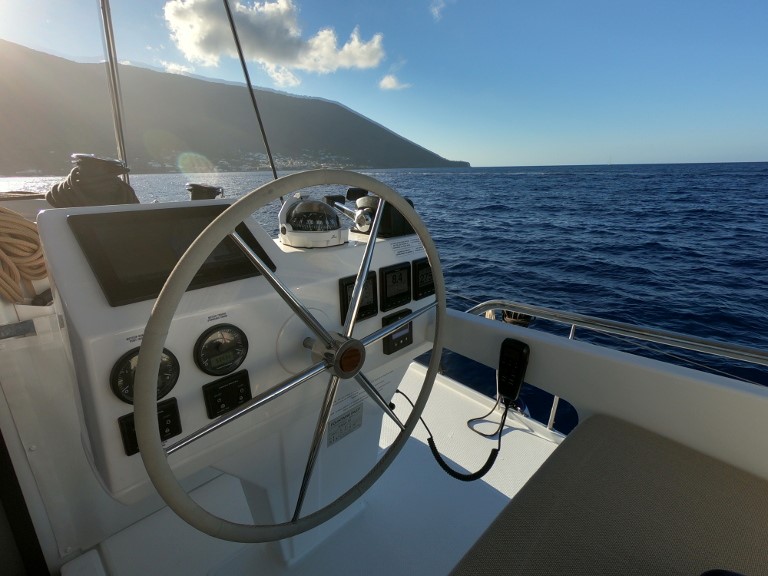
Catamarans also have a shallow draft, which will allow you to explore much closer to the shoreline than a monohull would be able to venture.
In the catamaran vs monohull speed debate, it might be more of a draw. Catamarans are typically 25-30% faster than a comparable monohull, but some argue that it comes at a price. When catamarans are sailing full speed you might experience a lot of slapping from the waves. Monohulls are designed to cut through the water. Also note that catamarans can be inefficient upwind and tack slowly.
When considering sailing conditions , a catamaran vs monohull in rough seas will perform very differently.
During rough sailing, you must be more vigilant when on a catamaran. The feedback from the wheel of a cat is not as obvious as that from a monohull. In high winds, you’ll need to know when to reduce sail.
However, monohulls tend to roll more in stormy weather, while catamarans stay pretty level even in rough seas.
When thinking about catamaran vs monohull stability, the stability that catamarans offer is a huge draw for many. Since cats bounce with the waves less, it is easier to walk around and enjoy the yacht while in motion. The increased stability is also great for children, or seniors, or anyone who might be prone to seasickness. When it comes to catamaran vs monohull seasickness, catamarans come out on top.
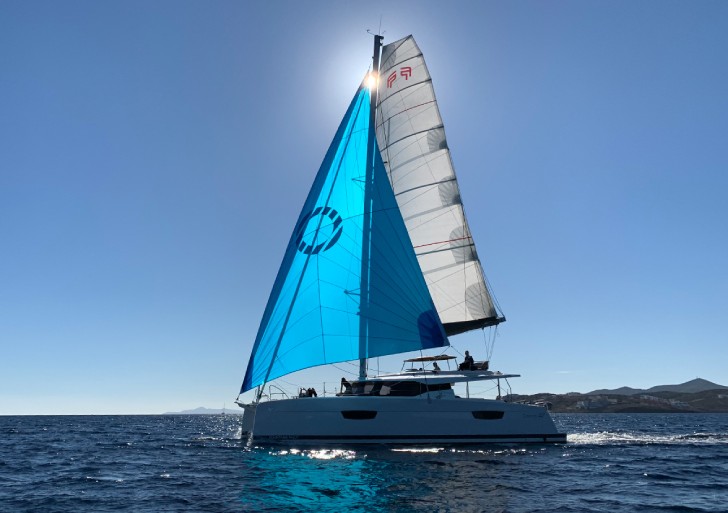
Although it is worth noting that monohulls swing less than catamarans if placed side by side in an anchorage.
If you’re deciding on a catamaran vs. monohull, you’ll have to think about what type of group you have. For family sailing holidays , maybe a catamaran is the best choice. Catamarans are very spacious, offering a large living space, and many cabin/head options. This makes them optimal for parties that want to spread out. Whether you’re a family, a big group of friends, or even couples looking for a 5 star, luxury experience who appreciate the extra space and comfort even if it’s not needed, a catamaran can fit your needs.
If thinking about catamaran vs monohull liveaboard readiness, the catamaran is a top contender. With far more living space and a much more spacious kitchen, Catamarans are great for people and groups that want to focus on entertainment and lounging.
Catamarans also typically have more spacious cabins and more privacy due to the layout with the cabins separate from the living area. This way you can send the kids to bed, and still enjoy the kitchen, dining, and living area.
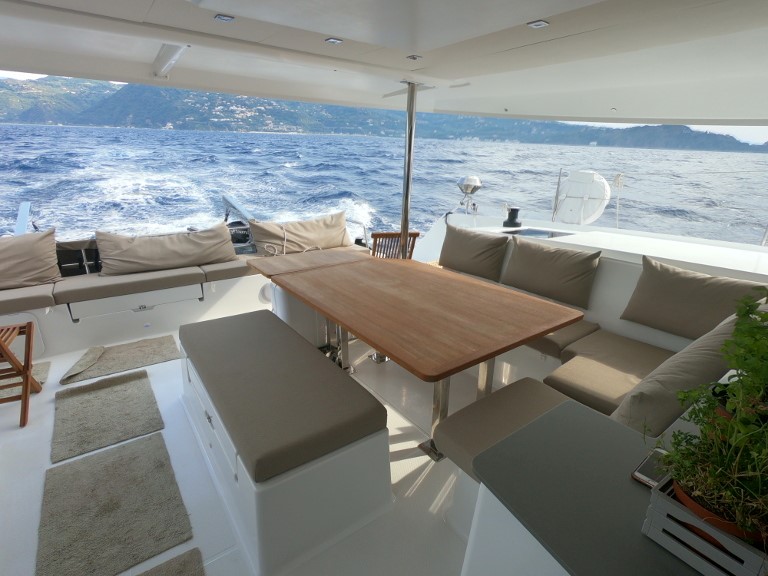
While catamarans are often touted for being roomy and luxurious, it’s worth nothing that monohull yachts can also be large and luxe. The Oceanis 62 and the Jeanneau 64 are top choices for those who want to live in the lap of luxury during their sailing holidays , while still getting that real sailing yacht experience.
In terms of catamarans vs monohull price , a monohull will definitely win. Charter prices for a catamaran can be 50-100% higher than that of a comparable sailing yacht. But that can be boiled down to the fact that you’re getting more space and more equipment with a catamaran!
A monohull, will only have one of everything - like it’s name suggests. It has one hull, one engine, one rudder, whereas a catamaran has twice the equipment and twice the living space of a monohull of the same length.
Another catamaran vs monohull cost to consider is the mooring costs. A catamaran, due to its twin hulls, might use two spots. Monohulls take less space to moor, and will be less expensive in that regard.
The cost of fuel should also be a consideration and in the question of catamaran vs monohull fuel efficiency, catamarans are the winner. With easy to drive hulls, and super light weight, they have great fuel efficiency.
Lastly, there is an abundant supply of monohull charters yachts, so the charter costs tend to be less to match the demand.
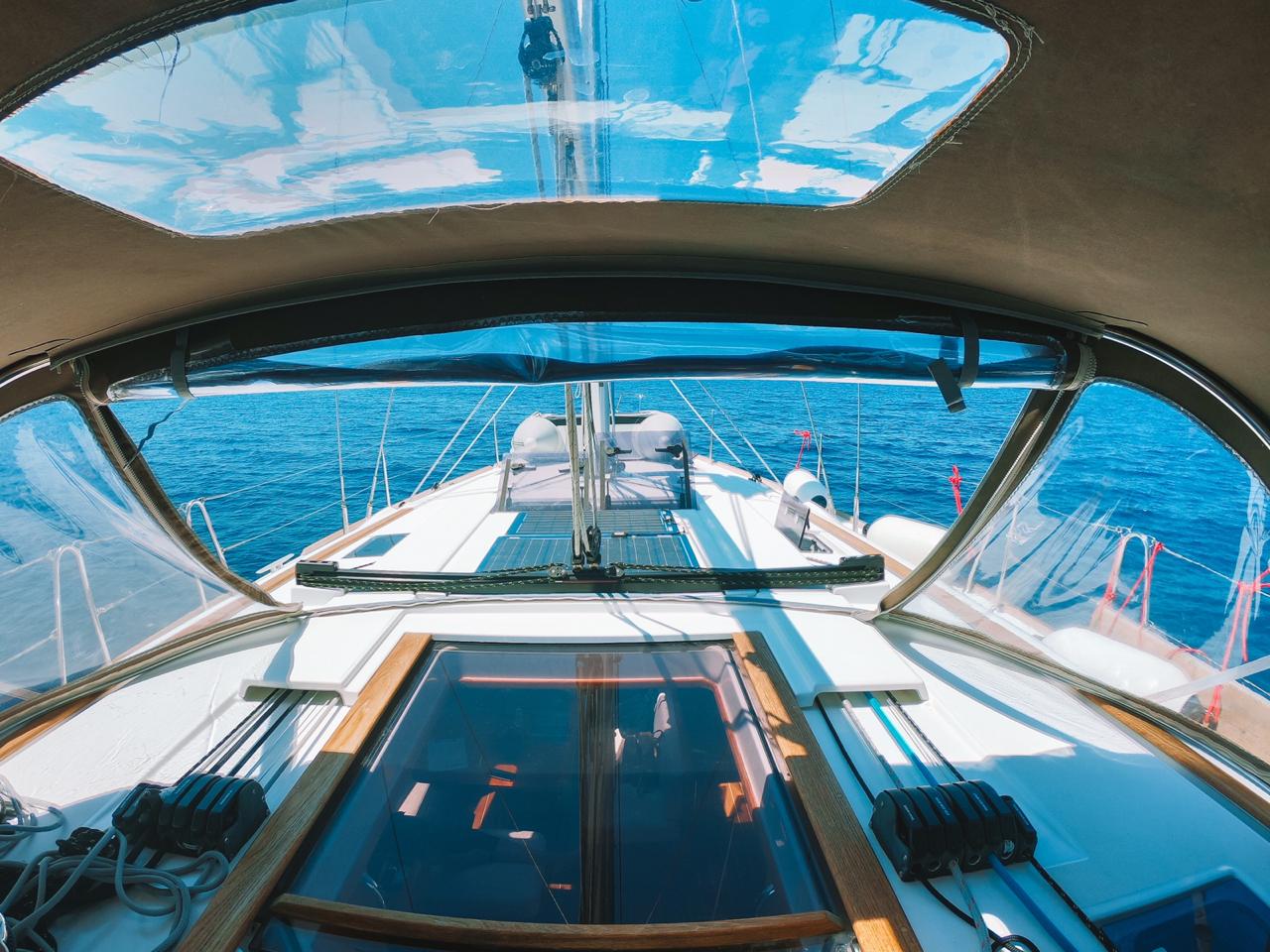
In the end, what it all comes down to is preference. In terms of performance, price, and comfort, catamarans and monohulls both have a lot going for them. You just need to decide what kind of holiday vibe you’re looking for, and Yacht4Less can help you with the rest!
At Yacht4Less we recommend fully crewed catamaran charters if you’re looking for top-of-the-line luxury and a super relaxing holiday where you don’t have to lift a finger. These boats will offer the space and comfort you’d expect from a 5-star hotel.
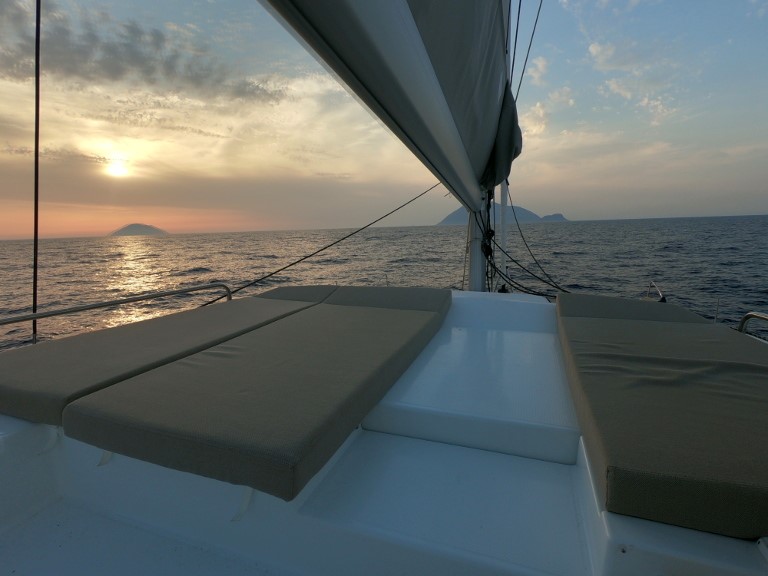
If you’re looking for a hands-on sailing adventure holiday, you might want to do a skippered charter with a monohull.. Your captain can show the ropes and help you learn how to sail. Or if you’re already an experienced sailor, go for a bareboat monohull charter . The exhilarating feeling of sailing a monohull is unmatched. It’s the classic romantic sailing experience, and makes for a thrilling holiday.
For those looking for a sailing experience somewhere in between extravagant luxury and exciting escapades, Yacht4Less is here to help you find the perfect boat for your needs. More sailing holiday dilemmas? We got you covered! Sailing Holidays vs. Land-Based Holidays » Party Sailing vs. Natural Wonders »
Get a free & non-binding quote

Catamaran vs. Monohull: We Changed, Should You?

There are two schools of thought when it comes to monohull versus catamaran. We have done extensive cruising and lived aboard two monohulls and four catamarans over the past 25+ years . We experienced the good and the bad for both single hull and multihulls first hand. Quite honestly, the pluses for catamarans far outweigh the minuses. There are multiple benefits of catamarans. They are faster, more stable and spacious, and have shallower drafts allowing safer anchorage closer to shore. Being on a stable platform with no heeling cuts down on crew fatigue and seasickness leaving the crew more alert and in control of the vessel. Even novice sailors feel more confident on catamarans.
When we built our monohull Royal Salute in the early 90s, catamarans were not established and were looked upon with extreme suspicion by most cruisers, including ourselves. “Safety and the capsize” issue were always the first things to come up against sailing catamarans. It is a fact that monohulls can get rolled in heavy seas but will right themselves because of the heavy lead keel, and while crew and vessel will be battered, the roll is survivable.
However a catamaran once capsized, will remain upside down (jokingly referring to this state of the catamaran as “reaching its most stable position when upside down”). The inability of a catamaran to self-right was and still is a major bone of contention. However, what is not often discussed is that a monohull has about a 5,000 pound keel of lead that is constantly trying to drag the boat to the bottom of the ocean versus a catamaran that has no ballast and is in most cases with modern catamarans, unsinkable.
So the options are to either sail the world on a boat that, if it springs a leak, will sink like a stone or a vessel that cannot self-right in the event of a capsize but will not sink no matter what. So from a practical point of view, here are our observations over the last 25+ years of living aboard, on the advantages and disadvantages of a catamaran.
ADVANTAGES OF A CATAMARAN
1. speed equals safety.
The speed of a catamaran makes it possible to outrun bad weather. While catamarans do not point as high into the wind as a monohull (or if it does, it makes more leeway or slides sideways), it is about 20% faster than a monohull. This means that even if you sail upwind at a slightly wider angle to the wind than a monohull and have to cover more distance, you will still arrive at your destination long before a monohull.
A modern performance catamaran with daggerboards and good quality sails will point as high as a similar sized monohull. It will point the same as a comparable monohull and sail much faster and therefore arrive at an upwind position much sooner than a the monohull. It is important to note that most of the production catamarans on the market are under-powered and are equipped with standard smaller sails. In lighter breezes many of these designs perform poorly unless fitted with bigger headsails, a Code Zero and a square-top mainsail.
While we believe that more comfortable and safer in rough weather , we have to concede that when the weather gets really bad (60 knots of wind or more) we would personally prefer to be on a monohull from the standpoint of surviving. I would say that a monohull is preferable for serious offshore single-handed sailing because you can more easily hove-to in a monohull. We have been in some extreme weather on a number of catamarans and never really felt that we were in danger, although it takes some nifty seamanship.
A monohull could capsize in extreme weather or even roll in a storm, but they generally come back upright. A catamaran on the other hand, will not right itself. But the cat will generally stay afloat, offering a good place to survive while you wait out the storm or until help comes along. Well-designed modern catamarans are very hard to capsize though.
Having said all that, most catamarans can do 200 to 250 miles a day and with modern technology allowing one to pull down weather at will, there is no good reason why you should get caught in extreme weather. A faster boat is a safer boat as it will in many cases be able to outrun bad weather. With good weather routing information a catamaran can avoid most serious weather and, at worst, place itself in the most favorable position to avoid the brunt of a storm.
2. A Catamaran is a Stable, Safe Platform Underway
Catamarans have no ballast in the keels like monohulls do and therefor it relies on beam and buoyancy for stability. Typically cruising catamarans will have a beam to length ratio of roughly 50%, although many designs nowadays exceed the 50% rule of thumb. So, a 45-ft long catamaran will be about 22-ft wide, providing a very stable platform when sailing. Unlike catamarans, monohulls cannot overcome the rolling and pitching with their narrow beam and the lead ballast for stability.
This rolling and pitching makes the deck on a monohull very unsafe whereas on walking around on the deck of a catamaran while underway is far easier since the boat is much more stable, and it doesn’t heel. This makes sail changes and reefing much easier and a lot safer for the crew. Without the rolling and pitching motion, the danger of falling overboard on a catamaran is considerably less than on a monohull.
3. Crew Fatigue Reduces on a Catamaran
Because a catamaran does not heel over like a monohull, it offers far more comfort underway because the motion is mostly fore and aft pitching and very little beam-to-beam rolling. On all points of sail, a catamaran tracks upright and significantly reduces crew fatigue and seasickness. Seasickness is usually caused by things like anxiety, fatigue, hunger and cold, which all add to a sense of disorientation. This leads the crew to making bad decisions and seamanship errors that could be fatal to the crew and vessel. The more stable platform of the catamaran will hugely keep those issues at bay, making the crew more alert and energized.
Every action and chore including cooking is much easier on a catamaran when underway. It is much more pleasant to be on the deck level looking out rather than being stuck “down below.” It is also much nicer to sleep on a boat that doesn’t heel. I remember nights at sea in our monohull when I was rolling around in my bunk unless I was properly wedge in a little corner. That is simply not the case on catamarans.
All these factors ensure that your crew will not expend unnecessary energy to simply try and stay upright, onboard and safe on a long passage. Your crew on a catamaran will be well rested and alert and will be able to function well if a stressful situation arises.
4. Comfort at Anchor
Catamarans provide a wide platform and therefore offer lovely spaces to relax at anchor without the rolling motion that monohulls have a tendency to do in a swell. During our 15 years of cruising on a monohull, we have often had to leave anchorages that we really were not finished exploring because of a rolly, uncomfortable anchorage. Big rollers or swells coming into an anchorage can make conditions in an anchorage very uncomfortable and unsafe.
We were anchored off Funchal on the island of Madeira in our monohull Royal Salute once, when we were forced to leave our anchorage. The rolling became so bad, we were rolling from gunnel to gunnel. The anchorage became untenable to remain anchored, forcing us to go out to sea in foul weather in the middle of the night. This is an extreme case but believe me, we have left many an idyllic anchorage because of a rolling swell into the anchorage. Catamarans, on the other hand, do not roll from like monohulls have a tendency to do and are far more comfortable at anchor.
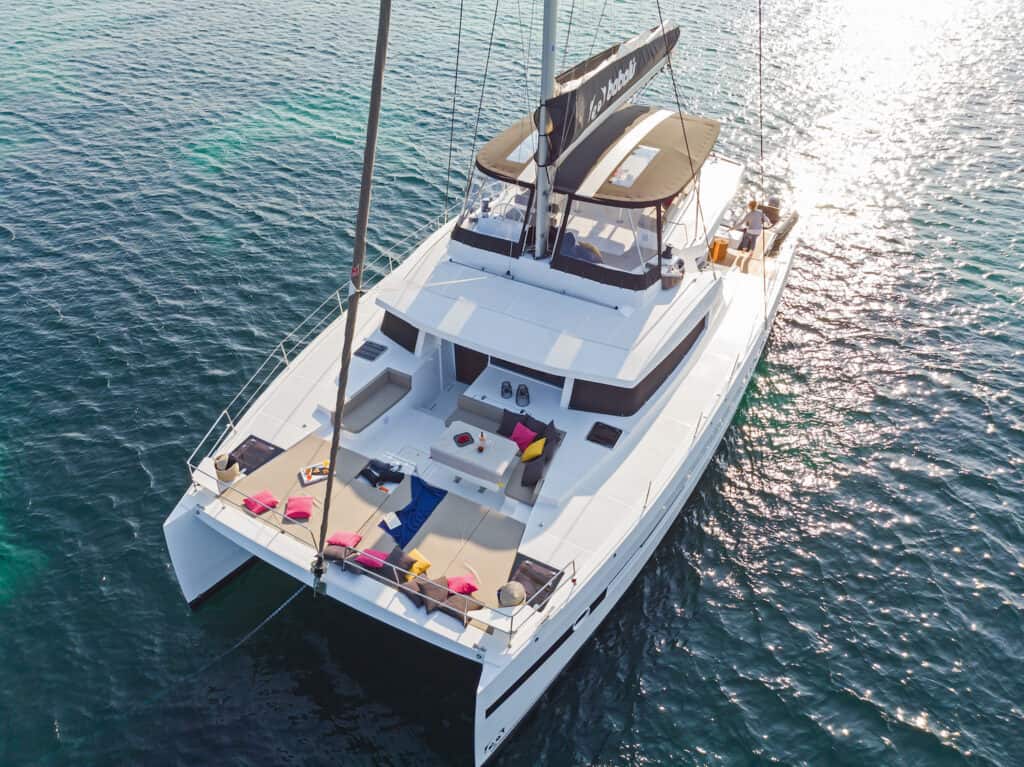
5. Anchor Bridal Setup

Catamarans are fitted with a bridle, attached to both bows and down to the anchor chain, resulting in a very stable position at anchor. What we found with our monohull was that because the bow acts as a sail (because of the high freeboard), the boat tended to sail at anchor in high winds. It sailed in one direction until the chain snatched and tacked over and sailed in the other direction, feeling like it might dislodge the anchor altogether. The catamaran on the other hand sits at anchor a lot more stable and doesn’t sail around as much.
6. Ease of Boarding on a Catamaran
Thank goodness we were much younger and more agile during our monohull days. Royal Salute and most monohulls of her generation or older, have high free-boards, making it quite a feat to get onto the boat from the dinghy. It was one of the most challenging things to do because unlike the more modern monohulls that have a scoop at the back, we had to climb up on the side of the boat to get on and off. We, of course rigged steps, etc. but it was always a hassle compared to the ease of getting on and off a catamaran from a dingy or from the water.
7. Shallow Draft Equals Better Anchorages
Catamarans have significantly shallower drafts than monohulls, allowing for safer anchorages closer to shore. Most catamarans in the 40-ft to 50-ft range draw between 3-ft to 4.5-ft, so they can anchor in places that a monohulls can not even consider. In the shallow waters of the Bahamas for example, the catamarans have a big advantage. We often anchor our own catamaran just a few feet away from a beach. It definitely allows one to be able to explore areas where the water is shallow without the fear of running aground.
The shallow draft also allows for emergency repairs in shallow water and even doing the bottom job when the tide goes out as we have done in places like Mtwapa Creek in Kenya, East Africa. The catamaran easily rests on her keels on the sand without help making it a breeze to do the “annual haul out” even in remote locations.
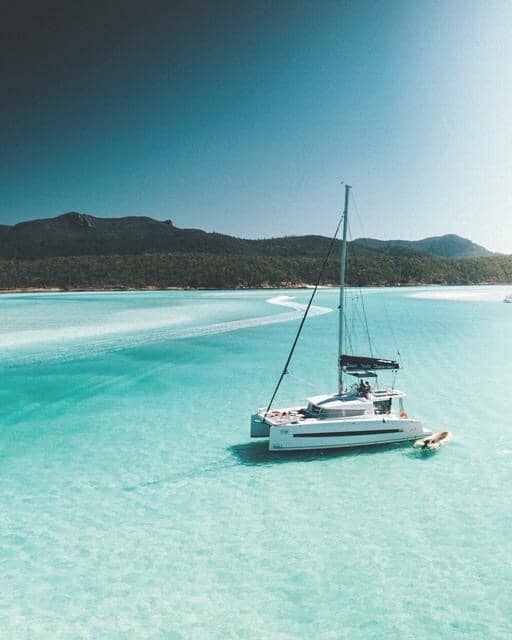
8. Dinghy Davits & Dinghy Size
All catamarans have a set of davits that make it very easy to raise and lower the dingy. Our monohull and most cruising monohulls do not have an efficient or easily accessible set of davits. This makes raising and lowering the dingy an elaborate production. Catamarans on the other hand, has davits systems easily accessible and some even have platforms to rest the dinghy on.
The lack of beam and difficulty of lifting the dinghy also limits the size and type of dingy that one can reasonably carry on a monohull. As we all know, the dingy is your transport to and from shore and diving or fishing spots, so the bigger and faster the dingy, the better off you are. A catamaran can carry both a heavier and bigger dinghy which makes the popular center consul dinghy so much more possible.

9. Interior Space and Comfort on a Catamaran
We sailed 32,000 NM on our 45-ft monohull, happy as clams, not realizing that sailing does not have to be done lying on your ear 24/7 while on passage or sitting knee-to-knee in the cockpit at anchor with your two other guests at the dinner table! One can liken sitting in a monohull cockpit to sitting in an empty Jacuzzi, you are always nice and close to the other folks.
Now that we are on our fourth catamaran, there are a few things that have become more evident to us than the incredible space and comfort of a catamaran, not only at anchor but also underway. The cockpit and living space in general are huge compared to a monohull, making for very comfortable and spacious living conditions. It feels more like you are at home, rather than just on a camping trip.
Knowing that one spends at least 90% of one’s cruising life at anchor, it’s important to have good open living space, which most modern cats nowadays offer. A lot of cats have walk around beds, lots of storage, every modern appliance including washer/dryer, etc. However, one has to fight the urge to fill the space if you want to keep the cat light and fast.

Sailing with guests onboard for extended periods of time, in close quarters can become claustrophobic but on a catamaran people are spread out and separated. With guests sleeping in one hull and the owners in another, catamarans offer much more privacy and separation. Some cats even have privacy doors that will close off the entire hull and has a separate entrance onto the deck, which really separates you from the guests completely.
There is very little heeling on a catamaran, so there is no need for hand grips and safety harnesses inside the boat. There is nothing better (and safer) than being able to walk from the cockpit into the living room (saloon) on one level or one step down at most. In a monohull, when heeling at a severe angle, you would have to claw your way from the companionway steps down to the living area, while fighting to stay upright, significantly tapping your energy.
Unless you hit extreme conditions, everything stays put on a catamaran reducing the anxiety before doing passages of having to stow and secure everything. This very issue makes a lot of cruisers reluctant to weigh anchor and explore more often. It is just too much effort to pack away all your stuff once comfortable in an anchorage!
One thing you will notice is that the stove on catamarans are not gimbaled like it is on monohulls and this should tell the story in itself. The stability and comfort on a catamaran is far superior. Cooking is easy and safer. I often open a nice cold beer, put it down to do something and forget about it only to find a warm beer later in the same place I left it. This is not something that happens on a monohull.
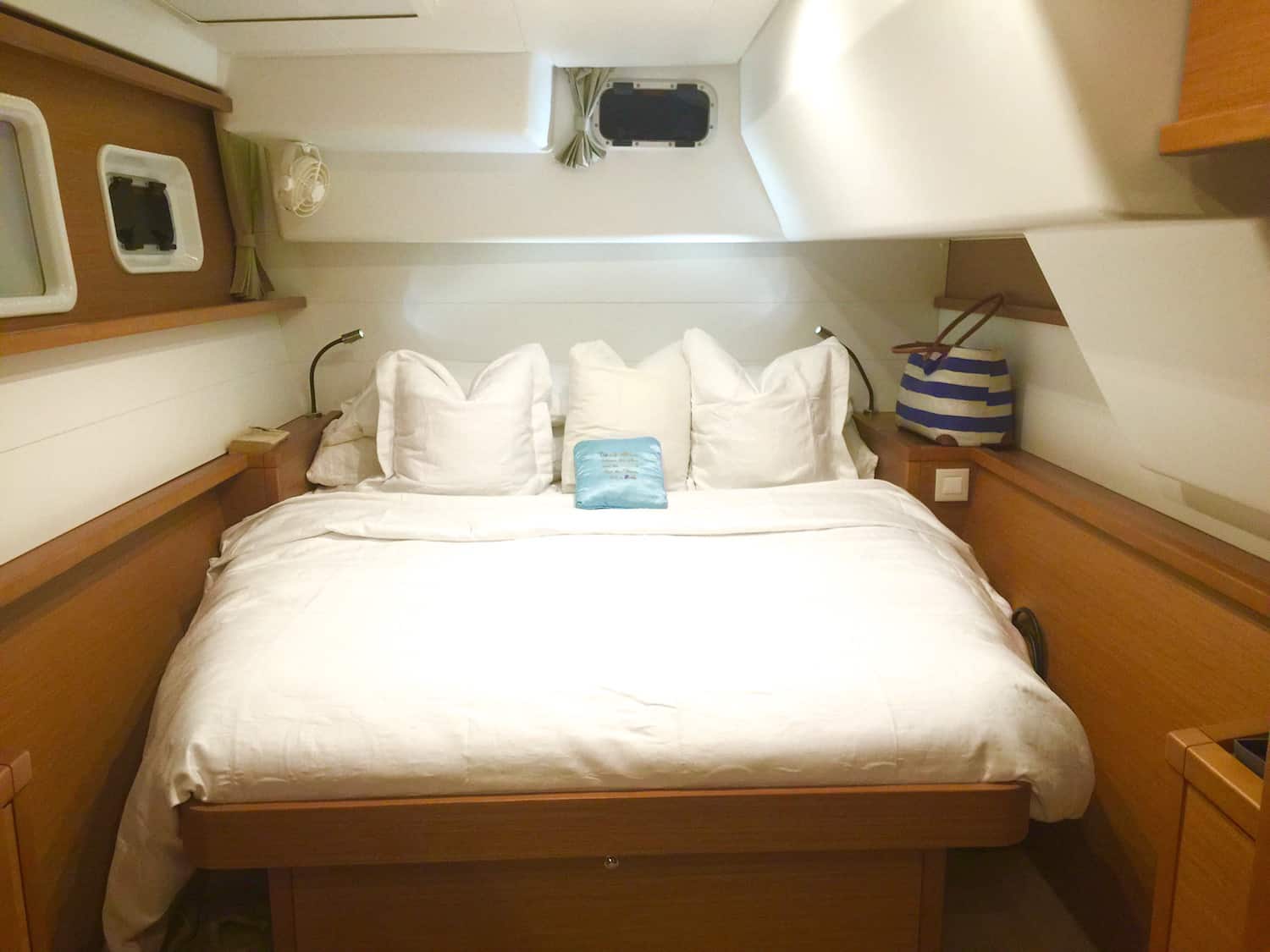
10. Redundancy on a Catamaran
Unlike monohulls, catamarans have a lot of critical redundancies. That of course means two hulls to clean and anti-foul, double the engine maintenance, etc. but having two of the critical equipment like engines for instance, outweighs the downside.
With two engines, if one fails you still have adequate propulsion to go anywhere. If by some fluke the second engine also fails, you have a full set of spares to fix at least one of them. Our friends once hit a sleeping whale off Tanzania, and when it dove, it hit the prop, bending it. They limped into the narrow channel on the one engine but at least they could make it to a safe harbor where we surveyed and repaired their damage.
We often only use one engine when motoring while making passage in order to conserve our fuel. The one engine is totally capable of moving the boat along at a good speed unless you are in heavy seas and you may need more power. Other than that we only use two engines to dock or maneuver the boat in close quarters.
Because there are two engines there are also two independent charging systems via the alternator on each engine. If one alternator goes out, there is still another complete charging system. There are two rudders and if one fails or falls off (as has happened to our friends on a monohull off Columbia, where they almost lost their boat) you have a second rudder that is completely capable of steering the boat by itself indefinitely. That holds true for several things on a catamaran!
11. Maneuverability
The engines are spaced far apart on a catamaran and it makes maneuvering much easier and more precise than monohulls, unless the monohull has a bow thruster. We did not have a bow thruster (not many monohulls do) and had to rely on prop-walk and using prop wash on the rudder. A modern catamaran can do a 360 turn on her own axis. A monohull cannot do this and have a bigger turning circle. However, a monohull under sail is much more maneuverable and certainly will tack a lot faster than a catamaran. The ease in maneuverability under engine on a catamaran in close quarters specifically, is vastly superior comparatively.
12. Rigging
Because of the beam on a catamaran the spinnaker pole has become unnecessary equipment. Hallelujah, I say. That pole on our monohull was a pain the behind and I always hated having to use it. On a catamaran, one can fly an asymmetrical cruising chute or spinnaker, using the bows to tack the clew or run a guy through a block so it is very much simplified, easier and safer.We also sail wing-on-wing with twin headsails when we sail downwind. We use our furling jib and furling Code Zero. It is as easy as one, two, three.
DISADVANTAGES OF A CATAMARAN
1. bridgedeck slamming.
One advantage most monohulls do have when underway is that they don’t slam. Catamarans with a low bridgedeck clearance can experience significant slamming in confused seas sailing upwind. This slamming can be quite disconcerting when you first experience it as we did on a Shuttleworth 44 design, our first ever catamaran experience, 20+ years ago. At times, it felt as though the boat was falling apart. Of course the boat was fine but nevertheless, the stress on the crew from the constant noise and discomfort was significant.
Monohulls don’t have a bridgedeck which means no slamming and are therefore a bit more comfortable than l ow bridgedeck catamarans when beating into severe confused conditions or “washing machine” conditions as we call it. Modern catamarans mostly have better bridgedeck clearance and the slamming is significantly less. However, not all cats have a good clear tunnel under the bridgedeck. Some manufacturers build beds into the bridge deck in order to make more space in the chest of the catamaran where the slamming occurs. These protuberances into the bridgedeck tunnel will likely increase slamming. So be mindful of that when selecting a catamaran. We currently own a Bali 5.4 and the bridgedeck clearance on this boat is more than adequate and the tunnel is clear. We therefor experience very little slamming compared to our Prout 45 that we previously owned (picture of sister ship below) with a much lower bridgedeck.
We Explain Bridgedeck Clearance
In the pictures below, the Bali 5.4 has very good clearance from the water to the bridgedeck and has a nice clean tunnel versus the very low bridgedeck of the Sunreef 50.

2. Sailing Downwind
Monohull spreaders are set at 90 degrees to the mast whereas a catamaran has to have backswept spreaders. The reason is that, on a monohull, there is a backstay and using this, plus the intermediates you can get a nice pre-bend in the mast (the pre-bend is to flatten out the main sail and allow for better performance).
On a catamaran with no back stay, you need to use the back swept spreaders and the diamonds to pre-bend the mast. The reason I point this out is because on a catamaran, if you want to broad reach or run, the mainsail cannot be let out all the way because the backswept spreader tips could punch holes in the fabric.
On a monohull, the spreaders are at 90 degrees so you can let the main and the boom out much further which is, of course, much more effective. This is one of the reasons it is better to broad reach and tack downwind on a catamaran.
Whether a monohull or multihull, sailing dead downwind doesn’t usually make great VMG. Therefor a regular cruising cat, much like a monohull, needs a lot of sail area and has to sail deep downwind if it is to achieve a decent speed made good (VMG). This video demonstrates how we achieve this by sailing wing-on-wing downwind.
It is more difficult to find a dock either as a transient or a permanent slip for a catamaran in general because of the wide beam. But this is changing fast and will soon not be too much of an issue. In the USA dockage is charged by the length of the boat in feet, so there is no disadvantage there but, in some places, (the Mediterranean for example), dockage is charged at length times one and a half because of the additional beam.
Since the catamaran is stable at anchor, we mostly anchor out. We have more privacy, a better breeze and usually a stunning view.We have a nice dinghy with a good outboard engine and is big and comfortable enough to get to shore fast and together with the modern conveniences like the generator, watermaker and washer/dryer, docking becomes a non-issue.
It is definitely more difficult to find a travel lift with enough beam for a catamaran for a haulout, while, for a monohull, there are absolutely no problems anywhere. The wide beam of cats also greatly limits the number of shipyards that can haul them out. Most catamarans over 40-ft must be hauled out with a 50-ton travel lift. This not only increases the cost of the haulout, but greatly limits the choice of the shipyards for repairs and maintenance. With limited choice, prices are high for shipyard services.
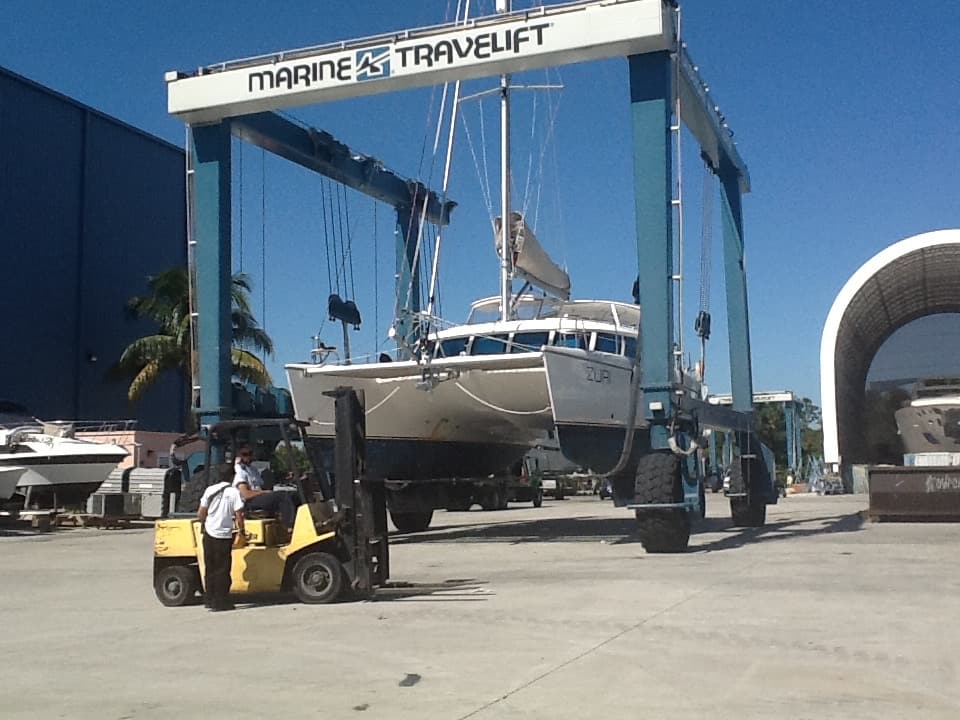
Catamarans do tend to have a lot more windage than monohulls. This can be an issue especially when maneuvering in close quarters with a strong wind. But I have found that, provided the engines are powerful enough for the size of catamaran, that twin engines negate this problem. Also, many modern large catamarans now have a bow thruster fitted. It is super easy to dock.
The cost of getting into a catamaran is much higher than that of monohulls. That could put a serious dent in your cruising kitty or require you to put your dream on hold a little longer. Pre-owned monohulls on the other hand are very cheap to buy comparatively, because the supply presently far outweighs the demand.
Catamarans are in high demand and they typically hold their value much better and longer and the trend is now heavily in favor of the catamaran market. When prospective buyers contact us for catamarans under $250,000 the choices are very limited and catamarans under $100,000 is near impossible to buy. In this case, your best bet is to go with a monohull unless you go with much older boats like the Prouts or the less expensive Geminis.
Our Own Catamarans & Monohulls
FYI: Royal Salute , a Bruce Roberts 45 monohull, was the first boat we owned and sailed approx. 30,000NM on. Mythral, a Seafarer 30, was our “toy boat” while we were waiting for our catamaran to be built. Even though this classic little monohull sailed around the world, it didn’t have much in modern conveniences like running water. Siyaya was an Island Spirit 40 catamaran that we sailed from Cape Town to Florida on and then taught live-aboard sailing classes for several years. Zuri I was a Prout 45, a beautifully crafted catamaran but by today’s standards is considered old technology. Our Lagoon 450 SporTop ( Zuri II ) is a fantastic live-aboard catamaran. We lived and taught aboard her for three years but sold her last year and we currently own a Bali 5.4 ( Zuri III or Z3 as we call her now). Read about our various boats .

CONCLUSION: CATAMARAN vs MONOHULL
We were dyed in the wool monohull sailors for 15+ years. We loved the pretty lines of monohulls, the sailing ability and what we believed at the time to be much safer vessels. However, now that we have been avid catamaran enthusiasts, we simply can never go back to monohulls. Catamarans have come of age and with modern technology have overcome most objections that sailors of old had against them. They are well designed and built, are safe, and we simply love that they sail fast and upright. There is not a whole lot to dislike about a catamaran when you live aboard. We have weighed all the pros and cons of catamarans and found that the pros far exceed the cons. We made the change to a catamaran and do not regret it one bit!
We hope that this article will clear things up for all the prospective catamaran owners out there.
Contact us if you have any questions regarding catamarans, Fractional Yacht Ownership or our Charter Management Programs .
Estelle Cockcroft
Join our community.
Get the latest on catamaran news, sailing events, buying and selling tips, community happenings, webinars & seminars, and much more!
4 thoughts on “Catamaran vs. Monohull: We Changed, Should You?”
I read that the engineering on the catamarans were improved over the years. Whats the oldest year would you recommend designwise?
Scott, my apologies for the late reply. We’ve been traveling in Africa. Anyway, catamarans have come a long way and improvements in technology is happening at lightning speed. I reckon that even the older model catamarans are good. It depends on what your needs are. If you want something a little better performance wise, I would go for something no older than 15 years.
After buying a catamaran what is the difference in expense of a catamaran vs a monohull. Many articles state that not only the initial cost of a catamaran is more it the operating cost as well.
Hi Todd, it is more expensive. The annual dockage and haul out as well as maintenance will be more expensive. You obviously have two engines to maintain and various other pieces of equipment to service in both hulls. While there is more equipment there is also more redundancy and of course you have the comfort factor. So, depending on your situation, it’s probably worth it.
Leave a Comment Cancel Reply
Your email address will not be published. Required fields are marked *
Save my name, email, and website in this browser for the next time I comment.
Recent Posts
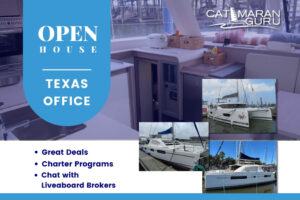
Texas Open House
Join us April 13 – 14 for our open house at our Texas office during the

First-Annual Virgin Islands Boating Exhibition (VIBE)
VIBE – It’s a Destination Boat Show! Join us May 10 – 12 at
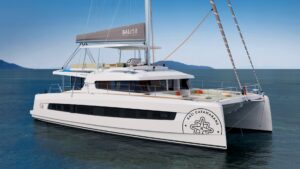
BALI Catamarans Unveils The New Bali 5.8 Flagship
CATANA GROUP launches its 14th BALI CATAMARAN model, the BALI 5.8, for the brand’s

Love Stories At Sea…because it’s valentine’s day
Because it’s Valentine’s day, we wanted to celebrate all the couples that we helped

For more than 30 years, we have been a part of the catamaran community and created Catamaran Guru™ to encourage and educate all the aspiring sailing out there. We understand the dream of traveling the world by catamaran and created a one-stop-shop to make that dream a reality for you.

- Stephen & Estelle
- Testimonials
Get Started
- Yacht Sales
- Used Yachts
- Charter Management
- Boat as Business Programs
- Seminars & Events

Catamaran Vs. Monohull: Which Is Better?
When considering sailboats for cruising or liveaboard purposes, two primary options often come to mind: catamarans vs. monohulls. We know, because we’ve been there!
Having sailed full-time for four years on a monohull before swapping to a catamaran with the impending arrival of baby, we really understand the whole catamaran vs. monohull debate, and it isn’t clear cut.
Both types of vessels have their own unique characteristics, advantages, and considerations. Understanding the differences between catamarans and monohulls can help individuals make an informed decision based on their specific needs and preferences.
Catamarans are known for their spaciousness, stability, and comfort. With their twin-hull design and wide beam, catamarans offer generous living spaces, expansive decks, and increased privacy with separate hulls.
The stability provided by the twin hulls creates a smoother ride, reduced rolling motion, and enhanced comfort in a variety of sea conditions. Catamarans also tend to have better maneuverability, fuel efficiency, and shallow draft capabilities.
On the other hand, monohulls are characterized by their sailing performance and versatility. Their single-hull design, deep keel, and ballast provide excellent upwind performance and responsiveness.
Monohulls offer a traditional sailing experience with the sensation of heeling and a closer connection to the water.
They are often more cost-effective in terms of initial purchase price and maintenance expenses. Monohulls also provide more options for docking in marinas with narrower slips.
Choosing between a catamaran and a monohull ultimately depends on individual preferences, intended use, and priorities.
Factors to consider include space requirements, stability preferences, sailing performance, budget, cruising plans, and personal comfort levels. Spending time on both types of boats and seeking advice from experienced sailors can help in making a well-informed decision.
In the following sections, we will delve deeper into various aspects of catamarans and monohulls, exploring their advantages and considerations, including stability, speed, cost, maintenance, maneuverability, and more.
By examining these factors, individuals can gain a comprehensive understanding of which type of sailboat may be more suitable for their specific needs and aspirations.

As an Amazon Associate, we earn from qualifying purchases. We also earn from other affiliate programs. This means we may receive a small commission on products purchased through our links at no extra cost to you.
Table of Contents
Which is better catamaran vs. monohull, the advantages of catamarans, the advantages of monohulls, the disadvantages of catamarans, the disadvantages of monohulls, are monohulls safer than catamarans, maintenance, ability to maneuver.
- Fuel Efficiency
Which Is Better In Rough Seas?
- Which makes a better liveaboard Sailboat?

There are lots of advantages to both catamarans and monohulls. Both can be excellent sailing or power vessels and suit various different needs. There is always a big debate among sailors about which is actually better and honestly, we don’t have the answers!
There are so many plus and minus points for each that it’s hard to come to a logical conclusion without knowing a certain sailor’s needs first.
What advantages does one have over the other? Let’s explore that now to help you decide which one is right for your individual needs.

Catamarans offer several advantages that make them popular choices for various marine applications.
One key advantage is their superior stability. The two parallel hulls provide a wide base, which distributes the weight evenly and reduces the likelihood of tipping or rolling. This stability is especially beneficial in rough seas, making catamarans a preferred choice for cruising, offshore sailing, and passenger transportation.
Another advantage of catamarans is their speed performance. The twin hulls reduce drag and increase buoyancy, allowing them to achieve higher speeds with less power.
Catamarans are often faster than monohull boats of similar size, making them popular for racing, chartering, and personal use. The speed advantage of catamarans can be particularly appealing for those who enjoy thrilling water sports or need to reach their destinations quickly.
Catamarans are also known for their fuel efficiency. The design of catamarans minimizes drag and weight, enabling them to achieve higher speeds with less power and fuel consumption compared to monohull boats.
This advantage becomes especially significant during long-distance cruising, where fuel costs can be substantial. The fuel efficiency of catamarans not only saves money but also contributes to a more sustainable and environmentally friendly boating experience.
In addition to stability, speed, and fuel efficiency, catamarans offer other advantages as well. Their wide beam provides ample deck space, offering more room for socializing, entertaining, and enjoying outdoor activities.
Catamarans often feature spacious cabins, making them comfortable for extended periods on the water, whether for leisurely cruising or living aboard. The dual hulls also provide increased buoyancy, allowing for shallower drafts and access to more secluded anchorages and cruising grounds.
Furthermore, catamarans generally have shallower keels compared to monohulls, which allows them to navigate in shallower waters and access remote areas that might be inaccessible to deeper-draft vessels . This versatility opens up a broader range of exploration possibilities for catamaran owners.
Overall, the advantages of catamarans, including stability, speed, fuel efficiency, spaciousness, and versatility, make them attractive options for a variety of boating enthusiasts.
Whether for leisurely cruising, racing, chartering, or living aboard, catamarans offer a unique combination of features that enhance the boating experience.

Monohull boats offer several advantages that make them popular among sailors.
One of the key advantages is their excellent seaworthiness, particularly in challenging conditions. The deep, V-shaped hulls of monohulls provide stability and a smoother ride through waves and choppy waters.
This design allows monohulls to cut through the water efficiently, making them well-suited for offshore sailing and bluewater cruising.
When out in huge waves during an unexpected storm I found it hard to imagine how a catamaran would cope compared to our heavy bluewater monohull that just plowed through the waves as though they were butter.
Another advantage of monohulls is their superior upwind performance. The single hull design allows them to tack more effectively and maintain a higher pointing ability, making them ideal for sailors who frequently navigate against the wind. This advantage is particularly important for racing sailors and those who enjoy exploring areas where upwind sailing is common.
Monohull boats are typically more maneuverable than catamarans. The single hull allows for sharper turns and greater agility, which can be advantageous in tight spaces, marinas, or when docking.
The ability to maneuver easily makes monohulls more versatile in navigating narrow channels, entering small harbors, or handling in confined areas.
Additionally, monohulls offer a wide availability and variety of models, sizes, and configurations. They have been the traditional and widely available choice in the boating industry for a long time. This abundance of options allows boaters to select a monohull that suits their specific preferences, needs, and budget.
Monohull boats also often have a lower initial cost compared to catamarans of similar size and quality. The construction and design of a monohull are typically simpler, resulting in a more affordable purchase price.
This cost advantage can be significant for individuals or families entering the boating world on a limited budget.
Finally, monohull boats are generally easier to dock and berth in standard marina slips. Their single hull design allows for straightforward docking procedures and fitting into narrower slips designed for monohulls.
This advantage simplifies the process for boaters who frequently visit marinas or require regular docking facilities.
It’s important to note that the choice between a monohull and a catamaran ultimately depends on individual preferences, intended use, and specific requirements. Both types of vessels have their unique advantages and considerations, and it’s crucial to carefully evaluate these factors when selecting a boat that best suits your needs.

Catamarans, despite their advantages, also have some disadvantages that should be taken into consideration.
One notable disadvantage is the cost. Catamarans are generally more expensive than comparable monohull boats. The construction, materials, and design complexity of catamarans contribute to their higher price tag.
Additionally, maintenance, docking fees, and insurance costs can be higher due to the larger size and wider beam of catamarans. We’re only just starting to find out just how much more they cost, and it isn’t insignificant!
Another disadvantage of catamarans is the limited availability of berthing options. The wider beam of catamarans can pose challenges when it comes to finding suitable berths in marinas. Many marina slips are designed to accommodate monohull boats and may not have sufficient space for catamarans.
This limitation may require catamaran owners to seek specialized marinas or rely more frequently on anchoring.
The wider beam of catamarans can make maneuvering more challenging, especially in tight spaces, narrow channels, or crowded marinas. The increased width may require additional care and skill when docking or navigating in confined areas. Catamarans may also require specialized docking arrangements or wider slips to accommodate their size.
In heavy weather conditions, catamarans may experience some performance limitations. While they generally provide excellent stability, their wider beam can make them more susceptible to windage and slamming.
The larger surface area exposed to the wind can result in more resistance and difficulties maintaining course in strong winds. Skillful handling and careful sail management are necessary to optimize performance in challenging weather conditions.
Additionally, some sailors enjoy the heeling sensation experienced on monohulls when sailing close to the wind. Catamarans, with their stable platform, lack this sensation since they do not heel to the same degree.
This absence of heeling can be seen as a disadvantage for sailors who enjoy the dynamic experience of monohull sailing.

Monohull boats also have their own unique set of disadvantages.
One of the main disadvantages is their stability compared to catamarans. Monohulls typically have a narrower beam and a single hull, which can make them less stable in certain conditions, particularly in rough seas.
This may result in more rolling and pitching motions, which can be uncomfortable for some passengers.
Another disadvantage of monohulls is their potential for heeling. When sailing close to the wind, monohulls have a tendency to heel or lean to one side. While this is a characteristic appreciated by many sailors, it can be a disadvantage for those who prefer a more stable and level sailing experience.
Monohulls also tend to have limitations when it comes to living space and interior layout. The narrow beam of monohulls can result in smaller cabins and reduced interior space compared to catamarans. This can be a consideration for individuals or families looking for more spacious accommodations on their boat.
Additionally, monohull boats may have more limited access to shallow or restricted areas due to their deeper draft. The single keel design of monohulls often requires a deeper depth requirement, which can limit their ability to explore certain cruising grounds or navigate shallow waterways.
Lastly, monohull boats generally have a lower initial stability when at rest compared to catamarans. This means that while they may have better stability underway, monohulls can feel less stable and more susceptible to rolling when anchored or at the dock.
This may require additional measures such as stabilizers or careful weight distribution to enhance stability at rest.
Comparing Catamarans Vs. Monohulls

We’ve compared some of the most important factors to consider when choosing a boat.
Ultimately, I don’t think either a monohull or a catamaran is superior to the other, but simply superior to the individual sailors’ needs. Before you decide which is right for you it’s a good idea to spend some time on both and work out what your priorities are when it comes to choosing a vessel.
Hopefully these comparisons will help a little!
The safety of monohulls vs. catamarans is a topic that can vary depending on several factors. It is important to note that both types of vessels have their own safety considerations, and the overall safety can depend on various factors, including design, construction, maintenance, and the skill of the captain and crew.
One aspect to consider is stability. Catamarans generally offer better initial stability due to their wide beam and twin hulls.
This stability can provide a more stable platform for passengers and crew, reducing the likelihood of rolling or heeling in rough seas. However, it’s important to note that catamarans can still capsize if pushed beyond their design limits or operated improperly.
Monohulls, on the other hand, have a narrower beam and a single hull, which can result in a higher tendency to heel or roll. However, monohulls are designed to recover from heeling due to their deep keel and ballast system.
They generally have a higher risk of capsizing compared to catamarans but will right themselves if this happens. This is a big thing to consider. Do you want a boat that is less likely to capsize but will be far more catastrophic if it does, or a boat that is designed to capsize and then right itself again?
Seaworthiness is another consideration. Both monohulls and catamarans can be designed and built to be seaworthy.
The quality of construction, design integrity, and adherence to safety standards play a significant role in the seaworthiness of any vessel. A well-maintained and properly equipped boat, regardless of its type, can handle a wide range of sea conditions safely.
Another aspect to evaluate is motion comfort. This can be subjective and may vary depending on individual preferences.
Some people may find the gentle rocking motion of a monohull more comfortable, while others may prefer the stability and reduced motion of a catamaran. It’s essential to consider personal comfort levels and any potential motion-related concerns when choosing a boat.
Lastly, it’s important to emphasize that the safety of any vessel depends on factors beyond the boat itself, such as the skill and experience of the captain and crew, adherence to safety protocols, and proper maintenance.
Regular inspections, safety equipment, and knowledge of emergency procedures are crucial for ensuring safety on any type of vessel.
In conclusion, the safety of monohulls versus catamarans is not a straightforward comparison. Both types of boats can be safe when used appropriately and in accordance with good seamanship practices.
It’s essential to consider the specific design characteristics, maintenance standards, and individual preferences when assessing the safety of a particular vessel.

When comparing the stability of catamarans vs. monohulls, it’s important to consider their inherent design characteristics.
Catamarans, with their twin hulls and wide beam, generally offer better initial stability than monohulls. The separation of the hulls provides a larger base and increased resistance to rolling.
This stability advantage is particularly noticeable at rest and in calm or moderate sea conditions. Catamarans tend to have a more level sailing experience and minimal heeling, which can be appealing to those who prefer a stable platform.
On the other hand, monohulls have a single hull and a narrower beam. This design makes them more prone to heeling, especially when sailing close to the wind or in stronger gusts.
However, monohulls are designed with deep keels and ballast systems to provide stability and the ability to recover from heeling. The combination of their keel and ballast works to counterbalance the forces acting on the sails, enhancing stability and minimizing excessive rolling.
It’s important to note that the stability of both catamarans and monohulls can be influenced by factors such as weight distribution, sail plan, and sea conditions. Improper loading or sail handling can affect the stability of any vessel, regardless of its design.
In terms of overall stability, catamarans often provide a more initial stable platform due to their wider beam and twin hulls. However, monohulls can offer a different kind of stability through their ability to recover from heeling and their long-established track record of safe offshore passages.
We would advise you to experience both types of boats firsthand, if possible, to get a better sense of their stability characteristics and determine which suits your needs and preferences best.
Speed: Catamarans vs. Monohulls

When it comes to speed, catamarans and monohulls have distinct characteristics and performance capabilities.
Catamarans are generally known for their high-speed potential. The design of a catamaran, with its two hulls separated by a wide beam, offers reduced drag and increased stability, allowing them to sail at higher speeds.
The wide beam also provides a larger surface area for sail plans, enabling catamarans to harness more wind power.
Due to their lightweight construction and reduced resistance in the water, catamarans can often achieve faster speeds, especially in reaching and downwind conditions.
Monohulls, on the other hand, have a single hull and a narrower beam. Their design may result in increased drag and slower speeds compared to catamarans, particularly in light wind conditions.
However, monohulls are well-suited for upwind sailing, thanks to their ability to heel and make use of the lift generated by their sails. This characteristic allows monohulls to excel in close-hauled or beating angles, which can be advantageous when sailing against the wind.
It’s important to note that the specific design, size, and rigging of a catamaran or a monohull can greatly influence their speed potential.
Different models, materials, and sailing configurations will have varying performance characteristics. Additionally, the skill of the captain and crew in optimizing sail trim and harnessing the wind’s power also plays a significant role in achieving maximum speed.

The cost of catamarans and monohulls can vary significantly based on several factors, including the size, age, brand, construction materials, and overall condition of the vessel.
It is essential to consider both the initial purchase price and the ongoing costs associated with owning and maintaining the boat.
Catamarans, in general, tend to be more expensive than monohulls of similar size and condition. The construction, materials, and design complexity of catamarans often contribute to their higher price tag.
The wider beam, twin hulls, and larger deck spaces of catamarans require more materials and labor during the construction process, leading to increased costs. Additionally, the popularity and demand for catamarans can also impact their pricing.
Maintenance costs can be higher for catamarans compared to monohulls. Catamarans typically have more deck space, more systems and equipment, and two hulls to maintain, which can result in increased maintenance and repair expenses.
Furthermore, the cost of haul-outs, bottom paint, and other services may be higher for catamarans due to their wider beam and potentially larger size.
Docking fees in marinas can also be higher for catamarans. Many marinas charge slip fees based on the length overall (LOA) and beam of the vessel. Catamarans, with their wider beam, may require larger slips, resulting in higher docking fees compared to monohulls.
However, it’s worth noting that docking fees can vary between marinas and regions, so it’s important to research and compare the costs in the specific areas where you plan to moor your boat.
Insurance costs for catamarans are typically higher than for monohulls. Insurance premiums are influenced by various factors such as the value of the boat, its size, cruising area, and the owner’s experience.
Catamarans often have higher values, and their wider beam may result in higher insurance premiums compared to monohulls. It is crucial to obtain insurance quotes specific to the vessel you are considering to understand the potential costs involved.
It’s important to keep in mind that these cost considerations are general observations, and individual circumstances may vary. Factors such as age, condition, location, and market trends can all influence the actual costs of catamarans and monohulls.
You can definitely buy an older catamaran in bad condition for less than a newer, ready to sail monohull as we did! Or opt for a small catamaran for cruising instead of a larger monohull.
Conducting thorough research, consulting with experts, and obtaining specific quotes and estimates are advisable when evaluating the cost implications of owning either type of vessel.
In conclusion, while catamarans generally tend to be more expensive to purchase, maintain, and insure compared to monohulls, the actual costs can vary significantly based on individual factors.
It’s crucial to assess your budget, intended use, and long-term financial considerations when deciding between a catamaran vs. a monohull.

The maintenance requirements for catamarans and monohulls can vary based on factors such as size, age, construction materials, and the specific equipment and systems onboard.
Catamarans typically have more deck space and systems to maintain compared to monohulls. With two hulls, there are generally more areas to clean, inspect, and maintain.
This includes the hulls, decks, and various components such as trampolines, rigging, and bridge decks. The larger deck areas and additional systems, such as two engines, may require more time and effort for cleaning, maintenance, and routine checks.
The hulls of catamarans often require regular cleaning and antifouling to prevent the growth of marine organisms and maintain optimal performance. Due to their wider beam, catamarans may have a larger underwater surface area, which can result in increased costs for haul-outs, bottom paint, and related services.
Monohulls typically have a single hull and a more streamlined shape, which may make certain maintenance tasks more straightforward. The single-hull design can simplify tasks like hull cleaning, inspection, and maintenance.
However, monohulls may have deeper keels and other appendages that require attention and occasional maintenance, such as keel bolts, rudders, and through-hull fittings.
Both catamarans and monohulls have various onboard systems and equipment that require regular maintenance, such as engines, generators, plumbing, electrical systems, and navigation equipment.
The maintenance requirements for these systems can be similar regardless of the hull type, as they depend on the quality of the equipment, usage patterns, and adherence to recommended maintenance schedules. On a catamaran though, remember you’ll have double of most things!
It’s important to note that maintenance needs can also be influenced by the quality of construction, materials used, and overall condition of the vessel. A well-maintained and properly cared-for boat, whether a catamaran or a monohull, is likely to require less maintenance and be more reliable in the long run.
Regular inspections, maintenance checklists, and adherence to manufacturer guidelines and recommendations are crucial for ensuring the safety and longevity of any vessel.
In conclusion, while catamarans may have more deck space and systems to maintain, the specific maintenance requirements can vary depending on individual factors. Regular cleaning, inspection, and upkeep of hulls, systems, and equipment are essential for both catamarans and monohulls to ensure their safe and reliable operation.
When comparing the ability to maneuver, catamarans and monohulls have some differences based on their design characteristics.
Catamarans generally have better maneuverability in certain aspects. Due to their twin-hull design, catamarans typically have a smaller turning radius, allowing them to make tighter turns compared to monohulls. This can be advantageous when navigating in tight spaces, such as marinas or narrow channels.
The wide beam of catamarans provides inherent stability, which can contribute to a more predictable and controlled maneuvering experience. They have a reduced tendency to heel, allowing them to maintain a more level sailing platform while executing maneuvers. This stability can be particularly beneficial when sailing in challenging conditions or when performing quick maneuvers.
Monohulls, on the other hand, have different maneuvering characteristics. Their single-hull design allows them to tack more efficiently when sailing upwind, taking advantage of the lift generated by their sails. Monohulls can often point closer to the wind compared to catamarans, making them more effective in beating angles.
Monohulls with deep keels and rudders may have better tracking ability and may be more responsive to helm inputs compared to catamarans. This can make monohulls more agile and responsive during maneuvers such as jibing or changing course.
However, it’s important to note that the maneuverability of any boat depends not only on its design but also on factors such as size, weight, sail plan (how many sailboat masts ), rigging, and the skill of the captain and crew. The performance and maneuverability of a vessel can be influenced by the specific model, its handling characteristics, and the experience of those operating it.
Ultimately, the ability to maneuver a boat effectively depends on the individual’s familiarity with the vessel, understanding of sailing principles, and proficiency in handling various sailing maneuvers.
Practice, training, and experience are key factors in mastering the maneuvering capabilities of any sailboat, whether it’s a catamaran or a monohull.
It’s worth noting that modern catamarans and monohulls often incorporate advanced sail handling systems, such as electric winches and bow thrusters, which can enhance maneuverability and make handling the boat easier in certain situations.
In conclusion, catamarans and monohulls have their own maneuvering characteristics based on their design features. Catamarans generally offer tighter turning radius and better stability, while monohulls may excel in upwind sailing and responsiveness.
However, individual experience, skill, and familiarity with the vessel play significant roles in maximizing maneuverability for either type of boat. I’m terrified of docking the new catamaran considering how much bigger it is, but with practice you can get used to any vessel.
Fuel Efficiency: Catamarans vs. Monohulls

When comparing the fuel efficiency of catamarans vs. monohulls, there are several factors to consider that can impact their respective fuel consumption.
Catamarans, with their wide beam and twin-hull design, generally offer better fuel efficiency compared to monohulls of similar size.
The reduced hull drag and increased stability of catamarans contribute to improved fuel economy. The efficient hull shape and reduced resistance in the water allow catamarans to glide through the water more easily, requiring less power to maintain a given speed.
Monohulls, with their single hull and narrower beam, typically have higher hull drag and may require more power to maintain similar speeds compared to catamarans.
However, modern monohull designs incorporate advancements in hydrodynamics and sail technology, which can help optimize fuel efficiency. Efficient hull shapes, bulbous bows, and streamlined appendages can all contribute to improved fuel economy in monohulls.
The specific speed and conditions of sailing can significantly impact fuel efficiency for both catamarans and monohulls.
Generally, sailing at lower speeds or utilizing downwind conditions can improve fuel efficiency, as it reduces resistance and minimizes the need for engine power. On the other hand, pushing a vessel to its maximum speed or sailing against strong headwinds can increase fuel consumption.
Other factors that can influence fuel efficiency include the size and weight of the vessel, the engine type and power, the sail plan, and the cruising habits of the captain and crew.
Efficient propulsion systems, such as modern diesel engines or hybrid electric systems, can further enhance fuel efficiency for both catamarans and monohulls.
It’s important to note that the fuel efficiency of any boat is also influenced by factors such as maintenance, proper hull cleaning, and overall vessel condition. Fouled hulls, dirty propellers, and inefficient systems can increase drag and reduce fuel efficiency.
Ultimately, the fuel efficiency of a catamaran or a monohull can vary depending on multiple factors, and it’s challenging to make broad generalizations. When considering the fuel consumption of a particular vessel, it’s essential to evaluate the specific design, size, engine setup, and cruising habits to obtain a more accurate understanding of its fuel efficiency capabilities.
In conclusion, catamarans generally offer better fuel efficiency compared to monohulls of similar size, thanks to their reduced hull drag and increased stability.
However, advancements in monohull design and technology have narrowed the gap, and modern monohulls can also achieve respectable fuel efficiency. The specific vessel, its design, engine setup, and cruising habits will ultimately determine the fuel efficiency of a catamaran or a monohull.

When it comes to determining which is better in rough seas, whether a catamaran vs. a monohull, it depends on various factors and personal preferences.
Both types of vessels have their own strengths and considerations in rough conditions and it took us a lot of research to work out that really there isn’t a ‘better vessel’, just different preferences.
Catamarans, with their wide beam and twin-hull design, generally offer better stability and reduced rolling motion in rough seas. The separation of the hulls provides a larger base and increased resistance to rolling, resulting in a more stable platform.
This can contribute to a smoother and more comfortable ride, particularly in waves or when the sea state is challenging.
The inherent stability of catamarans can also be advantageous when sailing in rough seas, as it reduces the tendency to heel excessively and maintains a more level deck. This can enhance safety and comfort for crew and passengers, as well as provide better accessibility to onboard amenities and reduce the risk of items shifting or falling.
Adam and I have always found that the constant rolling on our monohull caused lots of opportunities for accidents, and even sometimes prevented us from checking things on deck because we felt too unsafe to move around up there in heavy seas.
On the other hand, monohulls are known for their ability to handle rough seas and heavy weather conditions effectively.
Their single hull design, with a deep keel and ballast, allows them to slice through waves and provide a more predictable motion in challenging sea states. The weight and ballasting of monohulls contribute to their ability to maintain course stability and resist being pushed around by waves and wind.
Monohulls also have a reputation for their ability to “self-right” in extreme situations, where their inherent stability helps them recover from a knockdown or capsize. This characteristic can provide added safety and reassurance in rough seas.
It’s worth noting that the specific design, size, construction, and condition of a vessel can significantly influence its performance in rough seas.
Heavy weather sailing often requires proper preparation, including reefing sails, securing loose items, and ensuring the boat is seaworthy and equipped with appropriate safety gear.
Additionally, the skill and experience of the captain and crew play a crucial role in handling a boat in rough seas. Understanding the vessel’s limitations, practicing good seamanship, and making sound decisions based on prevailing conditions are vital regardless of the type of boat.
Which Makes A Better Liveaboard Sailboat?
Determining which sailboat makes a better liveaboard depends on individual preferences, lifestyle, and specific needs. Both catamarans and monohulls can offer advantages and considerations for liveaboard sailing.
Catamarans are often preferred as liveaboard sailboats for several reasons:
- Space and Comfort: Catamarans generally offer more interior space and living area compared to monohulls of similar size. The wide beam allows for spacious cabins, larger saloons, and generous deck space , providing a more open and comfortable living environment.
- Stability: Catamarans’ twin-hull design provides inherent stability, minimizing rocking and rolling motion. This stability can contribute to a more comfortable living experience, especially for those prone to seasickness or families with young children.
- Privacy: Catamarans often have separate hulls with cabins located in each hull. This layout can provide increased privacy, making them suitable for couples, families, or individuals who value their own space.
- Accessibility: The level decks of catamarans make it easier to move around the boat, especially for those with mobility challenges or families with young children. The absence of heeling allows for a more stable and safer environment while underway or at anchor.
Monohulls also offer advantages for liveaboard sailing:
- Sailing Performance: Monohulls are known for their sailing performance, particularly upwind. They typically have better windward ability and can handle a wider range of sailing conditions. If sailing and performance are priorities, a monohull may be preferred.
- Cost: Monohulls generally have a lower purchase price and maintenance costs compared to catamarans of similar size and condition. This can be advantageous for those on a tighter budget or looking to minimize expenses.
- Traditional Experience: Many sailors appreciate the traditional experience of sailing a monohull. The heeling sensation and close connection to the water can provide a sense of adventure and immersion in the sailing lifestyle. We have to say, we loved the romance that living on board our monohull gave.
- Docking and Marinas: Monohulls generally require narrower slips, making them more suitable for certain marinas and docking situations where space may be limited. This can provide more flexibility in choosing berthing options (and cheaper too!)
Ultimately, the choice between a catamaran and a monohull as a liveaboard sailboat depends on individual preferences for space, comfort, stability, performance, budget, and intended use. Check out the best shallow draft liveaboard sailboats .
We would recommended you spend time on both types of boats, perhaps through charters or boat shows, to experience firsthand their layout, handling, and suitability for living aboard.
If you can’t do this, then we would suggest you buy a cheap boat to start with and spend six months living aboard to work out what you really want and need from a liveaboard boat.
Consulting with experienced liveaboard sailors can also provide valuable insights and perspectives based on their own experiences, and watching sailing YouTube channels can also help you form an idea of what you might need.
Conclusion: Catamaran Vs. Monohull

In conclusion, the choice between a catamaran and a monohull depends on various factors and personal preferences. Both types of sailboats offer distinct advantages and considerations.
Catamarans excel in areas such as spaciousness, stability, and comfort. Their wide beam provides ample living space, and their twin-hull design offers inherent stability, making them popular choices for liveaboard sailors seeking a comfortable and roomy living environment.
Catamarans also have advantages in terms of maneuverability, fuel efficiency, and shallow draft capabilities.
Monohulls, on the other hand, are known for their sailing performance, particularly upwind. They offer a traditional sailing experience with a heeling sensation and a closer connection to the water.
Monohulls generally have lower purchase and maintenance costs compared to catamarans, making them more budget-friendly options. They can also be advantageous in certain docking situations and marinas that have narrower slips.
It is important to consider factors such as space requirements, stability preferences, sailing performance, budget, and specific cruising plans. It is advisable to spend time on both types of boats to gain firsthand experience and insights into their handling, comfort, and suitability for specific needs.
Consulting with experienced sailors, attending boat shows, and seeking professional advice can also provide valuable guidance in making an informed decision.
Ultimately, selecting the right sailboat, whether a catamaran or a monohull, is about finding the vessel that aligns with your preferences, lifestyle, and goals for the sailing experience.
Similar Posts
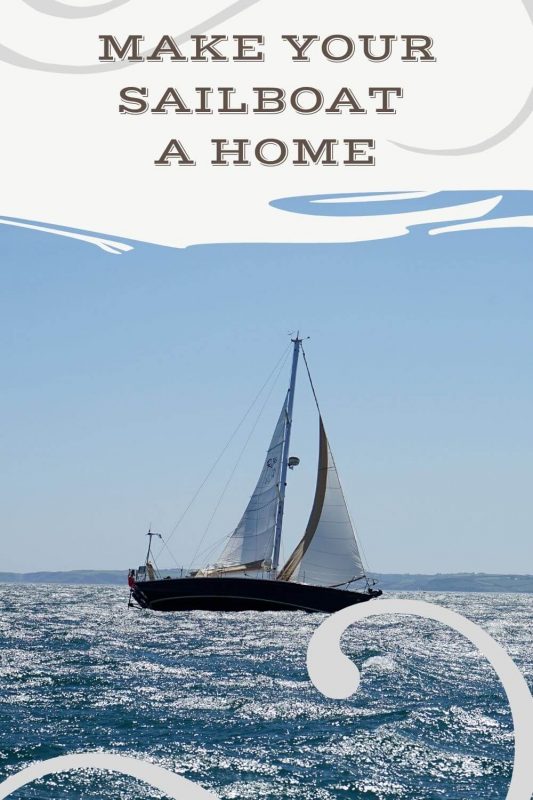
Making Your Sailboat Feel Like Home: Must Have Home Comforts

Storm Sails: The Ultimate Guide
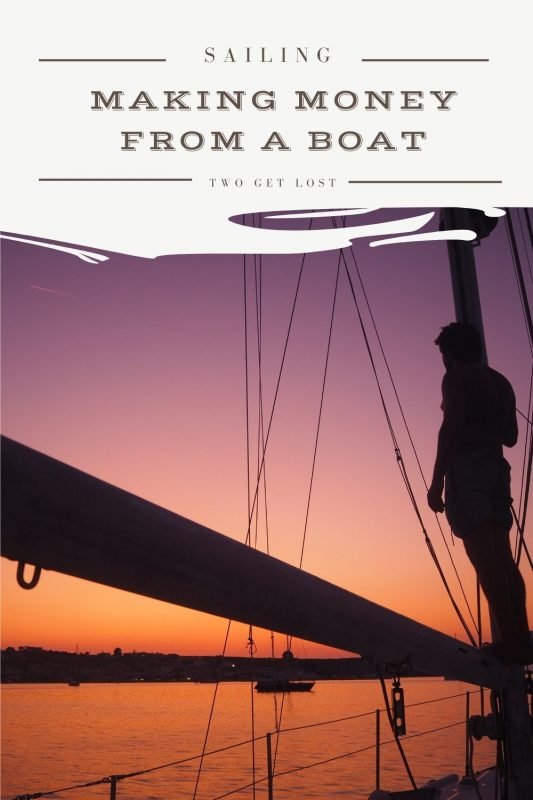
How to Make Money While Living on a Sailboat

Sailing Close To The Wind: How And Why You Should

How To Start A Life At Sea

Can You Live On A Boat On Land And What’s It Really Like?
- Search Search Hi! We’re Emily, Adam and Tiny Cat, liveaboard sailors travelling the world on our 38ft sailboat and writing about it as we go. We hope we can inspire you to live the life you’ve always dreamed, whether that’s exploring the world or living a more simple way of life in a tiny home. Find out more. Patreon
- Privacy Policy
- Articles and Guides
Catamaran vs Monohull: The Great Sailboat Debate
16th jun 2023 by john burnham.

Do you love the natural sounds of water sliding past the boat’s hull and a breeze blowing across your rigging and sails while gliding ahead powered only by the force of the wind? If yes, you are well-suited to spending plenty of time on a sailboat, like so many generations of boat people before you.
But do you take your lead from the Egyptians who rigged sails on their boats built of reeds along the Nile River or follow the path of the Polynesians, who used an outrigger for extra stability and sailed from one Pacific island to the next in the earliest catamarans?
The question of which is better for sailing, one hull or two, has been a matter of debate over thousands of years. Today, let’s explore these two basic types of sailboat, and while we may not settle the argument once and for all, hopefully in the process you will begin to discover which option is better for you.
What Are the Differences Between Catamaran and Monohull Boats?
The monohull and the catamaran (often referred to as “cat”) are the two most common categories of sailboats, and of the two, the monohull far outnumbers the catamaran in popularity due to its simplicity and sturdiness. Advocates of the catamaran, however, are typically even more convinced than monohull sailors that their boats are best due to performance potential and overall spaciousness.
What are catamaran-style boats?
Catamarans are easily identified by their two-hull design. Two hulls sit side by side with an interconnecting deck or structural beams across the bap in the middle. Catamarans have been around since Pacific Islanders and other Austronesian people sailed them centuries ago, and they continue to gain popularity in a wide range of designs both as high-performance racing boats and ocean-cruising designs.
Although not part of this debate, a third sailboat type comparable to a catamaran is a trimaran. Trimaran sailboats are constructed similarly to catamarans but have three parallel hulls rather than two. Collectively, catamarans and trimarans are referred to as multihulls, and sailors of both types often refer lightheartedly to monohulls as “monomarans.”
What are monohull-style boats?
Monohull sailboats are the most common boat type because they feature a single hull, typically with a single mast and two sails. Rather than maintaining stability with a second hull creating a wider beam, monohull boats usually carry lead or other heavy ballast in their keel, or are stabilized by human weight as their crews lean out to counter the force of the wind. Monohulls can also be excellent racers and cruisers, depending on their size, volume, sail area, and displacement or weight.
Where Catamarans and Monohulls Excel
Each type of boat has its advantages, depending on what the owner wants in a boat. Here are the main advantages of each type.
Catamaran advantages
• More space . Catamarans have greater beam for a given length, which provides more space for the crew on a daysailer and larger living quarters on cruising designs, which are often laid out with berths in each hull and living quarters across the bridgedeck between hulls.
• Faster hull . If they are light enough, the sleeker shape and reduced wetted surface of two narrow, shallow hulls can produce quicker straight-line sailing speed than a single, deeper and wider hull.
• Comfort and stability . Two hulls provide better initial stability and generally heel less than monohulls, especially in light- or medium-strength winds and waves.
Monohull advantages
• Upwind sailing . When sailing against the wind, monohulls often sail at a closer angle to the wind and arrive more quickly at their destination.
• Easier motion . Heavier monohulls often have a slower, gentler motion in waves than a lighter catamaran.
• Load carrying capability . A monohull’s performance is reduced less than a catamaran’s when the boat is loaded heavily with cargo or crew.
• Righting characteristics . Larger monohulls have weighted keels that provide increased resistance to a capsize when the boat is heeled far over by wind or a wave and if capsized will return the boat to an upright position.

Catamaran vs. Monohull Sailing Speed
There are several reasons why a catamaran is often faster than a monohull boat. These include the fact that most catamaran hulls have less water resistance than monohulls, they are often lighter, and they can be more easily driven by a relatively small sailplan. At similar lengths, a catamaran can be dramatically faster than a monohull under similar sea conditions. However, weight is the enemy of a catamaran’s speed; a heavy or heavily loaded catamaran may be much slower than a lightweight monohull.
Catamaran vs. monohull power
A monohull under auxiliary power may be faster than a catamaran in certain conditions, like powering against a strong wind. In other wind and wave conditions, the catamaran is often faster. Also, with an engines on each hull, the cat is often much more maneuverable in close quarters or at the marina. While it may seem counter-intuitive, turning and controlling the boat is often less challenging than when sailing a monohull boat with the typical single engine. Monohull boats require more finesse when in tight quarters like berthing in a marina.
Catamaran vs. Monohull Efficiency
A sleek monohull may sail against the wind super efficiently, pointing close to the wind and making an excellent speed. However, the power-to-weight ratio of the catamaran allows it to make good use of whatever wind it has. Some fast, light catamarans can travel at speeds equal to or faster than the wind, something very few monohulls can achieve. When the wave action increases and you start sailing into the wind, the catamaran may lose its advantage, and in strong winds, the greater windage of the wide catamaran may have a pronounced slow-down effect compared to the sleeker monohull.
Catamaran vs. Monohull Stability
Despite not having a weighted keel, a catamaran design is able to avoid heeling over in strong winds or bad weather due to its greater width or beam. As a result, the multihull also tends to be more stable at anchor and any time in calmer seas. However, if the winds are strong and the waves are large, a monohull, with its keel weight and ability to sail against the wind while controlling the sails, is sometimes the steadier of the two types. While a monohull with weighted keel can be knocked down by strong gusts of wind, it will only capsize in extremely large waves. Likewise, a cruising catamaran can only capsize in large ocean waves, unless it is a fast, lightweight catamaran, that can more easily tip over in gusty winds and waves.
Catamaran vs. Monohull Safety
Power catamarans and power monohulls are relatively comparable in terms of safety. But depending on the size of the mast and sails, the weight of the boat, and the wind and wave conditions experienced, many sailors believe that a monohull configuration is safer than a catamaran for a sailboat. That’s mainly because while a monohull will initially heel over further in a strong gust of wind, the weight of its keel provides increasing stability as described above and if completely capsized, the keel typically helps the boat self rescue.
It should be clarified that many sailing catamaran designs are conservatively configured and difficult to capsize except in extreme ocean wave conditions—and the same can be said for larger power catamarans.
In terms of ultimate safety in the event of a capsize, however, the catamaran is considered safer because even should it turn once upside down, even if damaged, the catamaran with its two hulls and minimal ballast typically remains buoyant and provides a safer configuration in which to await rescue. By contrast, if a monohull’s hatches and port windows suffer damage in a knockdown, the boat can more quickly take on water and, weighed down by its keel or other ballast, be more difficult to keep afloat in extreme conditions.
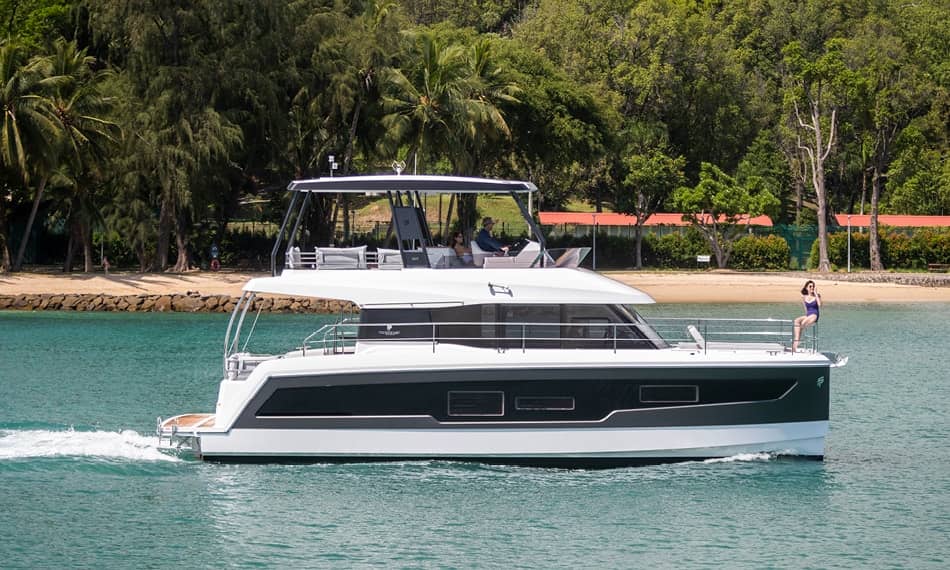
Photo credit: Fountaine Pajot
Monohull vs. Catamaran Maintenance
Depending on size, age, and type of hull construction, maintenance costs will vary, but when comparing two fiberglass sailboats of similar length, the catamaran typically costs more to maintain. That’s because there are two hulls to care for, two engines, connecting structures that align the two hulls, and an overall larger boat due to the catamaran’s greater beam. Hauling and launching a catamaran can be more expensive at many boatyards, as well.
However, smaller catamarans of about 20 feet in length or less are often more comparable and sometimes cheaper to maintain than a similar length monohull. That’s because cats are often lighter and suitable for keeping on a trailer rather than in a slip or on a mooring.
Catamaran vs. Monohull Cost
Compared to similar length monohulls, a catamaran will likely cost more than a monohull boat. That’s mainly because when you purchase a 40-foot catamaran, you are buying two hulls and two engines, but you are also buying a bigger boat that typically has much more volume. In the case of a 40-footer, you end up with a boat that has a large saloon and three or four private cabins, whereas in the monohull, the saloon is smaller and you’ll have three smaller sleeping cabins. Annual maintenance will also be greater, as described above.
Among smaller catamarans and monohulls, pricing will vary, and a lightweight beach cat may be less expensive than a heavier monohull keelboat of similar length.
Catamaran vs. Monohull, Pros and Cons
Depending on a variety of factors, there are plenty of catamaran and monohull pros and cons. These are some to keep in mind when comparing the two boat types.
Catamaran pros
• Comfort . On a cruising designed catamaran, two hulls with a wide beam create a stable and comfortable living environment with open spaces and plenty of standing room.
• Speed . Smaller, lighter catamarans are speed champions, especially in a moderate wind and modest waves. Cruising cats are often fast when sailing at reaching angles.
• Maneuverability . When equipped with two engines, a catamaran is highly maneuverable under power.
Monohull pros
• Upwind sailing . Although catamarans are often faster when sailing in a straight line, monohulls typically perform better against the wind.
• Self-righting . Except for unballasted monohulls that rely on crew weight for stability, the ballasted keel of a monohull prevents capsizing in most circumstances and the keel makes the boat self-righting.
• Maneuvering under sail . Monohulls turn more easily due to their shape, maneuvering in close quarters or tacking when sailing against the wind.
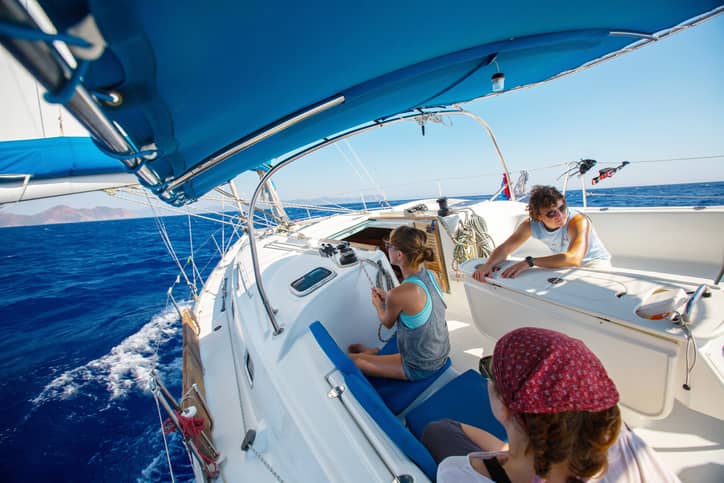
Catamaran cons
• Lack of feel when steering . Except in lighter, more performance-oriented catamarans, the broad platform with two rudders and two hulls sometimes isolates the sailor and provides little feedback through the helm when under sail.
• Sailing against the wind . Upwind sailing is generally not a catamaran’s best point of sail, but its straight-line speed can be such that it may arrive quickly at its destination, even though you will have traveled much farther than in a monohull.
• Pricing . Catamarans are typically more expensive than monohull boats due to their two hulls and other required build components and complexity.
• Not self-righting . Thanks to its wide beam and two-hull design, a catamaran is more difficult to flip, but it is not designed to right itself except for small beach cats where the crew can use their weight to re-right the boat.
Monohull cons
• Weight . Most monohulls have thousands of pounds of weight in the keel for ballast that is vital to its stability but can degrade performance.
• Wave motions . Monohull boats are much more susceptible to rolling wave motions.
• Cabin . With the monohull cruising design, you'll typically find a darker interior with smaller port windows and fewer space options.
• Heeling effect . Monohulls will heel over in a moderate wind, which is normal but often uncomfortable for newer sailors.
Written By: John Burnham
John Burnham is a marine editor and writer with decades of journalism experience as Chief Editor of boats.com, Sailing World, Cruising World, and other boating websites. As a competitive sailor, he has led teams to world and national titles in the International One-Design, Shields, and other classes. Based in Newport, Rhode Island, John is a PCC leadership coach, a member of the America’s Cup Hall of Fame Selection Committee, and a past board member of Sail America and US Sailing. For more, see johnsburnham.com .

More from: John Burnham
Related Articles and Guides
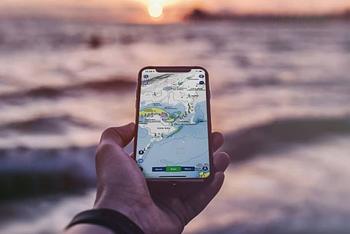
30th Mar 2024
Best Boat Navigation Apps for Smartphones
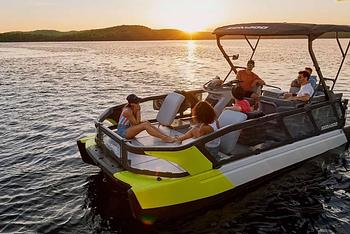
29th Mar 2024
Best Jet Boat Brands Among All Types of Small Craft

26th Mar 2024
Best Sport Fishing Boats, Convertible and Express to Center Console
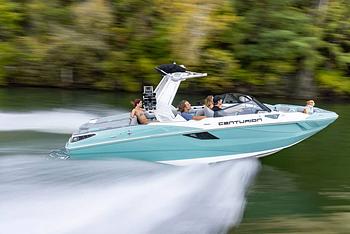
20th Mar 2024
Best Wakesurf Boat Brands, V-Drive, Jet-Drive, Forward-Drive & More
- Explore Rightboat
- Boats for Sale
- Boating Articles
- Buyers Guide
- About RightBoat
- Sell Your Boat
- Boat Selling Advice
Enter your email to keep up to date with the latest news
Join for free
Sign up now for free and discover how easy it is to keep up to date with THE latest boats for sale. Find your right boat, and tailor your voyage to finding your next boat.
Benefits of becoming a member:
- Set up tailored alerts
- Personalise your experience
- Download full specifications and broker details
- Keep tabs on your favourite boats
Are you a broker? Join as a Broker
Rightboat - join for free.
Do you have an account already? Login
Save this search
Save your search and receive new boats in your email..
You can unsubscribe from your alerts whenever you like. By pressing the button you accept the Legal Terms and conditions
- Course Checklist
- Important Information
- How to Get to Us
- Our Instructors
Monohull vs Catamaran: A Deep Dive into Design and Performance
The genesis of two designs.
In the world of sailing, the debate between monohulls and catamarans is a tale as old as time. The history of these two iconic designs stretches back to antiquity, reflecting the evolution of human innovation and our insatiable desire for exploration.
The monohull's genesis lies in the early days of human seafaring. Traditional cultures from the Mediterranean to the South Pacific have all used some form of monohull craft for fishing, trade, and exploration. The monohull's sleek, single-hulled design, characterized by a deep keel and distinct bow and stern, offers an efficient shape for cutting through waves. Over centuries, the monohull design has been refined and perfected, culminating in the magnificent yachts we see gracing our waters today.

On the other hand, the catamaran, a vessel with two parallel hulls, boasts a legacy equally steeped in seafaring history. Its origins can be traced back to the outrigger canoes used by ancient Austronesian cultures.
The word 'catamaran' itself is derived from the Tamil word 'kattumaram', which loosely translates to 'logs tied together'.
These innovative sailors discovered that by adding a second hull, they could greatly improve the stability and speed of their vessels, a design principle that holds true to this day.
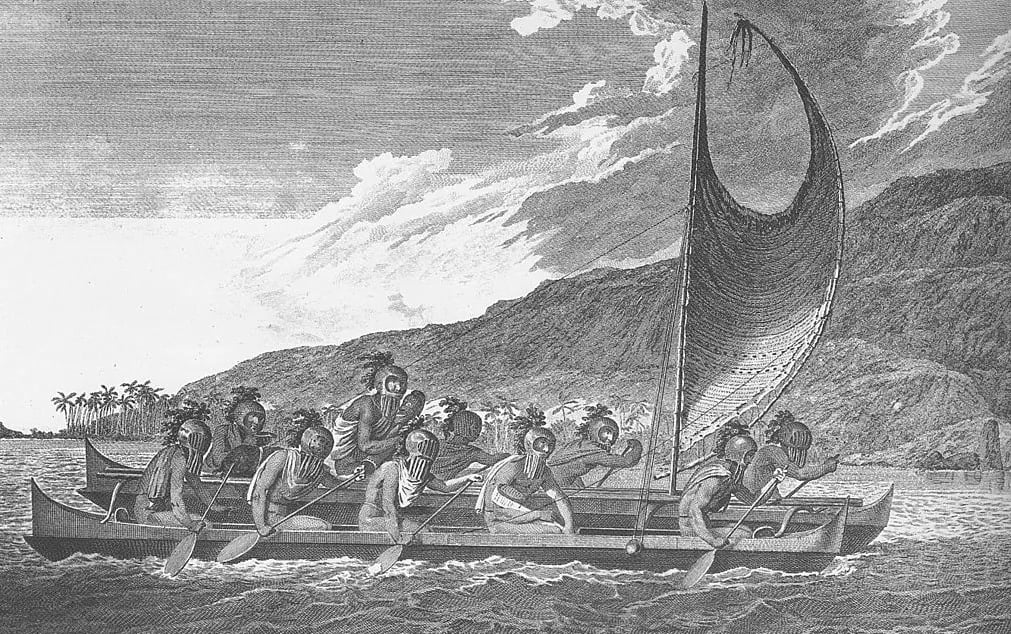
Exploring the Monohull Design
Stepping into the present, let's delve deeper into the modern monohull design. Its traditional single hull offers a quintessential sailing experience that's hard to match. Monohulls are typically seen as the embodiment of the romantic sailing ideal, thanks to their elegance and the graceful way they heel under sail.
One of the major benefits of monohulls lies in their seaworthiness. Their deep keels provide excellent stability, allowing them to handle heavy seas and high winds effectively. In addition, the keel acts as a counterbalance, enabling the boat to right itself after being heeled over by a gust of wind. This 'self-righting' characteristic is a significant safety feature exclusive to monohulls, adding a level of reassurance when navigating challenging sea conditions.
Monohulls are also known for their responsive handling and satisfying sailing performance. The mono-hulled design cuts cleanly through waves, resulting in a smooth and predictable ride. If you're the type of sailor who enjoys feeling the wind and waves' raw power, the visceral connection that a monohull provides is unparalleled.
However, as with everything in life, monohulls also have their downsides. For one, space can be at a premium. The deep keel and the rounded hull shape necessary for stability and performance take up much of the interior volume, leaving less room for living space compared to a similarly sized catamaran.
Another consideration is the heeling motion. While some sailors love the feeling of a boat leaning into the wind, others may find it uncomfortable or disorienting, especially during prolonged passages.
Despite these trade-offs, monohulls continue to hold their charm for many, offering a blend of tradition, performance, and adventure that has stood the test of time. In the next part of this deep dive, we'll shift our focus to the twin-hulled wonder of the sailing world: the catamaran.
The Catamaran Conundrum
As we switch gears to catamarans, it becomes apparent how contrasting they are to their monohull counterparts. Catamarans, with their dual hulls connected by a central platform or cabin, present an entirely different set of strengths and challenges.
Let's start with one of the most prominent features of catamarans: their stability. The wide beam of a catamaran provides a significant increase in stability over a monohull, reducing the boat's tendency to roll. This stability not only enhances the comfort of your crew but also allows for safer and easier movement on deck and below. If the notion of preparing a meal in a level galley while underway appeals to you, a catamaran might be the perfect fit.
Space is another major advantage of catamarans. With essentially two hulls worth of volume, catamarans typically offer much more living space than a similarly sized monohull. This makes them an attractive option for those planning extended cruises or living aboard. The additional space also allows for separate, private cabins in each hull, perfect for accommodating families or groups.
When it comes to performance, catamarans have a distinct edge in certain areas. Their dual-hulled design and lack of a ballasted keel result in less drag, allowing them to often outpace monohulls in moderate conditions. However, this speed advantage may be offset in heavy weather, where the ability to cut through waves (rather than ride over them) can make a monohull's ride smoother and faster.
But, just like monohulls, catamarans aren't without their drawbacks. While their stability and flat sailing characteristics are often seen as benefits, they can also create a false sense of security, leading some sailors to push their boats beyond safe limits. Additionally, while catamarans are significantly harder to capsize than monohulls, if they do flip, they generally won't self-right like a monohull would.
Furthermore, catamarans can be more challenging to handle in confined spaces due to their wider beam. Docking, in particular, can be trickier, especially in marinas designed with narrower monohulls in mind. Also, the increased beam and dual hulls often lead to higher mooring and maintenance costs.
Monohull vs Catamaran: Performance Parameters
Before we take this deep dive to its conclusion, it's important to touch on a few key performance parameters. These can greatly influence whether a monohull or catamaran would be a better fit for your sailing needs.
For starters, how a boat handles various wind conditions is critical. Monohulls, due to their keeled design, tend to excel upwind. Their ability to 'point' into the wind is usually superior to that of a catamaran. On the other hand, catamarans, with their lighter weight and reduced drag, often have the upper hand in downwind and lighter wind conditions.
Another factor to consider is load carrying capacity. While catamarans have more space for storing gear and provisions, they can be more sensitive to overloading. Additional weight can significantly impact a catamaran's performance, whereas monohulls tend to be more forgiving in this regard.
In the final part of this blog, we'll wrap up our deep dive by considering these and other factors to help determine which design might be the best fit for your sailing needs.
Choosing Your Vessel: What Suits Your Sailing Style?
Now that we’ve explored the design principles and performance traits of monohulls and catamarans, it’s time to consider what kind of vessel will best cater to your personal sailing needs and preferences.
If your sailing plans involve long passages in open waters, especially in rougher seas or challenging wind conditions, a monohull's sturdy and seaworthy design might be the most fitting choice. Their excellent upwind performance and smoother ride in heavy weather will provide you with both comfort and safety on lengthy oceanic voyages.

For those attracted to the exhilaration of speed, catamarans, with their swift downwind capabilities, can offer a thrilling sailing experience. They can be the ideal choice if your sailing adventures are primarily focused on coastal cruising, island-hopping, or participating in sailing races where their speed advantage can shine.
Lifestyle preferences play an essential role as well. If you value space and comfort, and perhaps are contemplating living aboard or planning extended family cruises, the spacious interior of a catamaran, with its level sailing and private cabins, may be the superior option.
However, if you're a sailing purist who enjoys the classic feel of a boat that heels under sail, the thrill of mastering the art of balancing a boat in various wind conditions, a monohull will likely provide the sailing experience you're seeking.
As for cost considerations, remember that while catamarans offer more living space and stability, they can also come with higher purchase, maintenance, and mooring costs.
Closing Thoughts: Your Ideal Adventure on the Water
If you're looking to buy or charter a sailboat , the choice between a monohull and a catamaran ultimately boils down to your sailing goals, personal preferences, and budget. There's no definitive answer to which is better because it's subjective to the individual sailor.
Whether you're lured by the traditional appeal and seaworthiness of a monohull or the comfort, stability, and speed of a catamaran, the most important thing is to choose a vessel that will provide you with many memorable and safe adventures on the water.
At Sailing Virgins , we love them both and appreciate their unique characteristics. Whatever you choose, the sea will always be an ever-changing playground that continually challenges and rewards those who embrace the sailing lifestyle.
If you're still unsure about which one is for you, why not join one of our sailing courses or adventures? It's the perfect way to gain hands-on experience and discover what type of sailing brings you the most joy. Feel free to press the button below to check out our courses.
Fair winds and following seas to all prospective boat buyers out there!

Related posts
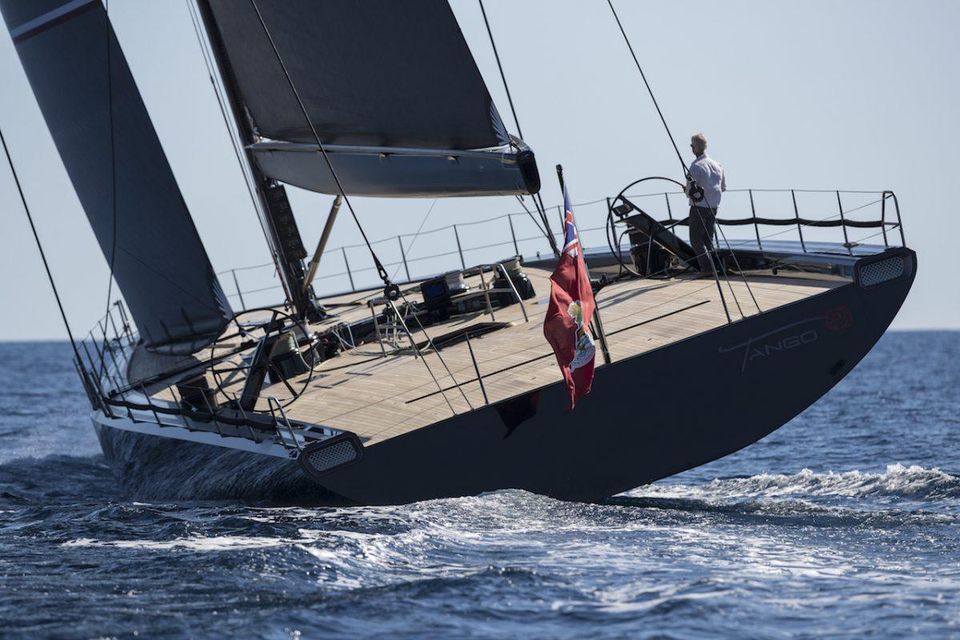
Catamarans vs. Monohulls
Which is better, a monohull or a catamaran.
This question gets asked a lot in sailing. Especially...
Recent Posts
- August 2016 (11)
- May 2023 (11)
- April 2023 (10)
- September 2016 (8)
- November 2016 (5)
- June 2016 (3)
- July 2017 (3)
- March 2018 (3)
- November 2018 (3)
- June 2019 (3)
- June 2023 (3)
- October 2016 (2)
- January 2017 (2)
- February 2017 (2)
- May 2017 (2)
- August 2017 (2)
- October 2017 (2)
- February 2018 (2)
- December 2018 (2)
- June 2022 (2)
- July 2022 (2)
- November 2015 (1)
- April 2016 (1)
- May 2016 (1)
- December 2016 (1)
- April 2017 (1)
- September 2017 (1)
- November 2017 (1)
- December 2017 (1)
- January 2018 (1)
- April 2018 (1)
- July 2018 (1)
- September 2018 (1)
- January 2019 (1)
- July 2019 (1)
- September 2019 (1)
- January 2020 (1)
- March 2020 (1)
- April 2020 (1)
- May 2020 (1)
- June 2020 (1)
- April 2021 (1)
- August 2022 (1)
- October 2022 (1)
- December 2022 (1)
- July 2023 (1)
- August 2023 (1)
- January 2024 (1)
- how to (21)
- sailing (14)
- Sailing Tips (12)
- corporate (9)
- sailing course (7)
- General (6)
- Insider (6)
- professional development (6)
- vacation (6)
- Mindfulness (5)
- leadership (5)
- Performance (4)
- group travel (4)
- opinion (4)
- opinions (4)
- qualifications (4)
- Interview (3)
- Trip Notes (3)
- Uncategorized (3)
- adventure (3)
- sailing virgins (3)
- Instructor Course (2)
- Self-Care (2)
- catamarans vs monohulls (2)
- charter boat (2)
- island adventure (2)
- networking (2)
- preparation (2)
- sailing guide (2)
- youtube (2)
- Athlete (1)
- Beginner (1)
- City Guides (1)
- Failure (1)
- First Time (1)
- Maderia (1)
- check out (1)
- fishing (1)
- french polynesia (1)
- gear tips (1)
- golf vs sailing (1)
- safety brief yacht (1)
- the yacht week (1)
- trip review (1)
The founders of Sailing Virgins started things as a result of having some incredible sailing seasons in the Mediterranean and Caribbean working for sailing company The Yacht Week. James then worked for and for a while managed Tortola Sailing School. In 2016 he branched off and started Sailing Virgins. We LOVE how sailing is changing. Top speeds in the America’s Cup were thirteen knots not so long ago. Now they’re 45 knots. If you’re excited by that, we’re with you. Giddy up!
- Village Cay Wickhams Cay 1 Road Town VG VG1110, Road Town, British Virgin Islands
- +1 (284) 442-2288
- [email protected]
© LOVE SAILING VIRGINS 2016-2019
- Terms & Conditions
- Privacy Policy
- Fraud Policy Statement
- Affiliate Program

Catamaran VS Monohull Sailing – Which Is Best For You?

When it comes to choosing the right boat for your sailing adventures, the debate between catamarans and monohulls is a hot topic. Many novice and experienced sailors face the challenge of deciding which type of boat best suits their needs, preferences, and sailing goals.
Each of these vessels has its unique characteristics, and your choice will ultimately depend on factors such as the intended use, the areas you plan to sail, budget constraints, and your personal preferences.
In this article, you’ll find all you need to know about catamaran vs monohull sailing. So, let’s dive into it right now and see the key differences between these two popular types of watercraft.
Post updated: 25.10.23
Table of Contents
Key Takeaways
- Understand the differences in design and performance between catamarans and monohulls.
- Consider factors like comfort, safety, and cost when choosing a boat.
- Gain insights into the pros and cons of each type of vessel to make an informed decision.
Design and Structure
Hull comparison.
When choosing between a catamaran and a monohull, one of the main differences lies in their hull structures. A catamaran consists of two parallel hulls connected by a beam, offering more stability and a shallower draft.
A monohull has a single hull and relies on a deep keel for stability. Monohulls often give the feeling of sailing closer to the water and provide the traditional sailing experience many enthusiasts enjoy.
Deck and Cabin
In terms of living quarters, catamarans offer larger, more open deck spaces and cabins than monohulls. This allows for a more comfortable living experience, with roomy kitchens and dining areas.
On a monohull , the living space can feel more confined, but some sailors appreciate the cozy atmosphere and the challenge of maximizing every inch of space.
Beam and Ballast
The beam refers to the width of the boat, and in the case of a catamaran , it is typically wider than a comparable monohull, as it stretches across both hulls. The increased beam improves stability, making catamarans less likely to rock or roll in waves when navigating in good conditions.
Monohulls, on the other hand, have a narrower beam and use ballast (typically in the form of a heavy keel) to assist in maintaining balance. This allows monohulls to lean or “heel” more while underway, providing a unique sailing experience for those on board.
Helm and Rudders
Both catamarans and monohulls have helms and rudders to control the boat’s direction and maneuverability. The key difference lies in the positioning and number of these components.
On a catamaran , there are typically two rudders, one behind each hull, providing more responsive steering and faster turning.
Monohulls have a single rudder, which might make steering more challenging in strong winds or high seas.
Performance
Speed and efficiency.
When comparing catamarans and monohulls, one of the first things that comes to mind is their speed and efficiency.
Catamarans are generally faster than monohulls of the same length and displacement.
This is primarily due to their lighter weight and slim hulls, which offer less water resistance and drag.
In fact, a catamaran can often sail at half the speed of wind, which is about 30% faster than a monohull. However, this also depends on factors like sail configuration, wind conditions, and sea state.
Handling and Maneuverability
Handling characteristics differ significantly between catamarans and monohulls. Generally, monohulls are more responsive to trim adjustments and wind pressure, providing a more engaging sailing experience for the sailor.
On the other hand, catamarans are less maneuverable under sail since they lack the deep keel of a monohull, which is essential to track and coast.
Nonetheless, catamarans excel in maneuvering when under power, thanks to their twin-engine configuration. They can pivot the boat into position more easily, making docking a breeze.
Monohulls rely on prop walk and reverse to position themselves, which can be challenging for some sailors.
Upwind Sailing
Sailing upwind is an essential aspect of any sailing adventure. Here, monohulls have the edge, as they can sail closer to the wind. This means that when you’re racing or trying to reach an upwind destination, a monohull might get you there faster.
Catamarans, on the other hand, struggle to tack upwind as efficiently due to their wider hull separation and lower resistance.
Water Resistance and Drag
Water resistance and drag play a crucial role in a sailboat’s performance. Catamarans have slender hulls with minimal wetted surface area, which reduces drag and allows them to cut through the water more efficiently.
This design contributes to their speed advantage over monohulls . On the contrary, monohulls have a larger wetted surface and a deeper draft, which increases water resistance and slows them down in comparison.
Both catamarans and monohulls have their unique strengths and weaknesses in terms of performance. While catamarans are generally faster and offer better maneuverability under power, monohulls excel in upwind sailing and provide a more engaging sailing experience.
Comfort and Space
Spaciousness and comfort.
Regarding comfort and space, catamarans have a clear advantage over monohulls. Thanks to their wide beam, catamarans offer more spacious accommodations, especially in the main saloon and cockpit areas.
The twin-hulled design provides greater stability, resulting in a smoother sailing experience with less heeling and rocking.
This makes catamarans ideal for those who prioritize comfort and want plenty of room to move around during their sailing adventures.
Kitchen and Dining Experience
A key difference in the kitchen and dining experience between catamarans and monohulls lies in the amount of space and layout.
Catamarans typically feature roomier galleys with ample counter space for meal preparation, making it easier for everyone to lend a hand in the kitchen.
The dining area in catamarans is often designed as an extension of the cockpit, allowing for seamless indoor-outdoor socializing and easy access to both the galley and the deck.
In contrast, monohull sailboats have smaller galleys, often in a U-shape or along one side of the hull. The dining area might be more confined, usually within the main salon. While it may be cozy, it lacks the open and airy feel of a catamaran’s dining space.
Privacy and Living Quarters
Another aspect to consider is the privacy and living quarters in both types of sailboats.
Catamarans usually have separate hulls for the living accommodations, which can provide greater privacy and personal space for guests or crew members as the cabins tend to be physically separated from the common areas.
Additionally, because the cabins are situated in the hulls, they are less affected by noise or disturbance from the main salon and cockpit.
Monohull sailboats, on the other hand, usually have more compact living quarters located within the same hull. Privacy may be slightly compromised due to the closeness of the cabins to the common areas.
That said, monohulls can still provide adequate living space and privacy, depending on the layout and size of the sailboat.
Safety and Stability
When comparing catamarans and monohulls, safety and stability are important factors to consider. In this section, I’ll explain the differences between the two boat types regarding capsize and buoyancy, seasickness, motion, dealing with waves and bad weather, and docking and anchoring.
Capsize and Buoyancy
Catamarans are known for their stability due to their two-hull design, which increases their resistance to capsizing.
Conversely, Monohulls can roll over more easily but can right themselves due to their heavy, lead-loaded keels. However, catamarans have natural buoyancy and can remain afloat even if they are holed, while a monohull may sink if it takes on too much water.
Seasickness and Motion
Seasickness can be a major concern for boaters, and the motion of a catamaran is generally more stable and comfortable than that of a monohull.
Catamarans are less susceptible to roll, which can reduce the chances of seasickness for those onboard.
Monohulls , however, tend to pitch more in rough seas, which can lead to a more uncomfortable ride for passengers.
Dealing with Waves and Bad Weather
While catamarans are known for their speed advantage over monohulls, heavier cruising catamarans may not be as fast if they have smaller rig sizes for ease of handling.
In bad weather, a catamaran’s speed can help outrun storms, while monohulls rely more on their stability in rough waters.
Waves in an anchorage that induce violent roll in a monohull may, however, only cause a catamaran to bounce or bob.
Docking and Anchor
When it comes to docking and anchoring, there are differences between catamarans and monohulls.
Catamarans don’t coast well primarily because they don’t have a deep keel to track. They require a different approach to docking, utilizing engines to pivot the boat into position instead of relying on coasting and prop walk.
Monohulls typically need more depth when anchoring due to their keels, while catamarans benefit from their shallow drafts, allowing them to access shallower areas and anchor closer to shore.
Cost and Maintenance
When considering catamarans and monohulls, it’s important to take into account the cost and maintenance of each type of vessel. So, let’s explore the differences in maintenance and equipment, fuel consumption, and demand and resale value between the two.
Maintenance and Equipment
Generally, catamarans are more expensive to buy and maintain than monohulls. This is mostly due to their double-hull design, which requires extra maintenance and equipment costs.
On average, catamarans are 19-66% more expensive when new and have about 60% higher annual fees.
Although monohulls ‘ maintenance and repair costs are often lower, both boat types require regular upkeep to stay in good shape.
Some key maintenance differences between catamarans and monohulls include:
- Hull and rigging maintenance: Catamarans have two hulls, which can lead to double the maintenance costs for bottom painting and cleaning. However, their typically lighter and simpler rigging system can result in lower maintenance costs than monohulls.
- Engine maintenance: Catamarans usually have two engines, one in each hull, increasing overall maintenance costs. Monohulls generally have one engine, which can result in lower maintenance costs over time.
Fuel Consumption
When it comes to fuel consumption, catamarans tend to be more fuel-efficient than monohulls, especially at slower speeds. This is due to their hydrodynamic design, lightweight materials, and relatively less water resistance.
Although monohulls may consume more fuel, they often have a smaller fuel tank, which can result in lower overall fuel costs.
Demand and Resale Value
When purchasing a vessel, it’s important to consider the demand and resale value of both catamarans and monohulls.
Catamarans hold their value better due to their growing popularity and scarcity in the used boat market. This means that if you decide to sell your catamaran, you are likely to get a higher percentage of your investment back.
Monohulls, on the other hand, are more common on the used boat market, resulting in lower resale values. However, they typically have a lower initial purchase price, which may be more attractive for those on a budget.
Pros and Cons of Catamarans and Monohulls
Now, let’s explore the advantages and disadvantages of both catamarans and monohulls to help you decide when choosing the right boat for your needs. Let’s dive right into it!
Advantages of Catamarans
One of the main advantages of catamarans is their comfort . They’re more stable and less prone to heeling, making it less likely for passengers to get seasick.
Catamarans are also more spacious due to their dual-hull design, providing ample living space above the waterline with bright and airy saloons. This makes them perfect for sailing with family or friends.
When it comes to speed , catamarans generally perform better than monohulls. They usually sail faster and are more maneuverable in tight spaces due to their shallower draft, allowing for safer anchorages closer to shore.
Most catamarans in the 40-ft to 50-ft range draw between 3 ft to 4.5 ft, so they can access places that monohulls can’t even consider.
Disadvantages of Catamarans
Unfortunately, catamarans do have some downsides. One of the main disadvantages is their larger windage .
The increased surface area can make them more difficult to handle in strong winds.
Additionally, their maintenance can often be more specialized and expensive due to the unique design features.
Advantages of Monohulls
Monohull boats have their own set of advantages. They provide a more classic aesthetic that many sailors find appealing.
When it comes to sailing performance, monohull boats heel naturally, which can give more direct feedback to the sailor and make for a more exhilarating experience.
In terms of speed, modern monohulls can sometimes exceed catamarans, particularly downwind and in choppy seas. Some can reach speeds of 10 knots or more.
Disadvantages of Monohulls
On the flip side, monohull boats often have less living space, and most spaces are below the waterline, making them feel more cramped and darker compared to catamarans. The heeling experience is a double-edged sword, as some passengers might enjoy it while others may feel more prone to seasickness.
Frequently Asked Questions
Q: which is safer in rough seas: a catamaran or a monohull.
When it comes to rough seas, both catamarans and monohulls have their safety advantages. Catamarans are known for their stability on the sea, and their speed can make it possible to outrun bad weather.
However, monohulls are considered to be stronger and may provide more space for emergency equipment and supplies. Safety ultimately depends on your skills as a sailor, the boat’s design, and the specific conditions you encounter.
Q: Can both catamarans and monohulls be used for offshore fishing?
Yes, both catamarans and monohulls can be used for offshore fishing. Catamarans are famous for their stability and ample deck space, which can provide a more comfortable fishing experience.
Monohulls, on the other hand, often have a deeper draft, allowing them to access deeper waters and a wider range of fishing spots. Ultimately, the choice comes down to your personal preferences and the type of fishing you plan to do.
Q: How do catamaran and monohull liveaboards differ?
There are notable differences between catamaran and monohull liveaboards. Catamarans typically provide more living and storage space, as well as more privacy due to their dual-hull design.
They’re also known to have better stability, which can make for a more comfortable living experience onboard.
Monohulls , however, can be more affordable and easier to maintain, and offer better sailing performance in certain conditions.
Q: Which type of boat is more suitable for Yacht Week: a catamaran or a monohull?
Both catamarans and monohulls can make for a fantastic Yacht Week experience, and the choice ultimately depends on your preferences and the specific event you’re attending.
Catamarans are ideal for those who prioritize stability, speed, and a more spacious layout for socializing.
Monohulls may be better suited for those who enjoy a more traditional sailing experience or are looking for a more budget-friendly option. Always consider the preferences of your crew and the requirements of the event when making your decision.
Final Words!
In summary, both designs offer their own unique advantages and drawbacks.
However, you should consider factors like your sailing goals, preferences in boat handling, and the type of waters you’ll be frequenting when deciding between a catamaran or monohull.
Both options have their merits, and your decision will ultimately be shaped by what best suits your unique needs and desires. Happy sailing!
Want More Tips?
Subscribe to Cruising Sea newsletter to receive every two-week the latest post straight to your inbox
Which yacht do you prefer, a catamaran or a monohull? Feel free to share your opinion in the comments below.

Daniella has been passionate about travel, the sea, and nature for many years. As a child, she frequently traveled throughout the Mediterranean and continued with her journeys throughout her adult life.
Her experiences have created the desire within her to share her love for traveling with other passionate and adventurers who want to discover beautiful horizons and new cultures.
10 thoughts on “Catamaran VS Monohull Sailing – Which Is Best For You?”
This is a very interesting article, but I think it’s very clear which side you come down on! I would tend to agree and you have laid the key points out nicely to create a strong argument for the cat. I have been on both, but I’m definitely not a sailor, but the thing I remembered the most was the smoother ride that you get with the cat. So I agree with you!
Yes, you get a smoother ride with a Cat than with a Mono due to the two hulls and not to forget that the Cat is lighter than a Mono:)
Thank you for the comment
I wish you a great day!
Hello Daniella, I am mostly a ballast when sailing but thank you for this nice article. I’ve been curious what are the differences of catamarans vs monohulls and thanks to You now i have a little better understanding. And since i was sailing on monohull now it’s time to check out catas 😉 Maybe You could you provide some more information about renting prices of catas vs mono ? I couldn’t find it here and I think it could also play a big factor when chartering a yacht. Cheers!
You are right, I didn’t mention this important detail. Sorry about it! Here is the answer. A Catamarans is generally more expensive than a monohull of the same size and the reason is because the cat is a larger boat. But you’ll get the payback in the comfort and space.
I hope it helped!
Thank you for the comment and wish you a nice day
For myself I have always owned a mono haul sailboat for the fun of sailing around. To actually do a trip on one with others, I would choose the more spacious catamaran for down south in the warmer waters.
Not knowing much about the catamaran, it was nice to read a side by side description to have a better understanding between the two.
I am glad you found this article helpful and I hope it will help you to make the right choice. If you have never tried a catamaran, then I highly suggest you to try it, I am sure you will love it!
Thank you for the comment and wish you to sail soon!
Have an awesome day
I’ll go for Monohull in this case. I’ll rather sail alone or take a person with me on board. Not keen on having a group.
As I mention before, design is one thing I emphasise on but there are lots of people on board, I think I’ll stick by having more space than more passengers.
Thanks for sharing by the way, Daniella! They’re very analytical and informative, just like the previous debate I red. Good stuff!
As long as you feel good with your choice, then no matter what you’ll choose, it will be the good decision!
I personally love catamarans:) I feel much more comfortable and safe on these boats and the seasickness is reduced to 80%, so I won’t give up on Cats!
A Catamaran sounds awesome to me! I love that there is more living space and that they can be faster in the right winds. I’ve always thought they were so cool whenever I’ve seen one. So much space to relax and enjoy the ocean. I personally do more dinghy sailing and like for sailing to be more of a workout – hiking upwind and such. What big boats sail most like a dinghy?
Yes, I totally agree with you, Catamarans are great boats for cruising. As you said, cats have everything in order to sail comfortably and in luxury as well. As far as I know, a dinghy will always be a boat and you can try to workout as you do it on a dinghy on a bigger boat like a catamaran or a monohull. If you want to navigate the boat by yourself, then you’ll need to check if you are required to have a license for bigger vessels. You might need to do a sailing course.
However, I hope it helped and if you need more information, please don’t hesitate to contact me at any time, I’ll be glad to assist:)
Leave a Comment Cancel reply
By using this form you agree with the storage and handling of your data by this website. *

COMMENTS
One of the advantages of catamarans over monohulls is their wider beam, which provides more deck space. This means more room to move around and increased stability, which is important in rough seas. Additionally, catamarans usually have two hulls, which means more cabin space and privacy for the crew and passengers.
In a monohull, however, the engines are centered along the transom. As a result, the cat can spin and turn on a dime with little effort, while the monohull has much less leverage when the engines are opposed. Monohull Pro: Monohulls are better weight-bearing platforms. Overload a powercat, and most of its advantages disappear as the twin hulls ...
In a similar manner, we can observe that catamarans have better roll stability when compared to monohulls. This gives them an upper hand in terms of comfort and executing different operations onboard the vessel with ease, also reducing the risk of people falling on board the vessel. Catamarans are mostly used as ferries or passenger vessels as ...
This has been objectively measured (with accelerometers) in a Glacier Bay 26 powercat versus a Regulator 26 monohull—both boats known for providing an excellent ride—to the tune of a .287-second deceleration versus a 0.081 second deceleration, and a three-G force impact versus a four-G force impact when hitting an identical wave head-on.
For the purpose of answering the question of how power cats perform in rough seas, we are assuming waves of 6-feet or less. ... have very limited space on where they can tie up a boat with a 25' beam as it takes up significantly more space than a monohull. Generally power catamarans are put at the end of the T-dock, which means there are less ...
The stability of power catamarans is unparalleled, especially when compared to monohulls. The wide beam and twin hulls provide a stable platform, reducing the rocking and rolling common in monohulls. This stability is not only comforting in rough seas but also crucial when docking or anchoring. Comfort and Space:
Catamarans don't coast well primarily because they don't have a deep keel to track. Relying on coasting to a dock at a shallow angle and then going into reverse and using prop walk to cozy up the stern won't work. It is better to come in at a sharper angle and then pivot the boat into position with the engines.
A smoother ride through rough seas than a monohull. Most planing powercats compress air between the two hulls, which cushions the impact when meeting waves at high speed. ... This Florida builder is one of the few in today's marketplace that builds a wide range of both monohull and power catamaran boats. All are fishing-oriented, and all ...
World Cat Powered Catamarans vs Monohull. Because you get a smoother ride. The wider footprint of a World Cat helps negate the effect of a rolling. Take a Se...
Catamarans and monohulls are boats that are pretty different from each other. Although the term catamaran applies to any vessel with multiple hulls, most catamarans are from two hulls connected by decks and outriggers to prevent capsizing in rough seas, while monohulls only have one hull. Catamarans are typically faster and more efficient than ...
Unlike monohulls that get into the groove and slice through waves when sailing upwind, cats can slap the water if the bridge deck clearance is low, or when the seas meet the underside of the bridge deck. People who usually sail monohulls may be accustomed to being alerted to the wind rising too much by the increasing heel of the boat.
Let's look at the strengths and weaknesses of catamaran and monohull boats. We picked two boats of similar length: the Sea Ray Fly 400 (43 feet 6 inches) and the Leopard 43 Power Cat (42 feet 8 inches). The Sea Ray displaces more (30,900 pounds versus 25,794 pounds), but the major difference is beam: The Leopard, carrying 22 feet 1 inch of ...
Navigating choppy waters: Monohull vs. catamaran. In rough seas, the design of a catamaran shines through. Its twin hulls provide excellent stability, reducing the rocking motion common on monohulls. If comfort during challenging weather is a priority, catamarans have a clear advantage. ... The feeling of harnessing the wind's power to glide ...
Rough seas are defined as waves that rise to heights between 2 to 6 feet (0.6 -1.8 meters). The hulls turn a catamaran into a floating platform that's pretty sturdy. In addition, their wide stance and solid construction make the vessel extremely stable, allowing it to withstand the water's constant pounding motion.
Catamarans Are Faster Than Monohull Boats. A catamaran is faster than the average monohull boat. This is because they face less water resistance, and their narrow hulls don't have to deal with their own bow waves as a monohull does. Of course, catamarans aren't always faster. Old cruising catamarans may not go faster than 8 knots, and ...
Speed. In the catamaran vs monohull speed debate, it might be more of a draw. Catamarans are typically 25-30% faster than a comparable monohull, but some argue that it comes at a price. When catamarans are sailing full speed you might experience a lot of slapping from the waves. Monohulls are designed to cut through the water.
ADVANTAGES OF A CATAMARAN. 1. Speed Equals Safety. The speed of a catamaran makes it possible to outrun bad weather. While catamarans do not point as high into the wind as a monohull (or if it does, it makes more leeway or slides sideways), it is about 20% faster than a monohull.
Upwind sailing performance: While catamarans have the edge at straight-line speed, monohulls sail closer to the wind. When you're racing or you have to sail upwind to get to the next island, this can get you there faster. Sailing feel and responsiveness: The "feel" of sailing a monohull is much better.
Part 2 right here: https://youtu.be/05E-Qv6BVfgA debate as old as time itself! Which is better, a catamaran or a monohull? I'll give away the answer here: l...
When it comes to determining which is better in rough seas, whether a catamaran vs. a monohull, it depends on various factors and personal preferences. Both types of vessels have their own strengths and considerations in rough conditions and it took us a lot of research to work out that really there isn't a 'better vessel', just different ...
Catamaran vs. monohull power. A monohull under auxiliary power may be faster than a catamaran in certain conditions, like powering against a strong wind. In other wind and wave conditions, the catamaran is often faster. Also, with an engines on each hull, the cat is often much more maneuverable in close quarters or at the marina.
Monohulls, due to their keeled design, tend to excel upwind. Their ability to 'point' into the wind is usually superior to that of a catamaran. On the other hand, catamarans, with their lighter weight and reduced drag, often have the upper hand in downwind and lighter wind conditions. Another factor to consider is load carrying capacity.
On a monohull, the living space can feel more confined, but some sailors appreciate the cozy atmosphere and the challenge of maximizing every inch of space.. Beam and Ballast. The beam refers to the width of the boat, and in the case of a catamaran, it is typically wider than a comparable monohull, as it stretches across both hulls.The increased beam improves stability, making catamarans less ...